This is “Solving Quadratic Equations and Graphing Parabolas”, chapter 9 from the book Beginning Algebra (v. 1.0). For details on it (including licensing), click here.
For more information on the source of this book, or why it is available for free, please see the project's home page. You can browse or download additional books there. To download a .zip file containing this book to use offline, simply click here.
Chapter 9 Solving Quadratic Equations and Graphing Parabolas
9.1 Extracting Square Roots
Learning Objective
- Solve quadratic equations by extracting square roots.
Extracting Square Roots
Recall that a quadratic equation is in standard formAny quadratic equation in the form , where a, b, and c are real numbers and . if it is equal to 0:

where a, b, and c are real numbers and . A solution to such an equation is called a rootA solution to a quadratic equation in standard form.. Quadratic equations can have two real solutions, one real solution, or no real solution. If the quadratic expression on the left factors, then we can solve it by factoring. A review of the steps used to solve by factoring follow:
Step 1: Express the quadratic equation in standard form.
Step 2: Factor the quadratic expression.
Step 3: Apply the zero-product property and set each variable factor equal to 0.
Step 4: Solve the resulting linear equations.
For example, we can solve by factoring as follows:

The two solutions are −2 and 2. The goal in this section is to develop an alternative method that can be used to easily solve equations where b = 0, giving the form

The equation is in this form and can be solved by first isolating .

If we take the square root of both sides of this equation, we obtain the following:

Here we see that and are solutions to the resulting equation. In general, this describes the square root propertyFor any real number k, if , then .; for any real number k,

The notation “±” is read “plus or minus” and is used as compact notation that indicates two solutions. Hence the statement indicates that or . Applying the square root property as a means of solving a quadratic equation is called extracting the rootsApplying the square root property as a means of solving a quadratic equation..
Example 1: Solve: .
Solution: Begin by isolating the square.

Next, apply the square root property.

Answer: The solutions are −5 and 5. The check is left to the reader.
Certainly, the previous example could have been solved just as easily by factoring. However, it demonstrates a technique that can be used to solve equations in this form that do not factor.
Example 2: Solve: .
Solution: Notice that the quadratic expression on the left does not factor. We can extract the roots if we first isolate the leading term, .

Apply the square root property.

For completeness, check that these two real solutions solve the original quadratic equation. Generally, the check is optional.
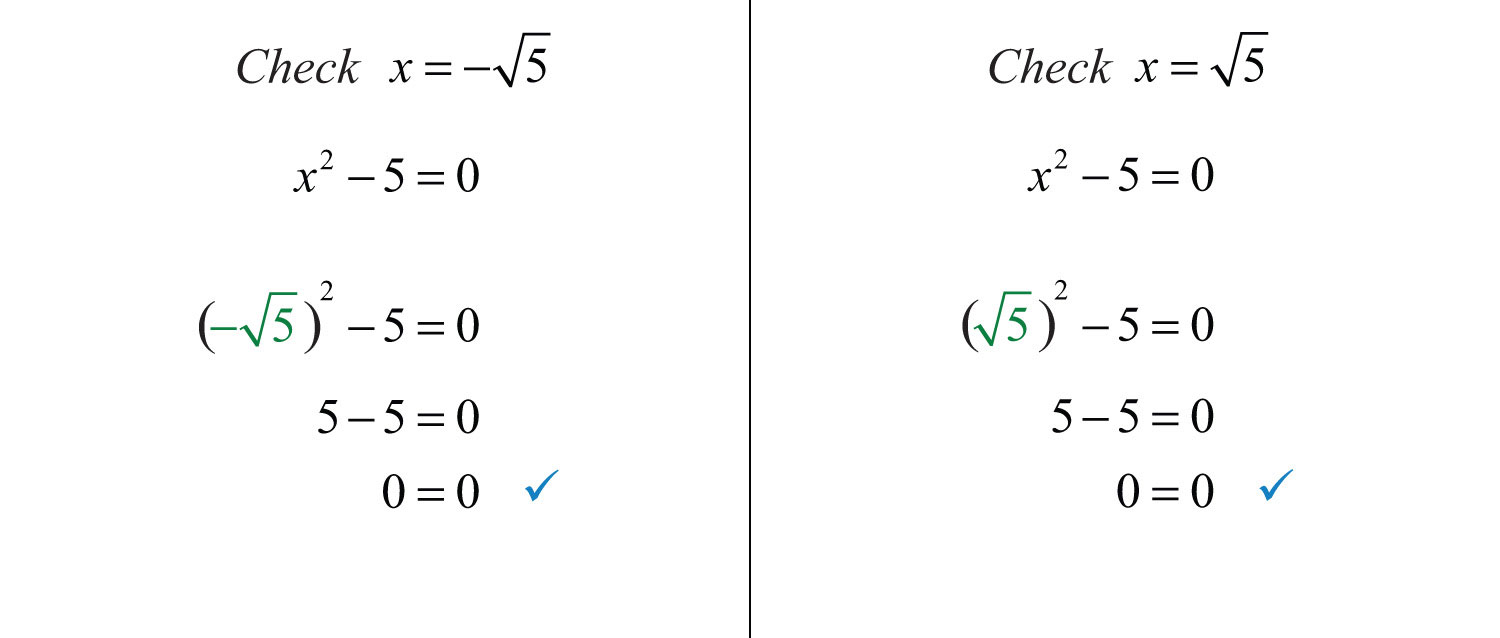
Answer: The solutions are and .
Example 3: Solve: .
Solution: Begin by isolating .

Apply the square root property and then simplify.

Answer: The solutions are and .
Sometimes quadratic equations have no real solution.
Example 4: Solve: .
Solution: Begin by isolating .

After applying the square root property, we are left with the square root of a negative number. Therefore, there is no real solution to this equation.
Answer: No real solution
Reverse this process to find equations with given solutions of the form ±k.
Example 5: Find an equation with solutions and .
Solution: Begin by squaring both sides of the following equation:

Lastly, subtract 12 from both sides and present the equation in standard form.
Answer:
Try this! Solve: .
Answer: or
Video Solution
(click to see video)Consider solving the following equation:

To solve this equation by factoring, first square and then put it in standard form, equal to zero, by subtracting 25 from both sides.

Factor and then apply the zero-product property.

The two solutions are −7 and 3.
When an equation is in this form, we can obtain the solutions in fewer steps by extracting the roots.
Example 6: Solve: .
Solution: Solve by extracting the roots.

At this point, separate the “plus or minus” into two equations and simplify each individually.

Answer: The solutions are −7 and 3.
In addition to fewer steps, this method allows us to solve equations that do not factor.
Example 7: Solve: .
Solution: Begin by isolating the square.

Next, extract the roots and simplify.

Solve for x.
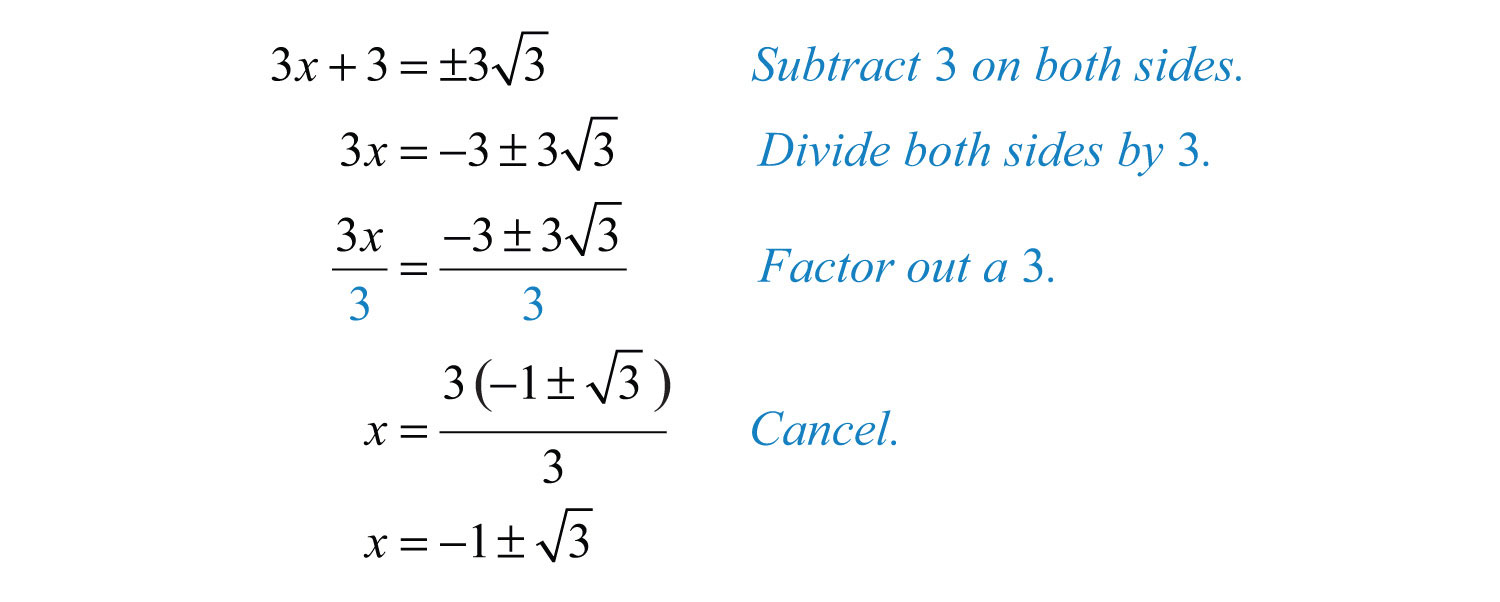
Answer: The solutions are and .
Example 8: Solve: .
Solution: Begin by isolating the square factor.

Apply the square root property and solve.

Answer: The solutions are and .
Try this! Solve: .
Answer:
Video Solution
(click to see video)
Example 9: The length of a rectangle is twice its width. If the diagonal measures 2 feet, then find the dimensions of the rectangle.

Solution:

The diagonal of any rectangle forms two right triangles. Thus the Pythagorean theorem applies. The sum of the squares of the legs of a right triangle is equal to the square of the hypotenuse:

Solve.
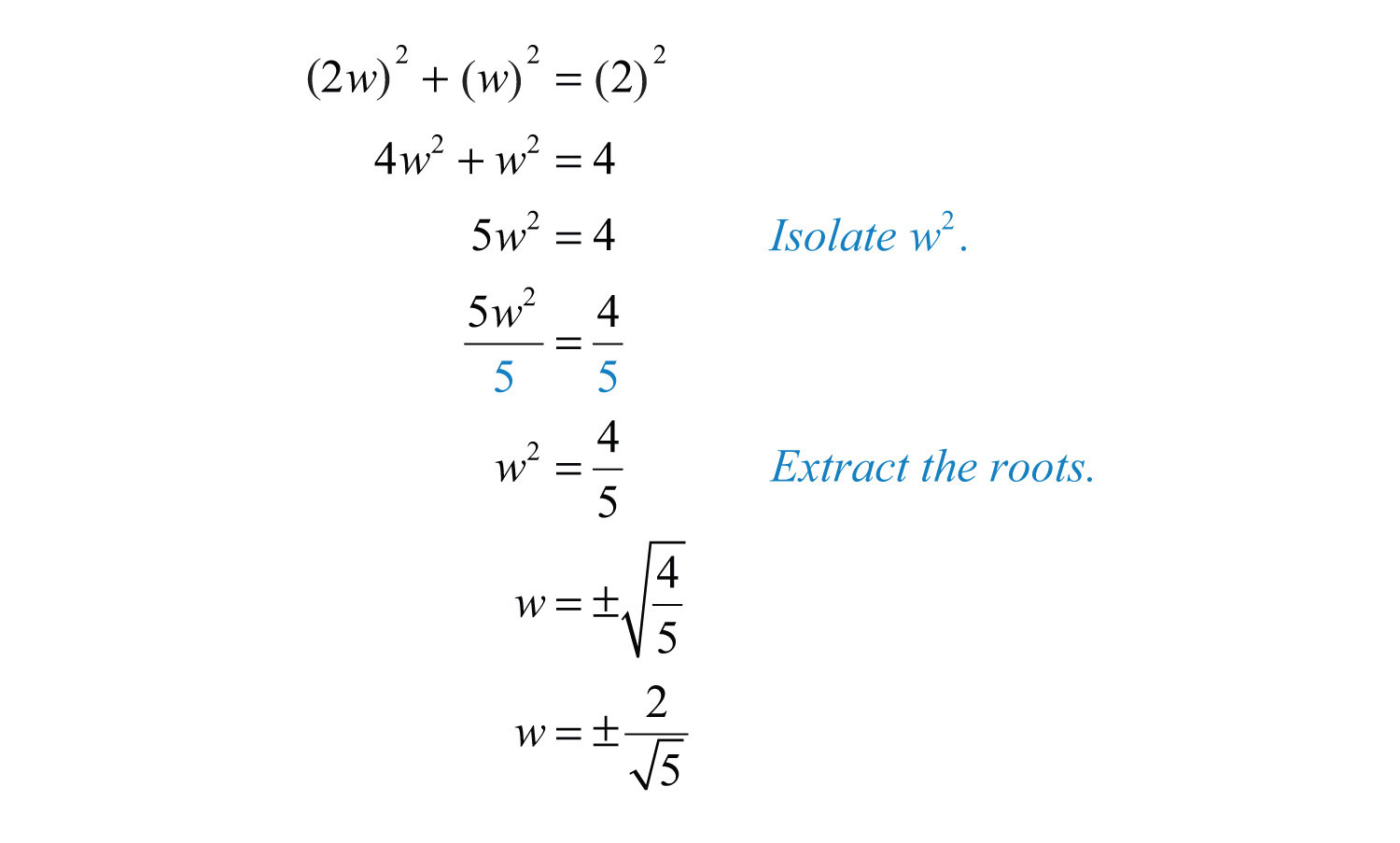
Here we obtain two solutions, and . Since the problem asked for a length of a rectangle, we disregard the negative answer. Furthermore, we will rationalize the denominator and present our solutions without any radicals in the denominator.
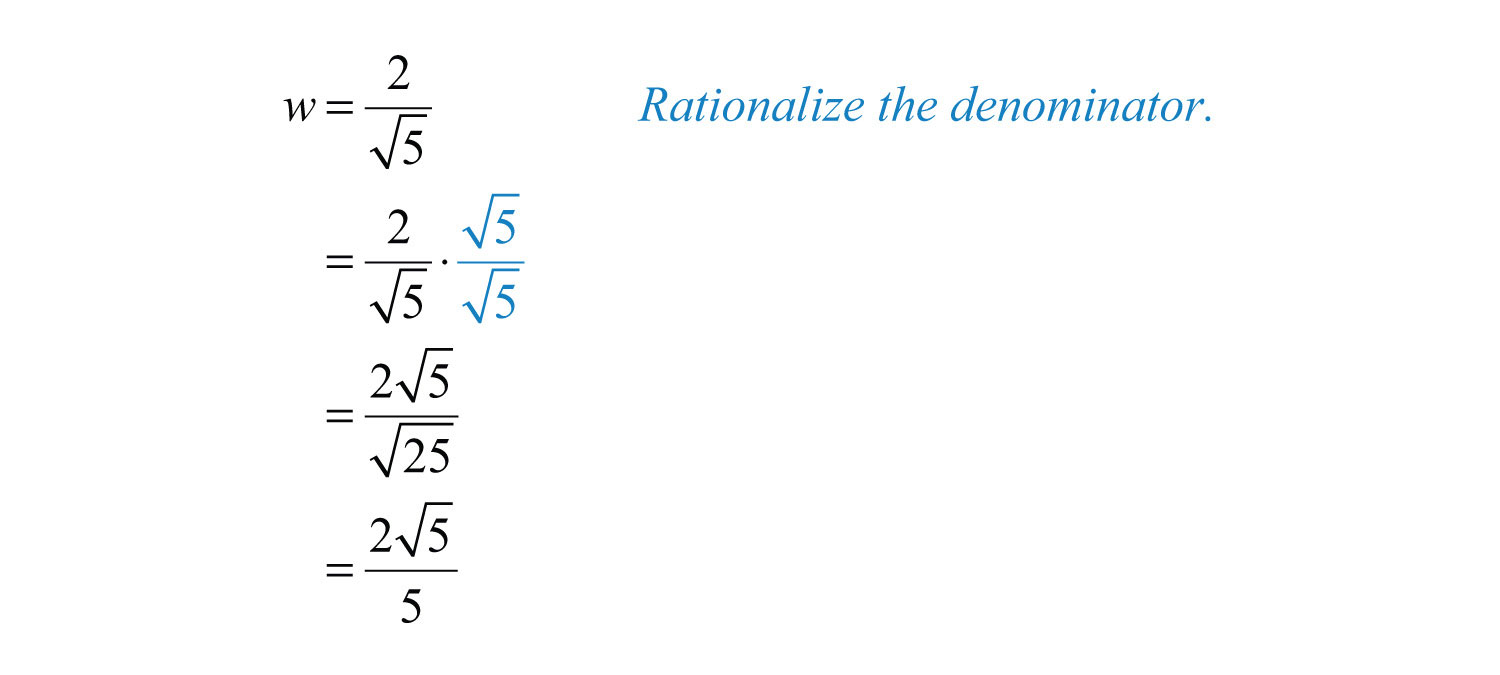
Back substitute to find the length.

Answer: The length of the rectangle is feet and the width is feet.
Key Takeaways
- Solve equations of the form by extracting the roots.
- Extracting roots involves isolating the square and then applying the square root property. After applying the square root property, you have two linear equations that each can be solved. Be sure to simplify all radical expressions and rationalize the denominator if necessary.
Topic Exercises
Part A: Extracting Square Roots
Solve by factoring and then solve by extracting roots. Check answers.
1.
2.
3.
4.
5.
6.
7.
8.
9.
10.
11.
12.
Solve by extracting the roots.
13.
14.
15.
16.
17.
18.
19.
20.
21.
22.
23.
24.
25.
26.
27.
28.
29.
30.
31.
32.
33.
34.
35.
36.
37.
38.
39.
40.
41.
42.
43.
44.
45.
46.
47.
48.
49.
50.
51.
52.
53.
54.
55.
56.
57.
58.
59.
60.
61.
62.
Find a quadratic equation in standard form with the following solutions.
63. ±7
64. ±13
65.
66.
67.
68.
69.
70.
Solve and round off the solutions to the nearest hundredth.
71.
72.
73.
74.
75.
76.
77.
78.
Set up an algebraic equation and use it to solve the following.
79. If 9 is subtracted from 4 times the square of a number, then the result is 3. Find the number.
80. If 20 is subtracted from the square of a number, then the result is 4. Find the number.
81. If 1 is added to 3 times the square of a number, then the result is 2. Find the number.
82. If 3 is added to 2 times the square of a number, then the result is 12. Find the number.
83. If a square has an area of 8 square centimeters, then find the length of each side.
84. If a circle has an area of square centimeters, then find the length of the radius.
85. The volume of a right circular cone is cubic centimeters when the height is 6 centimeters. Find the radius of the cone. (The volume of a right circular cone is given by .)
86. The surface area of a sphere is square centimeters. Find the radius of the sphere. (The surface area of a sphere is given by .)
87. The length of a rectangle is 6 times its width. If the area is 96 square inches, then find the dimensions of the rectangle.
88. The base of a triangle is twice its height. If the area is 16 square centimeters, then find the length of its base.
89. A square has an area of 36 square units. By what equal amount will the sides have to be increased to create a square with double the given area?
90. A circle has an area of square units. By what amount will the radius have to be increased to create a circle with double the given area?
91. If the sides of a square measure 1 unit, then find the length of the diagonal.
92. If the sides of a square measure 2 units, then find the length of the diagonal.
93. The diagonal of a square measures 5 inches. Find the length of each side.
94. The diagonal of a square measures 3 inches. Find the length of each side.
95. The length of a rectangle is twice its width. If the diagonal measures 10 feet, then find the dimensions of the rectangle.
96. The length of a rectangle is twice its width. If the diagonal measures 8 feet, then find the dimensions of the rectangle.
97. The length of a rectangle is 3 times its width. If the diagonal measures 5 meters, then find the dimensions of the rectangle.
98. The length of a rectangle is 3 times its width. If the diagonal measures 2 feet, then find the dimensions of the rectangle.
99. The height in feet of an object dropped from a 9‑foot ladder is given by , where t represents the time in seconds after the object has been dropped. How long does it take the object to hit the ground? (Hint: The height is 0 when the object hits the ground.)
100. The height in feet of an object dropped from a 20‑foot platform is given by , where t represents the time in seconds after the object has been dropped. How long does it take the object to hit the ground?
101. The height in feet of an object dropped from the top of a 144-foot building is given by , where t is measured in seconds.
a. How long will it take to reach half of the distance to the ground, 72 feet?
b. How long will it take to travel the rest of the distance to the ground?
Round off to the nearest hundredth of a second.
102. The height in feet of an object dropped from an airplane at 1,600 feet is given by , where t is in seconds.
a. How long will it take to reach half of the distance to the ground?
b. How long will it take to travel the rest of the distance to the ground?
Round off to the nearest hundredth of a second.
Part B: Discussion Board
103. Create an equation of your own that can be solved by extracting the root. Share it, along with the solution, on the discussion board.
104. Explain why the technique of extracting roots greatly expands our ability to solve quadratic equations.
105. Explain in your own words how to solve by extracting the roots.
106. Derive a formula for the diagonal of a square in terms of its sides.
Answers
1: −6, 6
3: −3/2, 3/2
5: 1, 3
7: 1/2, 7/2
9: −1, 3
11: 0, 10
13: ±4
15: ±3
17: ±1/2
19: ±0.5
21:
23: ±3/4
25:
27: ±10
29: No real solution
31: ±2/3
33: ±0.3
35:
37:
39: No real solution
41:
43:
45:
47: −9, −5
49: −3, 6
51:
53:
55:
57:
59: No real solution
61:
63:
65:
67:
69:
71: ±0.33
73: ±5.66
75: ±7.94
77: ±3.61
79: or
81: or
83: centimeters
85: centimeters
87: Length: 24 inches; width: 4 inches
89: units
91: units
93: inches
95: Length: feet; width: feet
97: Length: meters; width: meters
99: 3/4 second
101: a. 2.12 seconds; b. 0.88 second
9.2 Completing the Square
Learning Objective
- Solve quadratic equations by completing the square.
Completing the Square
In this section, we will devise a method for rewriting any quadratic equation of the form

in the form

This process is called completing the squareThe process of rewriting a quadratic equation in the form .. As we have seen, quadratic equations in this form can easily be solved by extracting roots. We begin by examining perfect square trinomials:

The last term, 9, is the square of one-half of the coefficient of x. In general, this is true for any perfect square trinomial of the form .

In other words, any trinomial of the form will be a perfect square trinomial if

Note
It is important to point out that the leading coefficient must be equal to 1 for this to be true.
Example 1: Complete the square: .
Solution: In this example, the coefficient of the middle term b = 8, so find the value that completes the square as follows:

The value that completes the square is 16.

Answer:
Example 2: Complete the square: .
Solution: Here b = 3, so find the value that will complete the square as follows:

The value 9/4 completes the square:

Answer:
We can use this technique to solve quadratic equations. The idea is to take any quadratic equation in standard form and complete the square so that we can solve it by extracting roots. The following are general steps for solving a quadratic equation with a leading coefficient of 1 in standard form by completing the square.
Example 3: Solve by completing the square: .
Solution:
Step 1: Add or subtract the constant term to obtain the equation in the form . In this example, subtract 46 to move it to the right side of the equation.

Step 2: Use to determine the value that completes the square. Here b = 14:

Step 3: Add to both sides of the equation and complete the square.

Step 4: Solve by extracting roots.

Answer: The solutions are or . The check is optional.
Example 4: Solve by completing the square: .
Solution: Begin by subtracting 72 from both sides.

Next, find the value that completes the square using b = −18.

To complete the square, add 81 to both sides, complete the square, and then solve by extracting the roots.
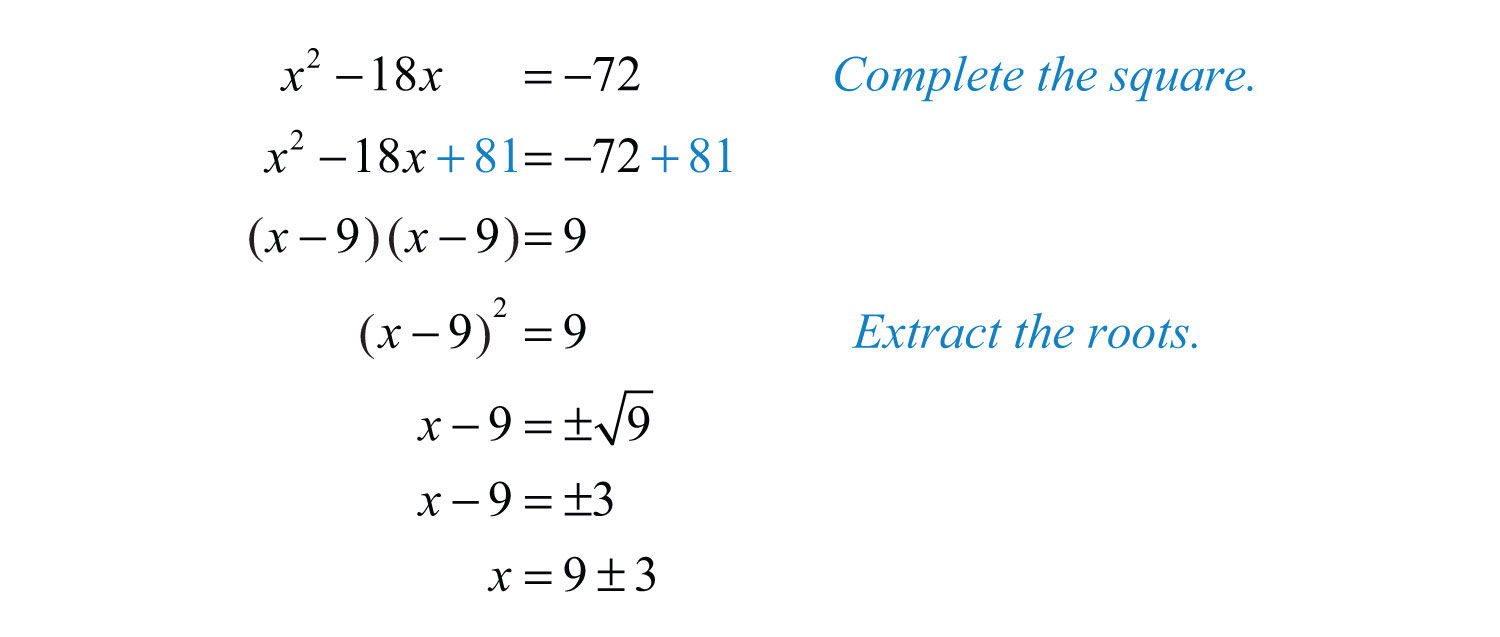
At this point, separate the “plus or minus” into two equations and solve each.

Answer: The solutions are 6 and 12.
Note that in the previous example the solutions are integers. If this is the case, then the original equation will factor.

If it factors, we can solve it by factoring. However, not all quadratic equations will factor.
Example 5: Solve by completing the square: .
Solution: Begin by subtracting 1 from both sides of the equation.

Here b = 10, and we determine the value that completes the square as follows:

To complete the square, add 25 to both sides of the equation.

Factor and then solve by extracting roots.
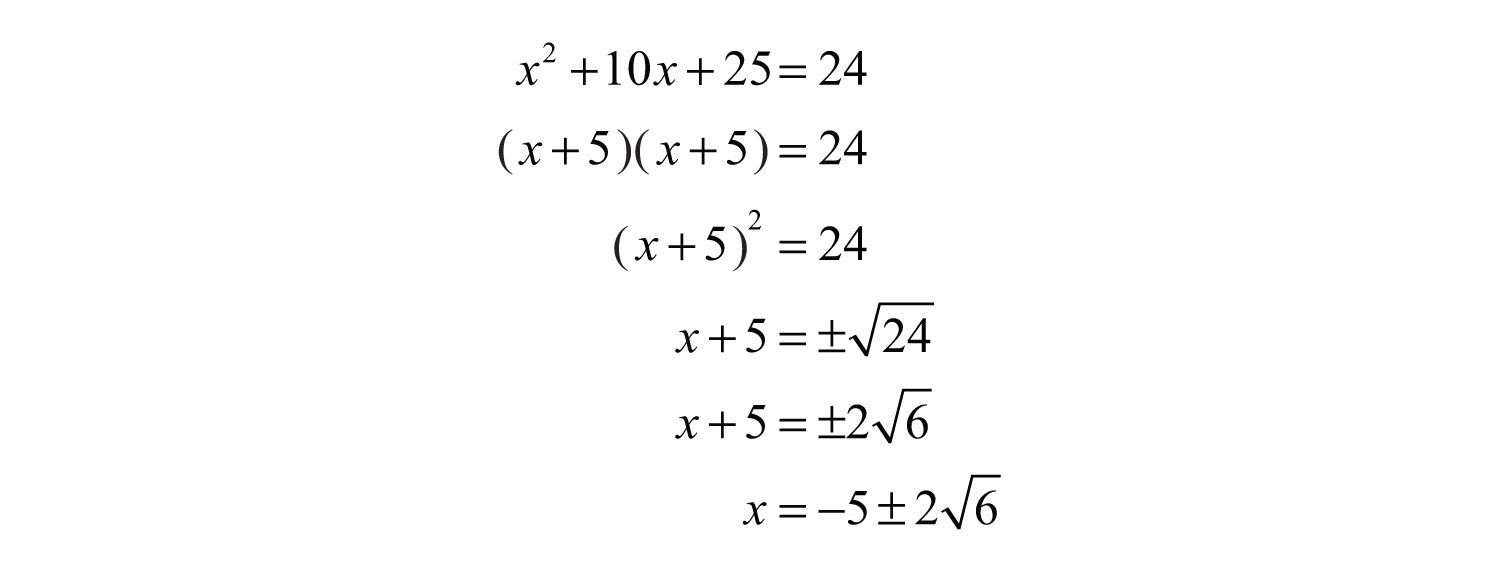
Answer: The solutions are and .
Sometimes quadratic equations do not have real solutions.
Example 6: Solve by completing the square: .
Solution: Begin by subtracting 3 from both sides of the equation.

Here b = −2, and we have

Therefore,

At this point we see that extracting the root leads to the square root of a negative number.

Answer: No real solution
Try this! Solve by completing the square: .
Answer:
Video Solution
(click to see video)The coefficient of x is not always divisible by 2.
Example 7: Solve by completing the square: .
Solution: Begin by adding 2 to both sides.

Use b = 3 to find the value that completes the square:

To complete the square, add 9/4 to both sides of the equation.
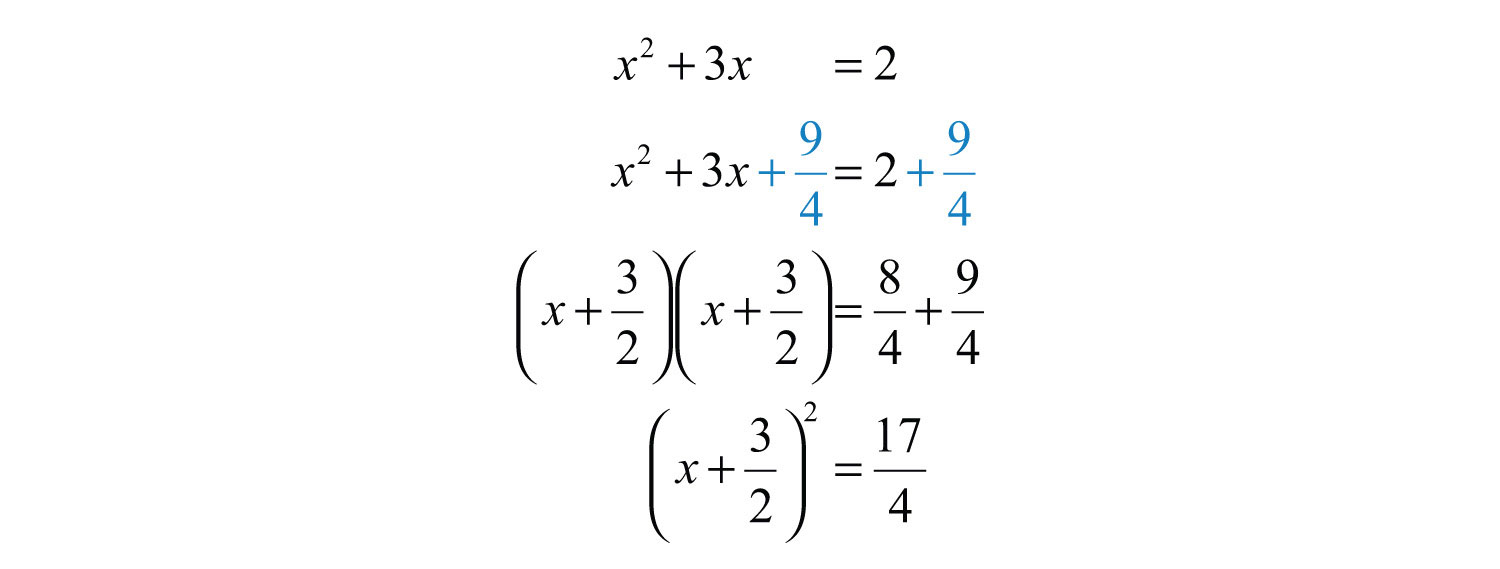
Solve by extracting roots.
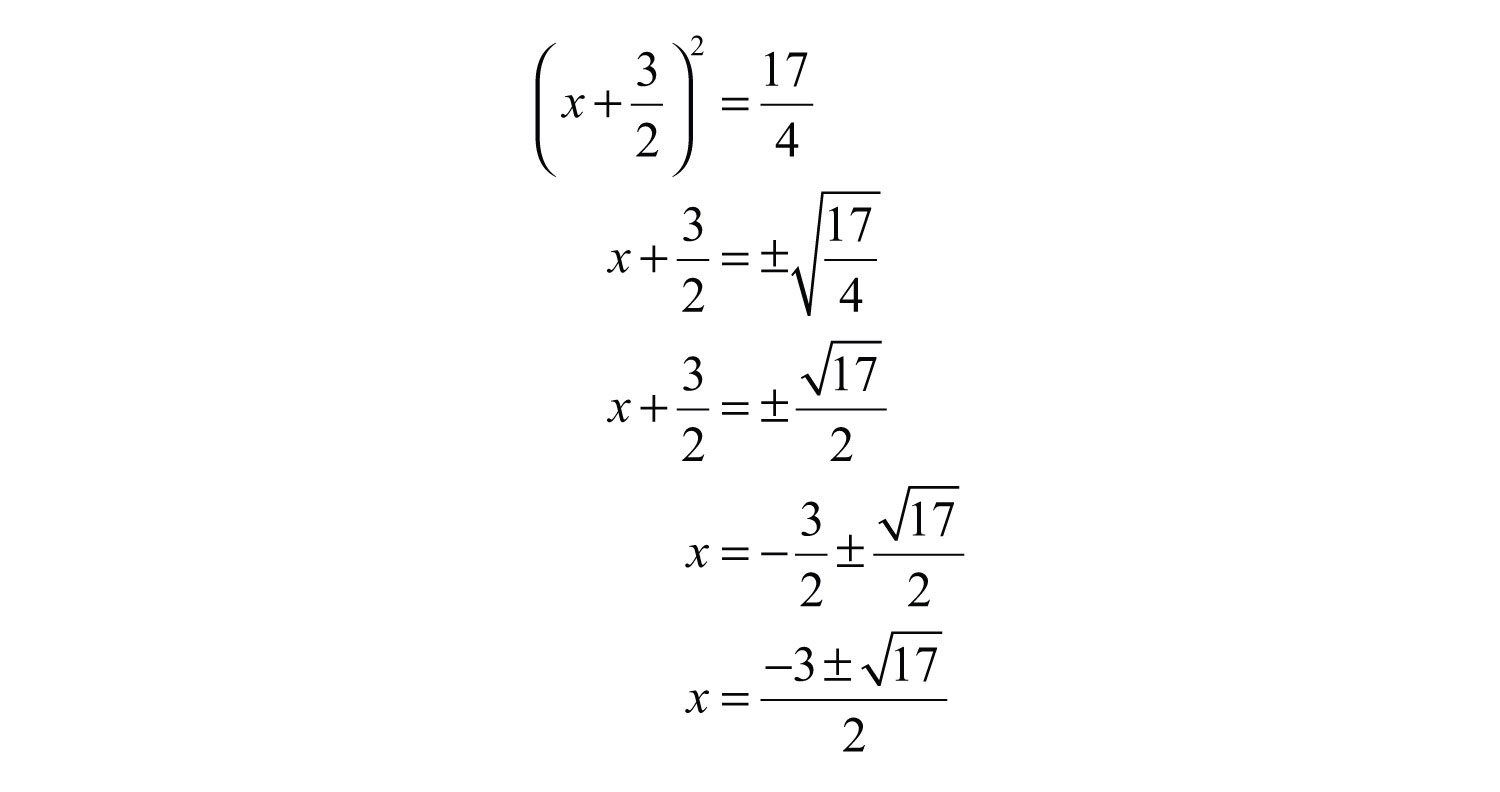
Answer: The solutions are .
So far, all of the examples have had a leading coefficient of 1. The formula determines the value that completes the square only if the leading coefficient is 1. If this is not the case, then simply divide both sides by the leading coefficient.
Example 8: Solve by completing the square: .
Solution: Notice that the leading coefficient is 2. Therefore, divide both sides by 2 before beginning the steps required to solve by completing the square.

Begin by adding 1/2 to both sides of the equation.

Here b = 5/2, and we can find the value that completes the square as follows:

To complete the square, add 25/16 to both sides of the equation.
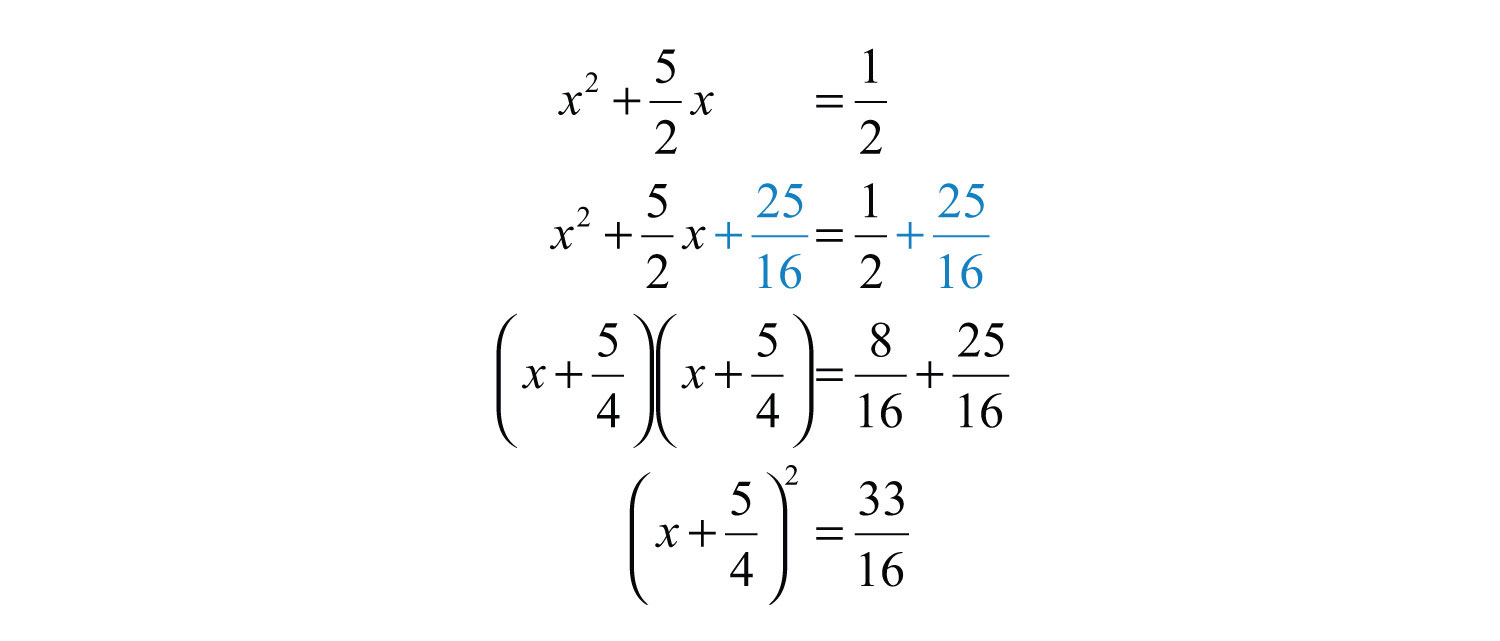
Next, solve by extracting roots.
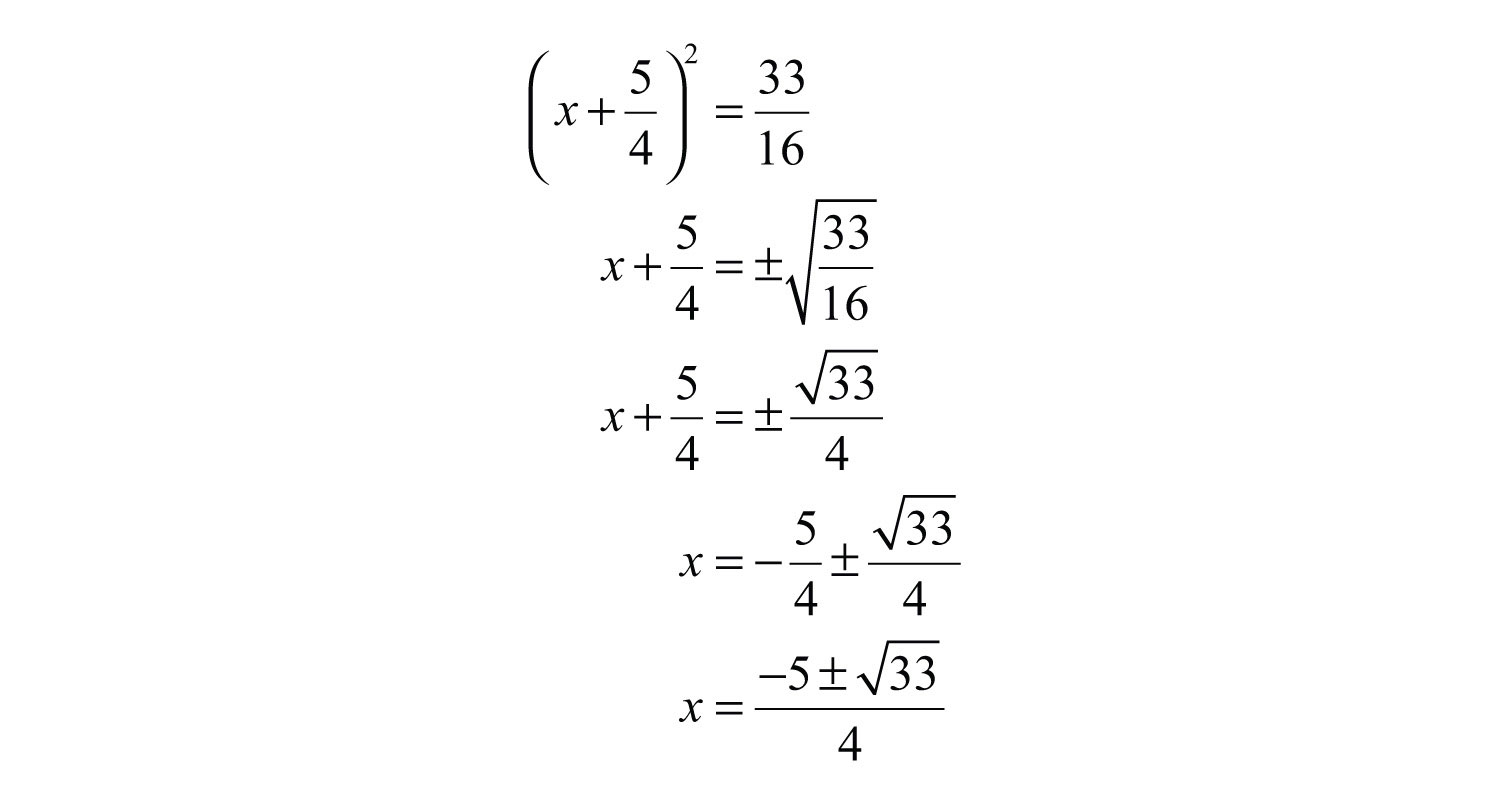
Answer: The solutions are .
Try this! Solve: .
Answer:
Video Solution
(click to see video)Key Takeaways
- Solve any quadratic equation by completing the square.
- You can apply the square root property to solve an equation if you can first convert the equation to the form .
- To complete the square, first make sure the equation is in the form . Then add the value to both sides and factor.
- The process for completing the square always works, but it may lead to some tedious calculations with fractions. This is the case when the middle term, b, is not divisible by 2.
Topic Exercises
Part A: Completing the Square
Complete the square.
1.
2.
3.
4.
5.
6.
7.
8.
9.
10.
Solve by factoring and then solve by completing the square. Check answers.
11.
12.
13.
14.
15.
16.
17.
18.
19.
20.
Solve by completing the square.
21.
22.
23.
24.
25.
26.
27.
28.
29.
30.
31.
32.
33.
34.
35.
36.
37.
38.
39.
40.
41.
42.
43.
44.
45.
46.
47.
48.
49.
50.
51.
52.
53.
54.
55.
56.
57.
58.
59.
60.
61.
62.
63.
64.
65.
66.
67.
68.
Solve by completing the square and round off the solutions to the nearest hundredth.
69.
70.
71.
72.
73.
74.
Part B: Discussion Board
75. Research and discuss the Hindu method for completing the square.
76. Explain why the technique for completing the square described in this section requires that the leading coefficient be equal to 1.
Answers
1:
3:
5:
7:
9:
11: −4, 2
13: −6, 4
15: −7, 4
17: 1/2, −2
19: −1/2, 1
21:
23:
25: No real solution
27: −15, 5
29:
31:
33: −0.3, 0.9
35: −1/3, 1
37:
39:
41: No real solution
43:
45:
47: −0.05, 1.75
49:
51:
53:
55:
57: No real solution
59:
61:
63:
65:
67:
69: 0.19, 1.31
71: −0.45, 1.12
73: 0.33, 0.67
9.3 Quadratic Formula
Learning Objective
- Solve quadratic equations with real solutions using the quadratic formula.
The Quadratic Formula
In this section, we will develop a formula that gives the solutions to any quadratic equation in standard form. To do this, we begin with a general quadratic equation in standard form and solve for x by completing the square. Here a, b, and c are real numbers and :

Determine the constant that completes the square: take the coefficient of x, divide it by 2, and then square it.

Add this to both sides of the equation and factor.
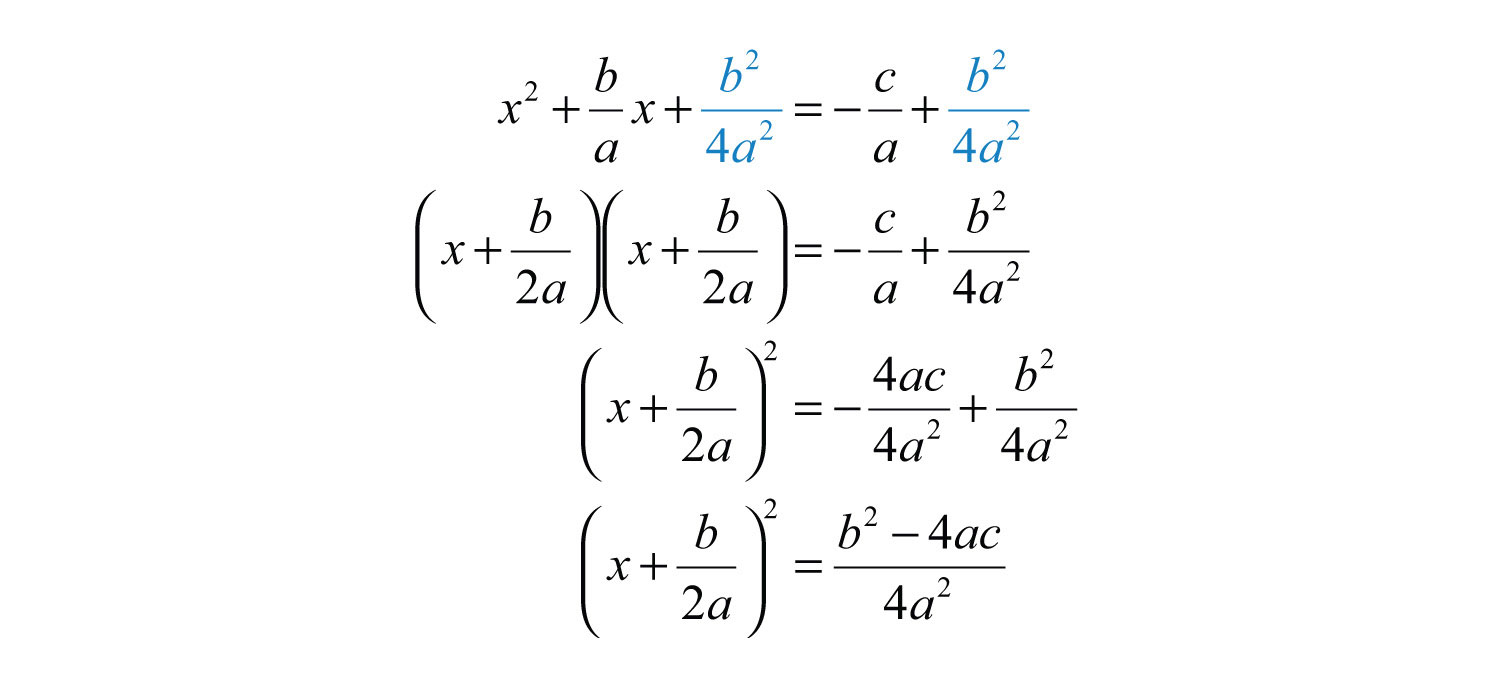
Solve by extracting roots.
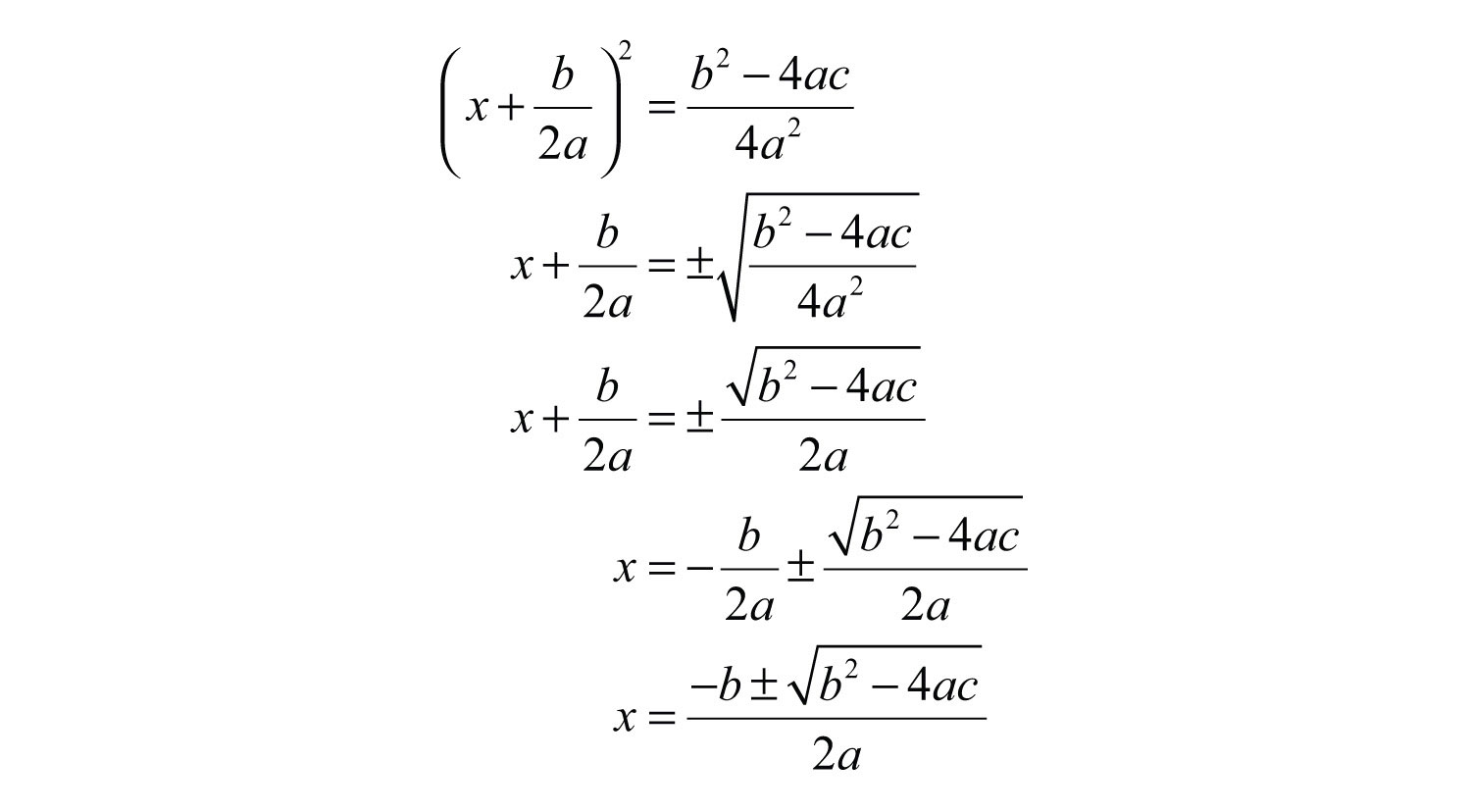
This derivation gives us a formula that solves any quadratic equation in standard form. Given , where a, b, and c are real numbers and , then the solutions can be calculated using the quadratic formulaThe formula , which gives the solutions to any quadratic equation in the form , where a, b, and c are real numbers and .:

Consider the quadratic equation . It can be solved by factoring as follows:
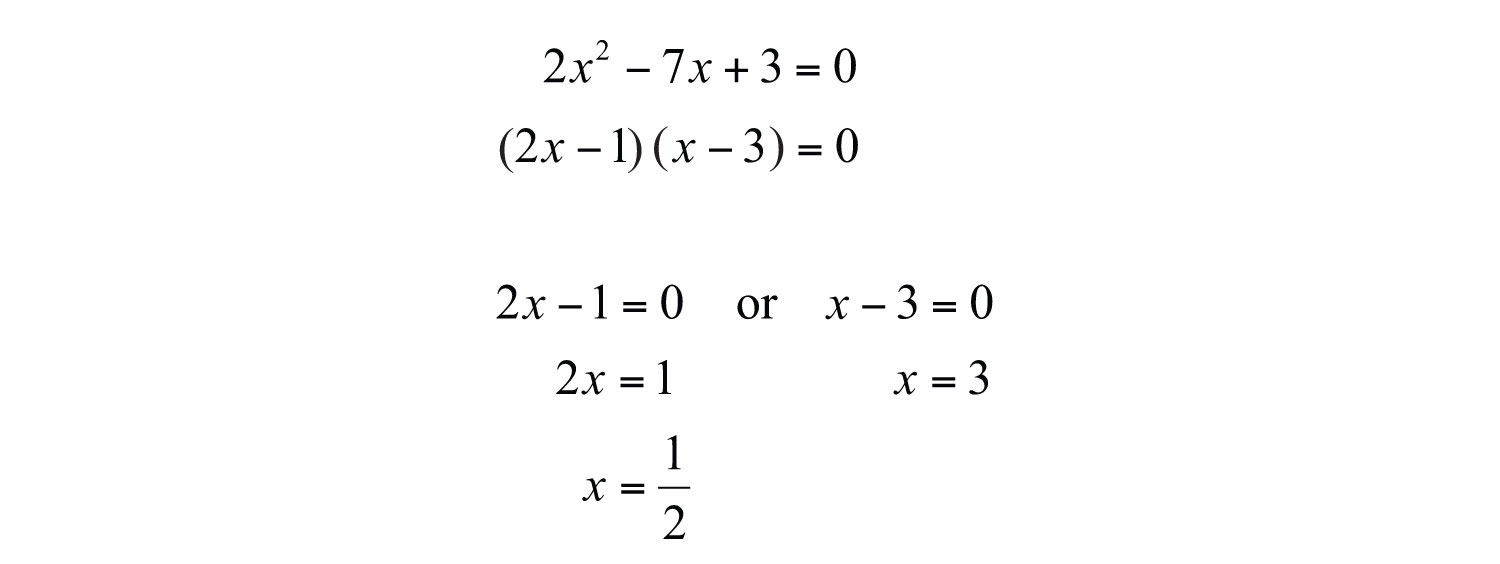
The solutions are 1/2 and 3. The following example shows that we can obtain the same results using the quadratic formula.
Example 1: Solve using the quadratic formula: .
Solution: Begin by identifying a, b, and c as the coefficients of each term.

Substitute these values into the quadratic formula and then simplify.
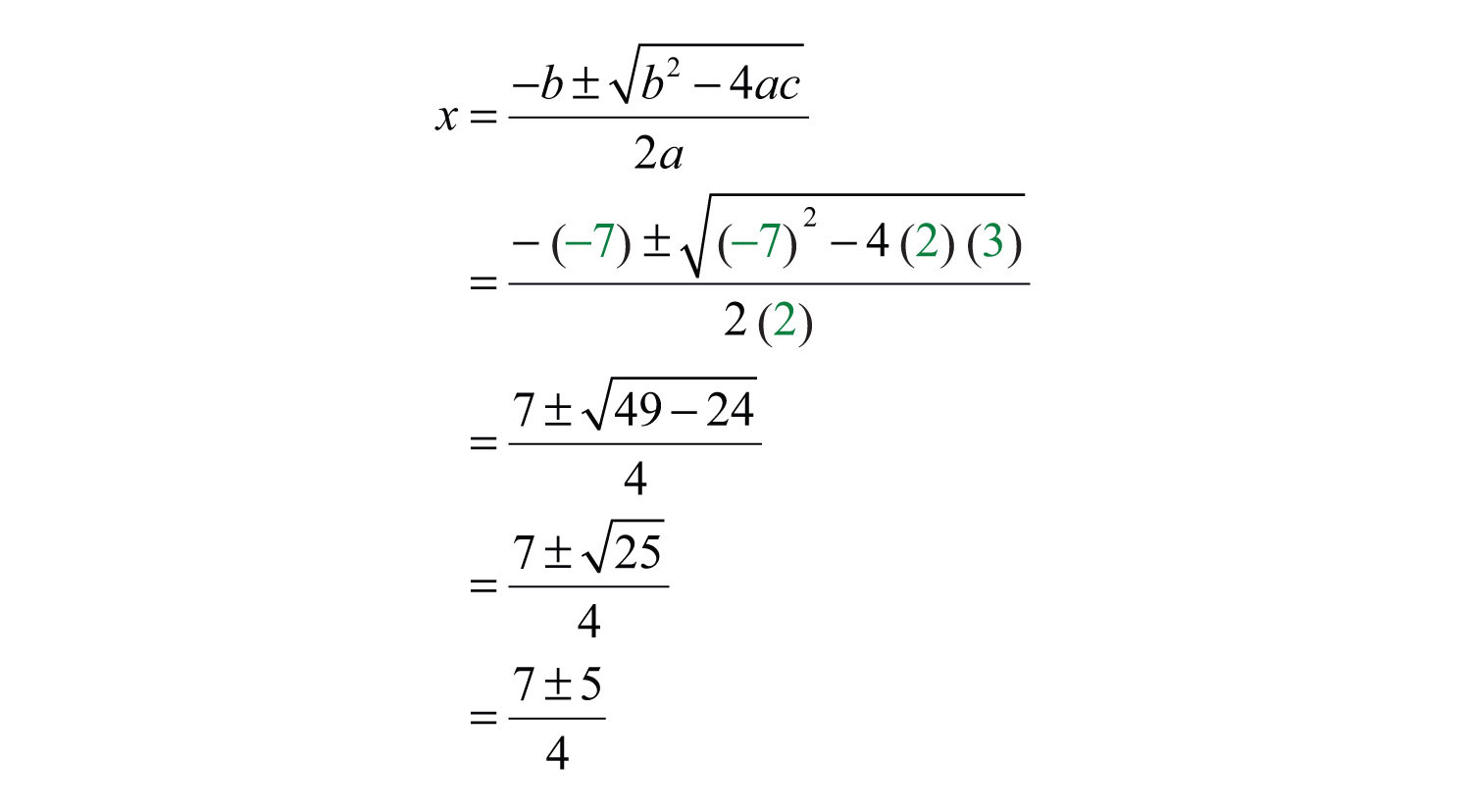
Separate the “plus or minus” into two equations and simplify each individually.

Answer: The solutions are 1/2 and 3.
Of course, if the quadratic factors, then it is a best practice to solve it by factoring. However, not all quadratic polynomials factor; nevertheless, the quadratic formula provides us with a means to solve such equations.
Example 2: Solve using the quadratic formula: .
Solution: Begin by identifying a, b, and c.

Substitute these values into the quadratic formula.
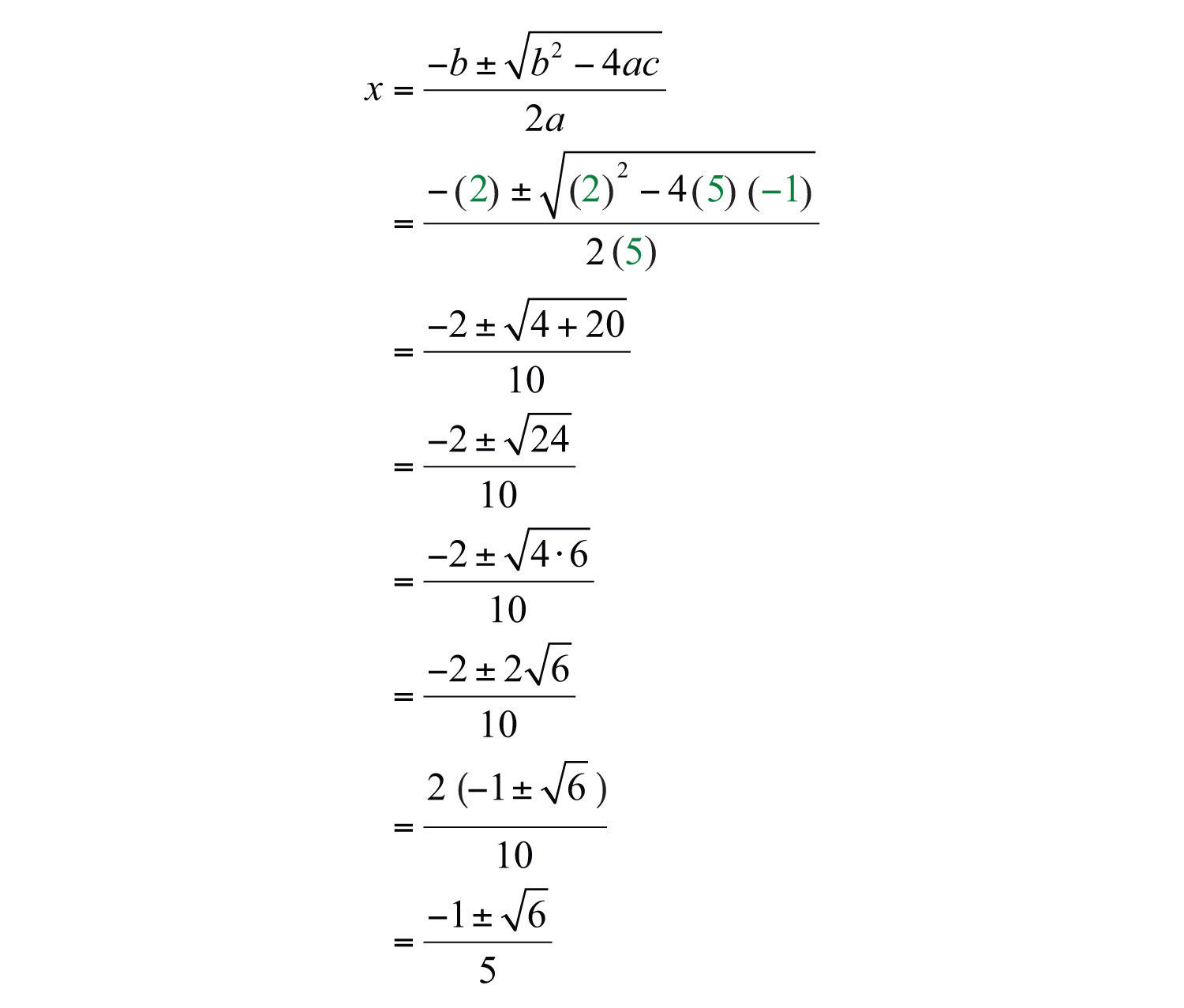
Answer: The solutions are .
Often terms are missing. When this is the case, use 0 as the coefficient.
Example 3: Solve using the quadratic formula: .
Solution: Think of this equation with the following coefficients:

Here

Substitute these values into the quadratic formula.
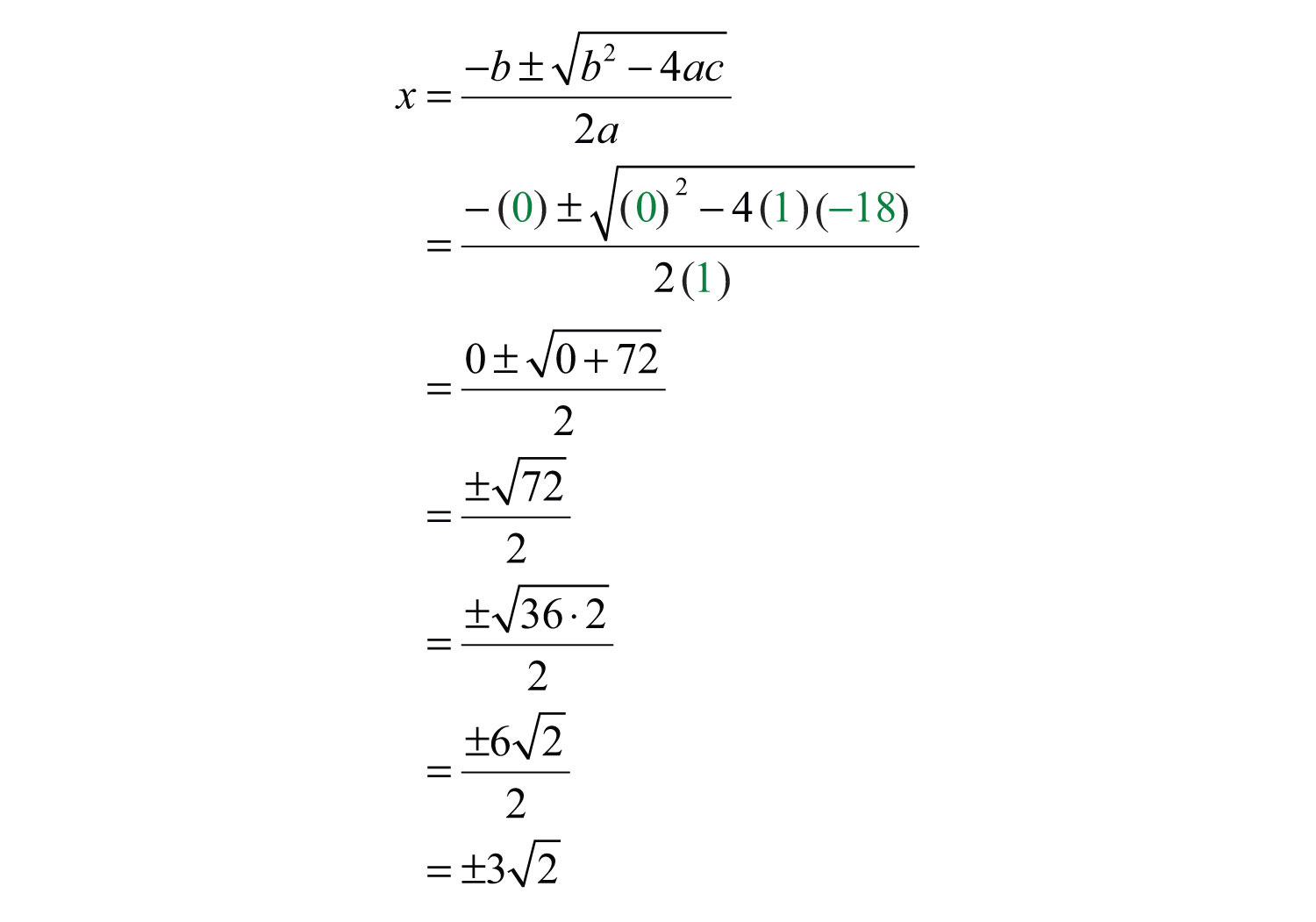
Answer: The solutions are .
Since the coefficient of x was 0, we could have solved the equation by extracting the roots. As an exercise, solve the previous example using this method and verify that the results are the same.
Example 4: Solve using the quadratic formula: .
Solution: In this case,

Substitute these values into the quadratic formula and then simplify.
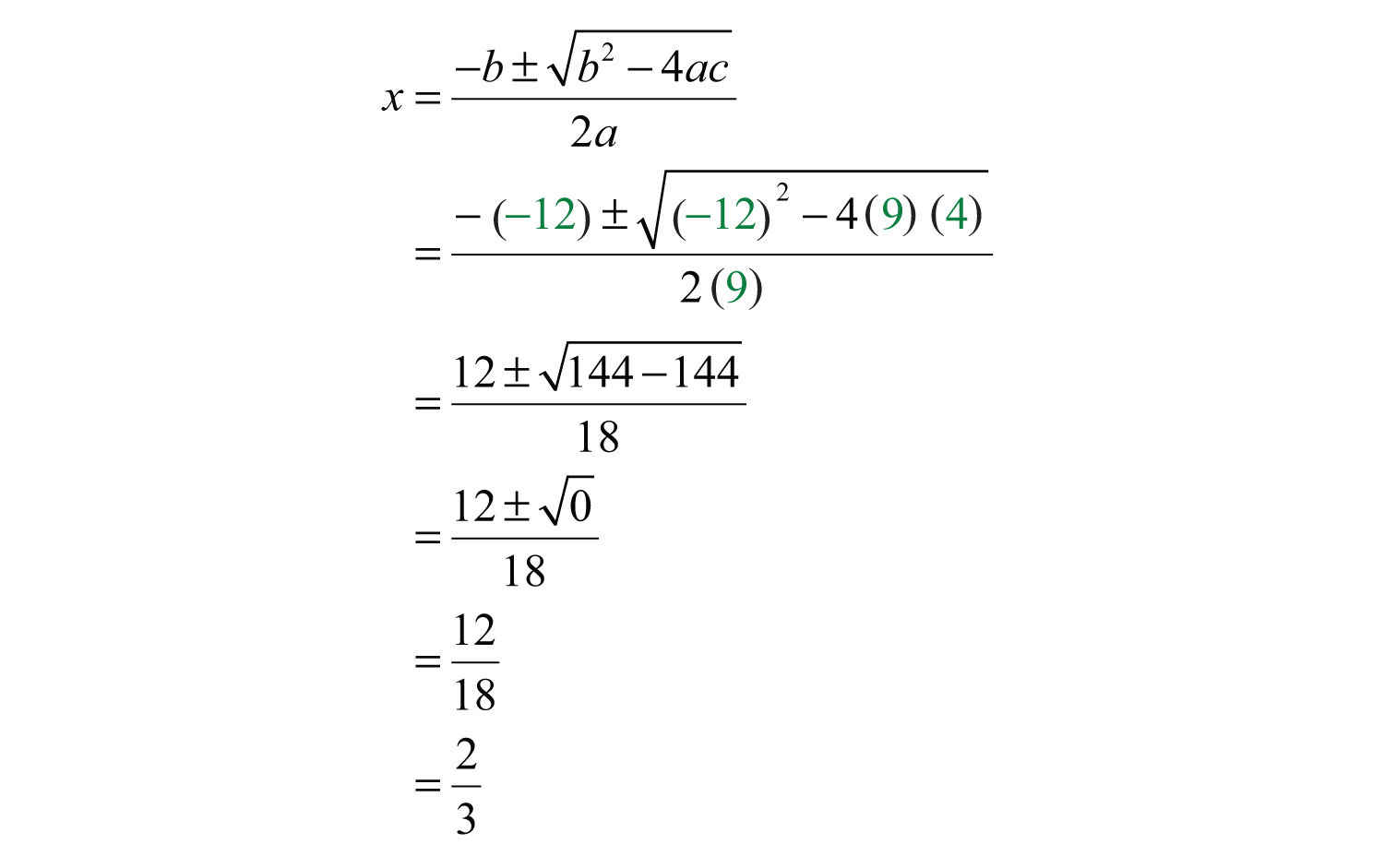
In this example, notice that the radicand of the square root is 0. This results in only one solution to this quadratic equation. Normally, we expect two solutions. When we find only one solution, the solution is called a double root. If we solve this equation by factoring, then the solution appears twice.
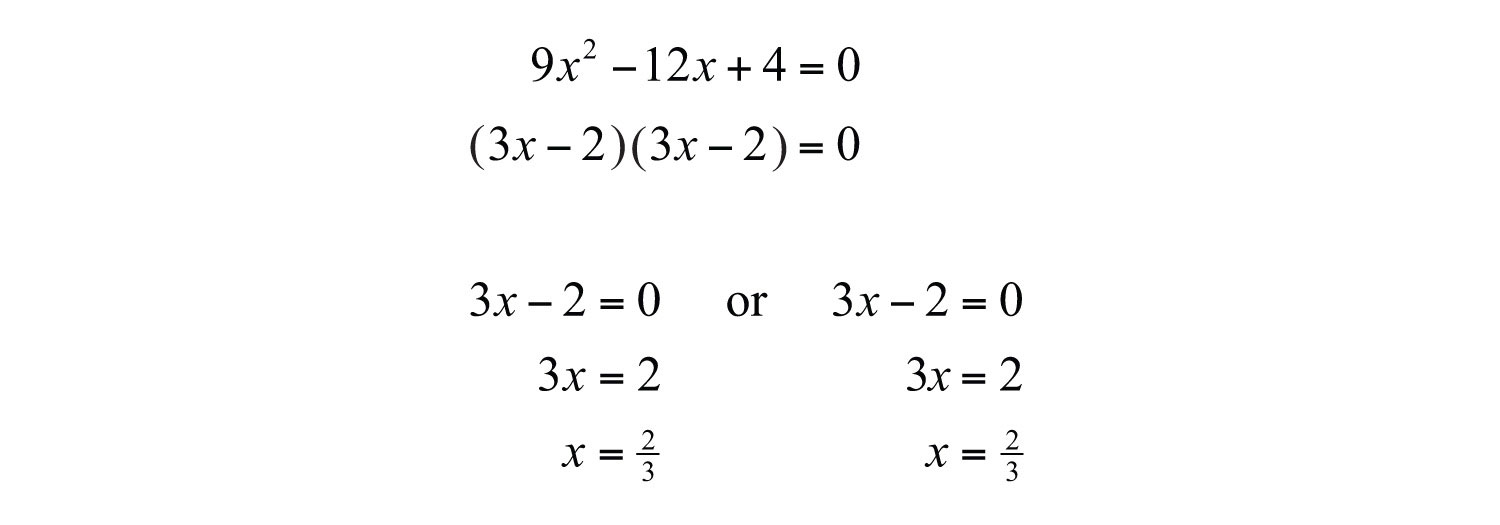
Answer: 2/3, double root
Example 5: Solve using the quadratic formula: .
Solution: In this case,

Substitute these values into the quadratic formula.
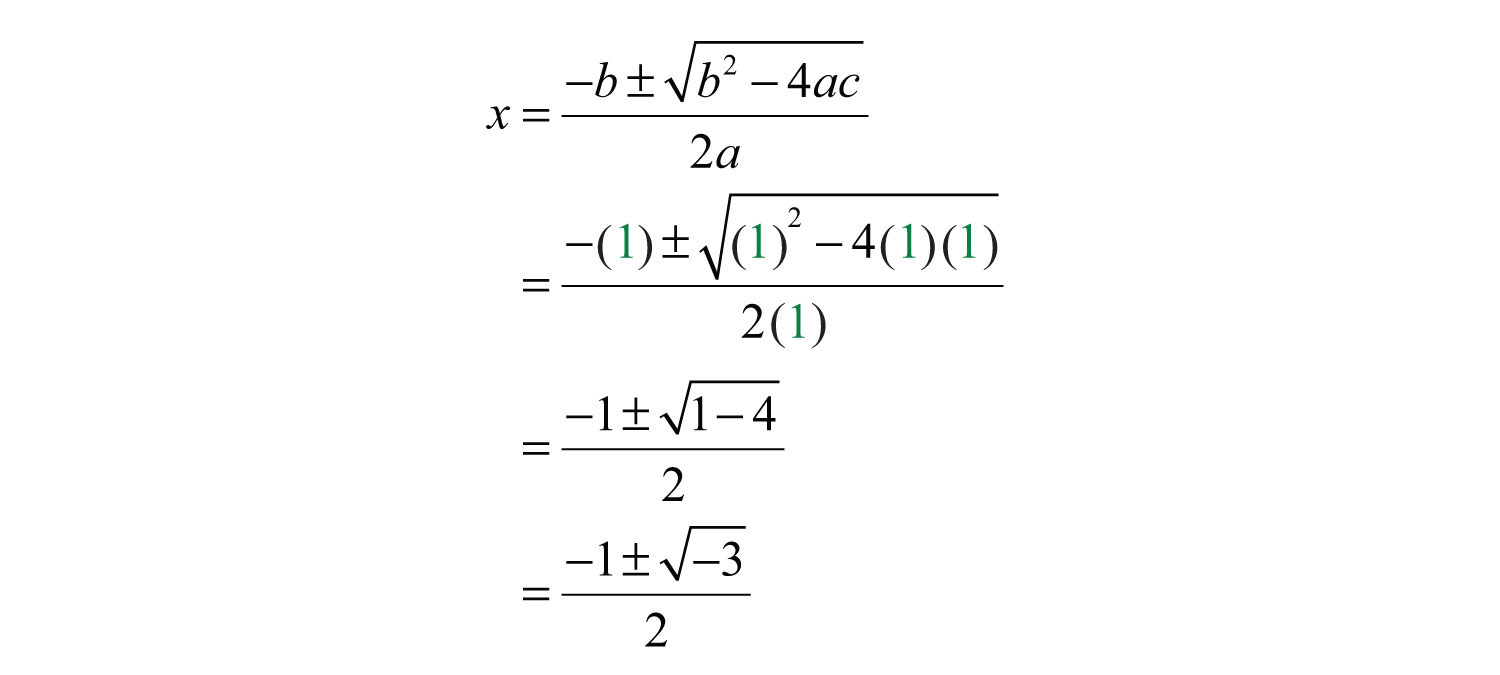
The solution involves the square root of a negative number; hence the solutions are not real. This quadratic equation has two nonreal solutions and will be discussed in further detail as we continue in our study of algebra. For now, simply state that the equation does not have real solutions.
Answer: No real solutions
Try this! Solve: .
Answer:
Video Solution
(click to see video)It is important to place the quadratic equation in standard form before using the quadratic formula.
Example 6: Solve using the quadratic formula: .
Solution: Begin by using the distributive property to expand the left side and combining like terms to obtain an equation in standard form, equal to 0.

Once the equation is in standard form, identify a, b, and c. Here

Substitute these values into the quadratic formula and then simplify.
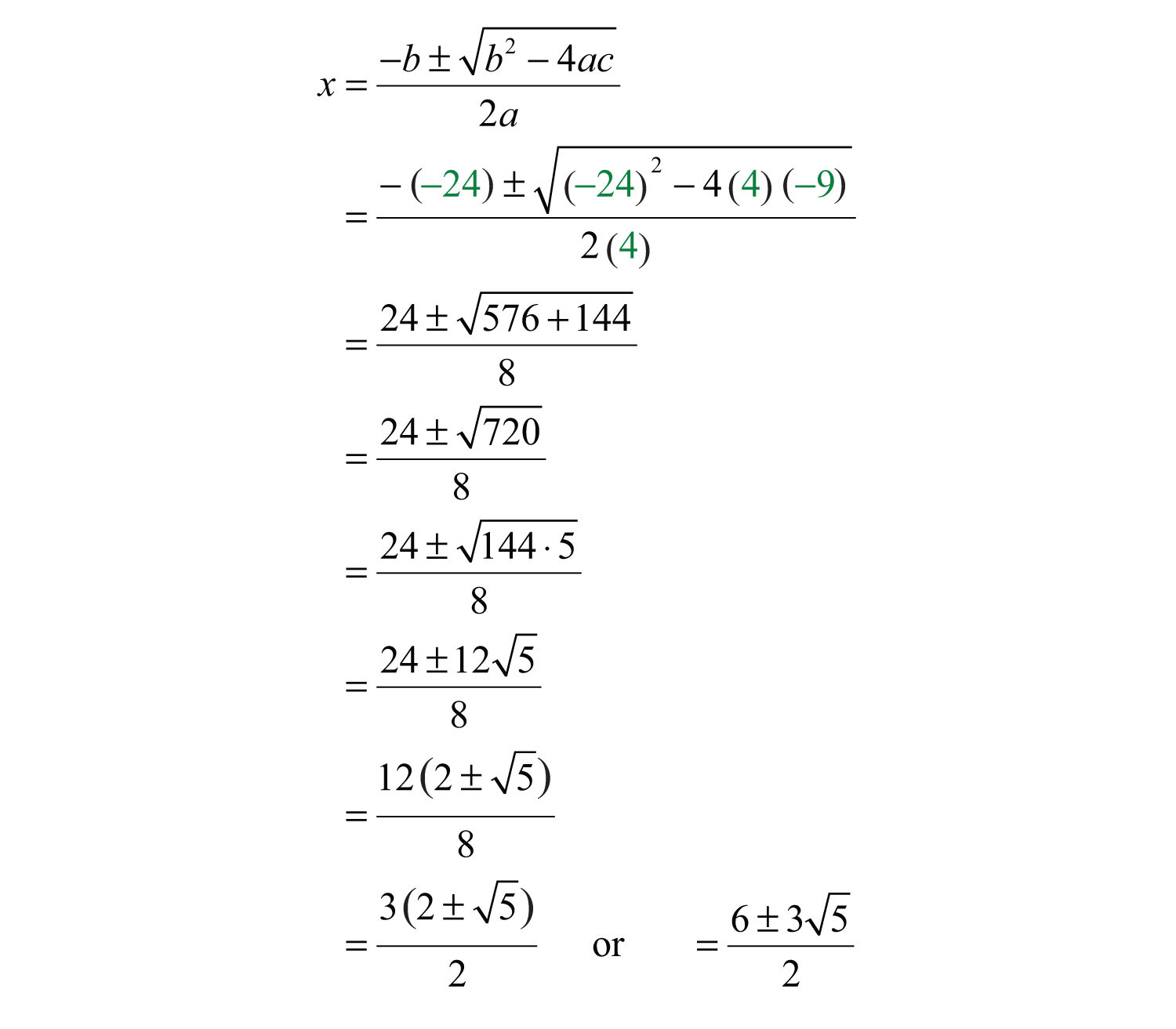
Answer: The solutions are .
Try this! Solve: .
Answer:
Video Solution
(click to see video)Key Takeaways
- Use the quadratic formula to solve any quadratic equation in standard form.
- To solve any quadratic equation, first rewrite in standard form, , substitute the appropriate coefficients into the quadratic formula, , and then simplify.
Topic Exercises
Part A: Quadratic Formula
Identify the coefficients a, b, and c used in the quadratic formula. Do not solve.
1.
2.
3.
4.
5.
6.
7.
8.
9.
10.
Solve by factoring and then solve using the quadratic formula. Check answers.
11.
12.
13.
14.
15.
16.
17.
18.
19.
20.
Use the quadratic formula to solve the following.
21.
22.
23.
24.
25.
26.
27.
28.
29.
30.
31.
32.
33.
34.
35.
36.
37.
38.
39.
40.
41.
42.
43.
44.
45.
46.
47.
48.
49.
50.
51.
52.
53.
54.
55.
56.
57.
58.
59.
60.
61.
62.
63.
64.
65.
66.
67.
68.
69.
70.
71.
72.
73.
74.
Part B: Discussion Board
75. When talking about a quadratic equation in standard form, , why is it necessary to state that ? What happens if a is equal to 0?
76. Research and discuss the history of the quadratic formula and solutions to quadratic equations.
Answers
1: , , and
3: , , and
5: , , and
7: , , and
9: , , and
11: 4, 6
13: −5, −1
15: −1/2, 4
17: −3/2, 1
19: 1, double root
21:
23:
25:
27:
29:
31:
33: 3/2, double root
35:
37:
39:
41:
43: No real solutions
45: 0, double root
47: 0, 5/2
49: 0, 1
51: −0.3, 0.9
53: −0.1, 1.5
55:
57:
59:
61:
63:
65:
67: No real solutions
69: 1/5, double root
71: −4/3, 1/9
73:
9.4 Guidelines for Solving Quadratic Equations and Applications
Learning Objectives
- Use the discriminant to determine the number and type of solutions to any quadratic equation.
- Develop a general strategy for solving quadratic equations.
- Solve applications involving quadratic equations.
Discriminant
If given a quadratic equation in standard form, , where a, b, and c are real numbers and , then the solutions can be calculated using the quadratic formula:

The solutions are rational, irrational, or not real. We can determine the type and number of solutions by studying the discriminantThe expression inside the radical of the quadratic formula, ., the expression inside the radical, . If the value of this expression is negative, then the equation has no real solutions. If the discriminant is positive, then we have two real solutions. And if the discriminant is 0, then we have one real solution.
Example 1: Determine the type and number of solutions: .
Solution: We begin by identifying a, b, and c. Here

Substitute these values into the discriminant and simplify.

Since the discriminant is negative, we conclude that there are no real solutions.
Answer: No real solution
If we use the quadratic formula in the previous example, we find that a negative radicand stops the process of simplification and shows that there is no real solution.
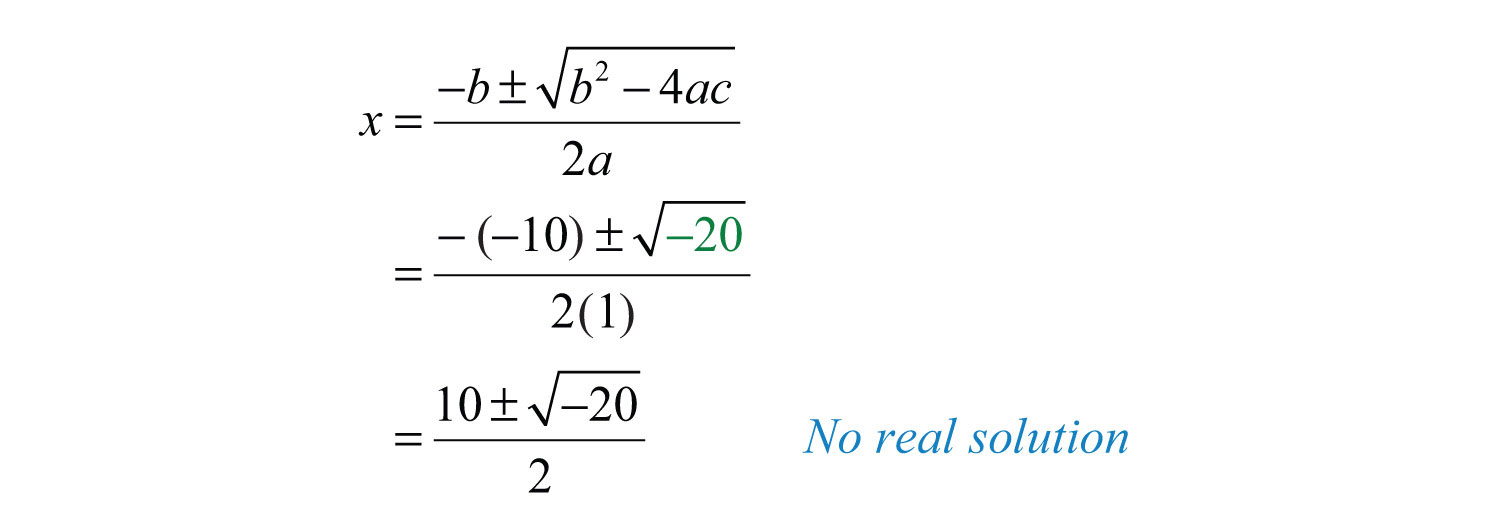
Note
We will study quadratic equations with no real solutions as we progress in our study of algebra.
Example 2: Determine the type and number of solutions: .
Solution: Here

Substitute these values into the discriminant:

Since the discriminant is positive, we can conclude that there are two real solutions.
Answer: Two real solutions
If we use the quadratic formula in the previous example, we find that a positive radicand in the quadratic formula leads to two real solutions.
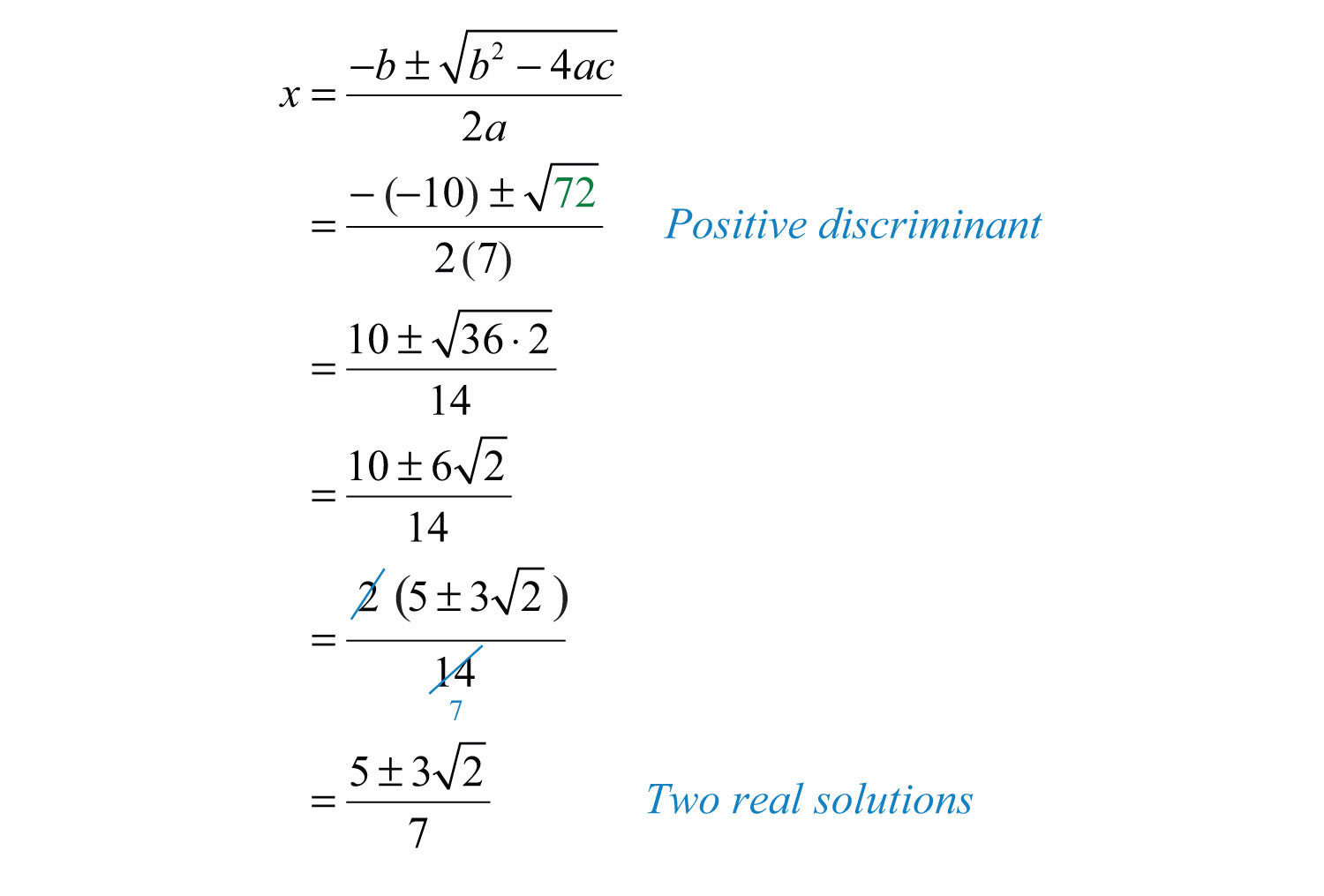
The two real solutions are and . Note that these solutions are irrational; we can approximate the values on a calculator.

Example 3: Determine the type and number of solutions: .
Solution: In this example,

Substitute these values into the discriminant and simplify.

Since the discriminant is positive, we conclude that there are two real solutions. Furthermore, since the discriminant is a perfect square, we obtain two rational solutions.
Answer: Two real solutions
We could solve the previous quadratic equation using the quadratic formula as follows:
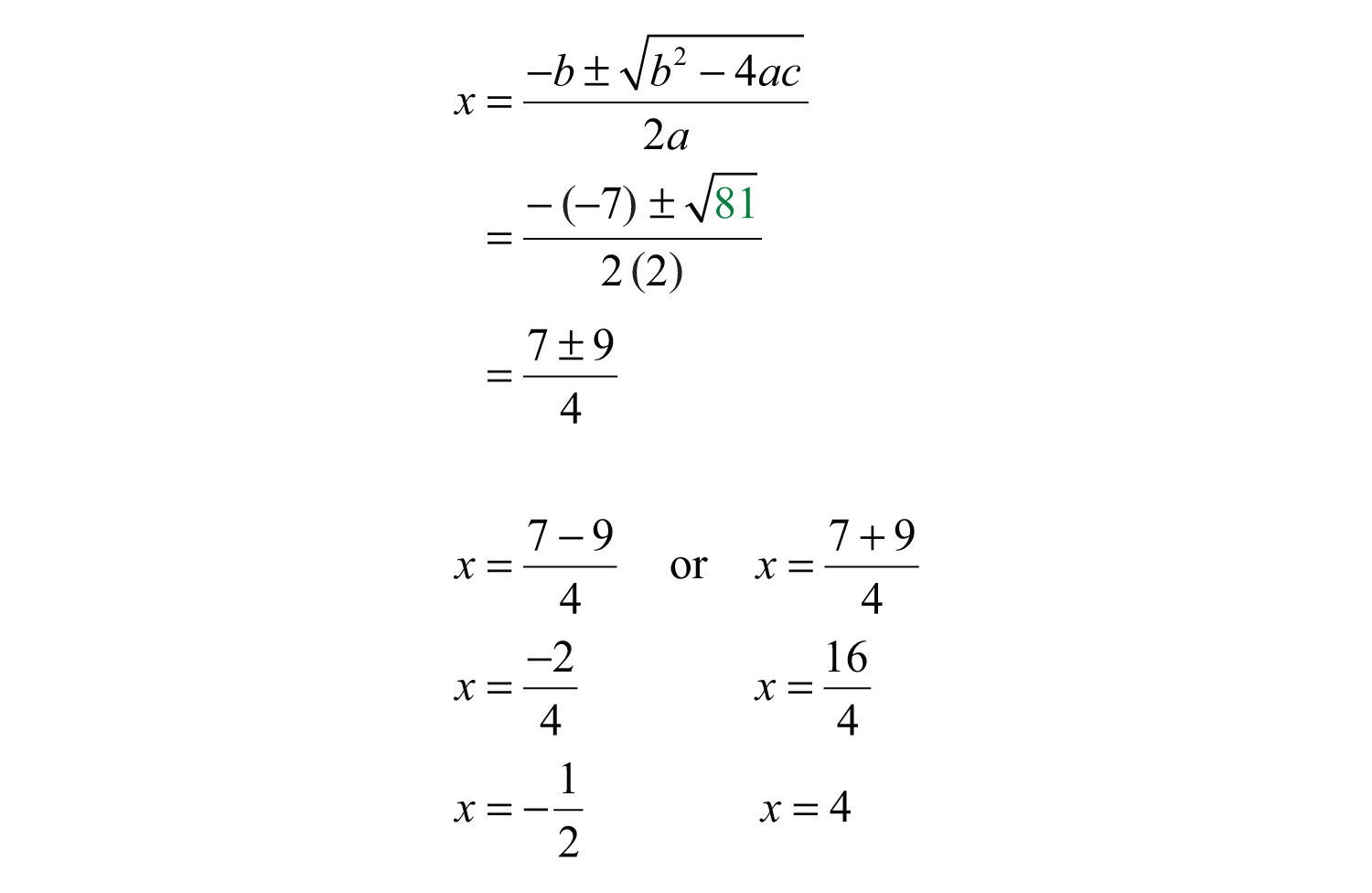
Note that if the discriminant is a perfect square, then we could have factored the original equation.
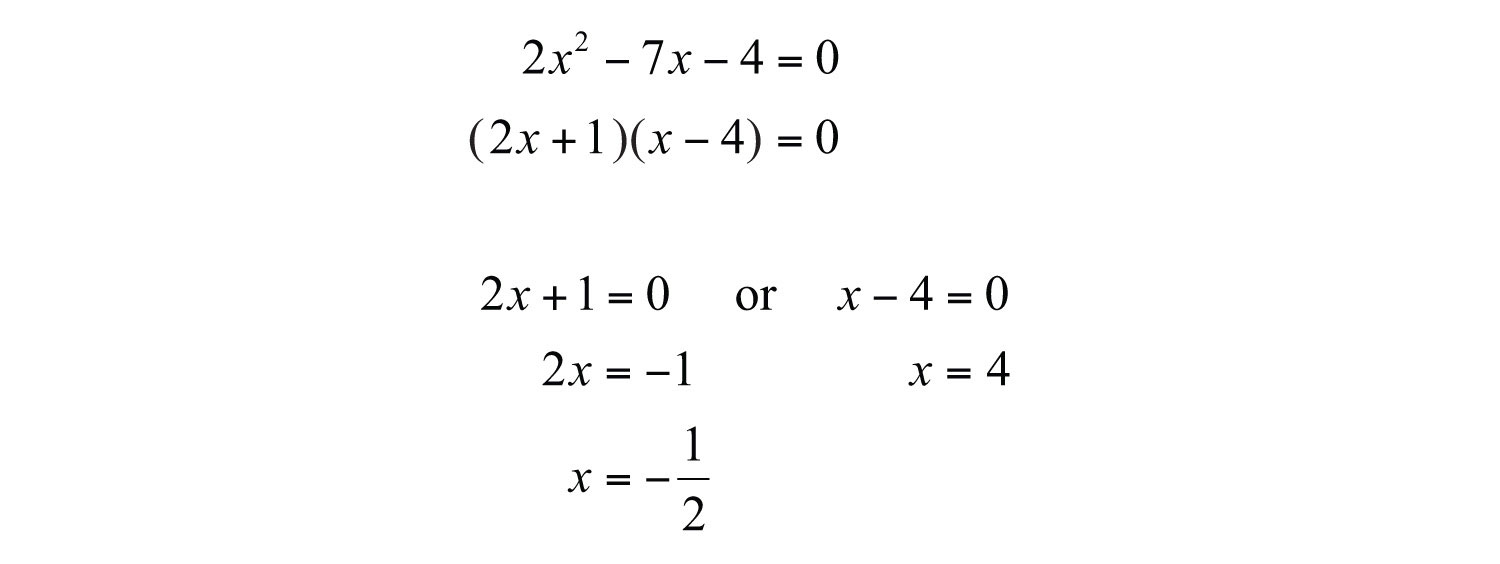
Given the special condition where the discriminant is 0, we obtain only one solution, a double root.
Example 4: Determine the type and number of solutions: .
Solution: Here , , and , and we have

Since the discriminant is 0, we conclude that there is only one real solution, a double root.
Answer: One real solution
Since 0 is a perfect square, we can solve the equation above by factoring.
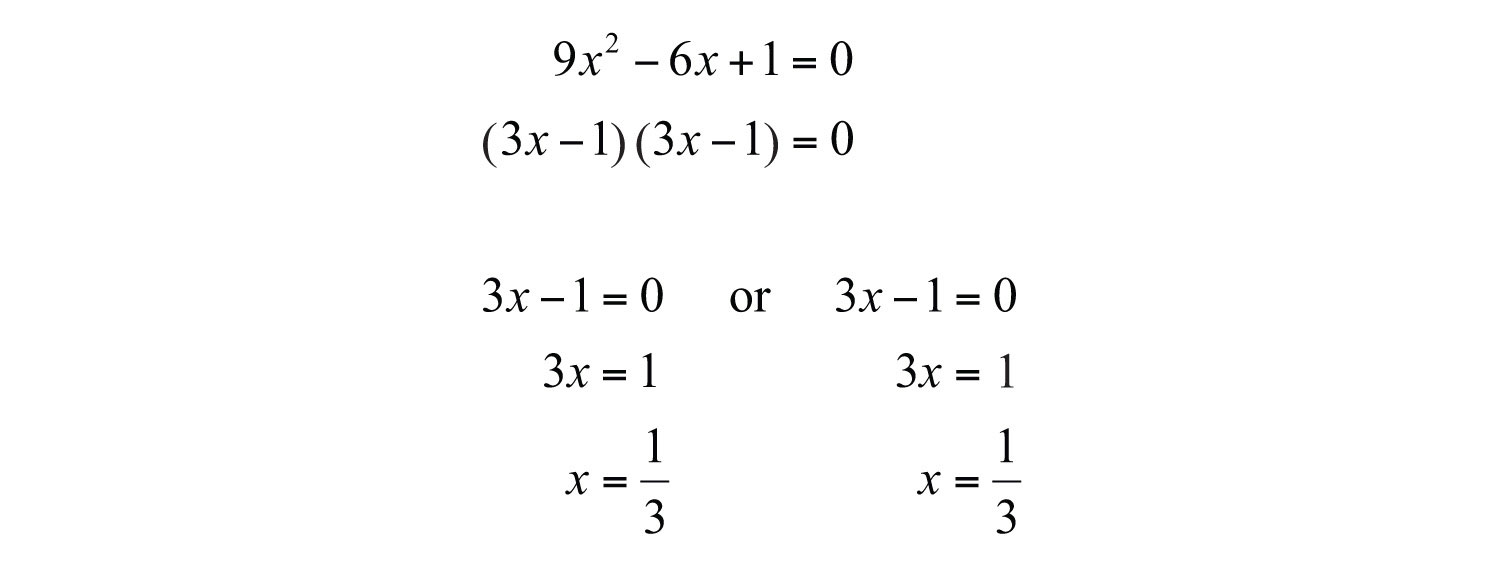
Here 1/3 is a solution that occurs twice; it is a double root.
In summary, if given any quadratic equation in standard form, , where a, b, and c are real numbers and , then we have the following:
| Positive discriminant: | Two real solutions | |
| Zero discriminant: | One real solution | |
| Negative discriminant: | No real solution |
As we will see, knowing the number and type of solutions ahead of time helps us determine which method is best for solving a quadratic equation.
Try this! Determine the number and type of solutions: .
Answer: No real solution
Video Solution
(click to see video)General Guidelines for Solving Quadratic Equations
Use the coefficients of a quadratic equation to help decide which method is most appropriate for solving it. While the quadratic formula always works, it is sometimes not the most efficient method. Given any quadratic equation in standard form, , general guidelines for determining the method for solving it follow:
- If c = 0, then factor out the GCF and solve by factoring.
- If b = 0, then solve by extracting the roots.
-
If a, b, and c are all nonzero, then determine the value for the discriminant, :
- If the discriminant is a perfect square, then solve by factoring.
-
If the discriminant is not a perfect square, then solve using the quadratic formula.
- If the discriminant is positive, we obtain two real solutions.
- If the discriminant is negative, then there is no real solution.
Example 5: Solve: .
Solution: In this case, c = 0 and we can solve by factoring out the GCF.
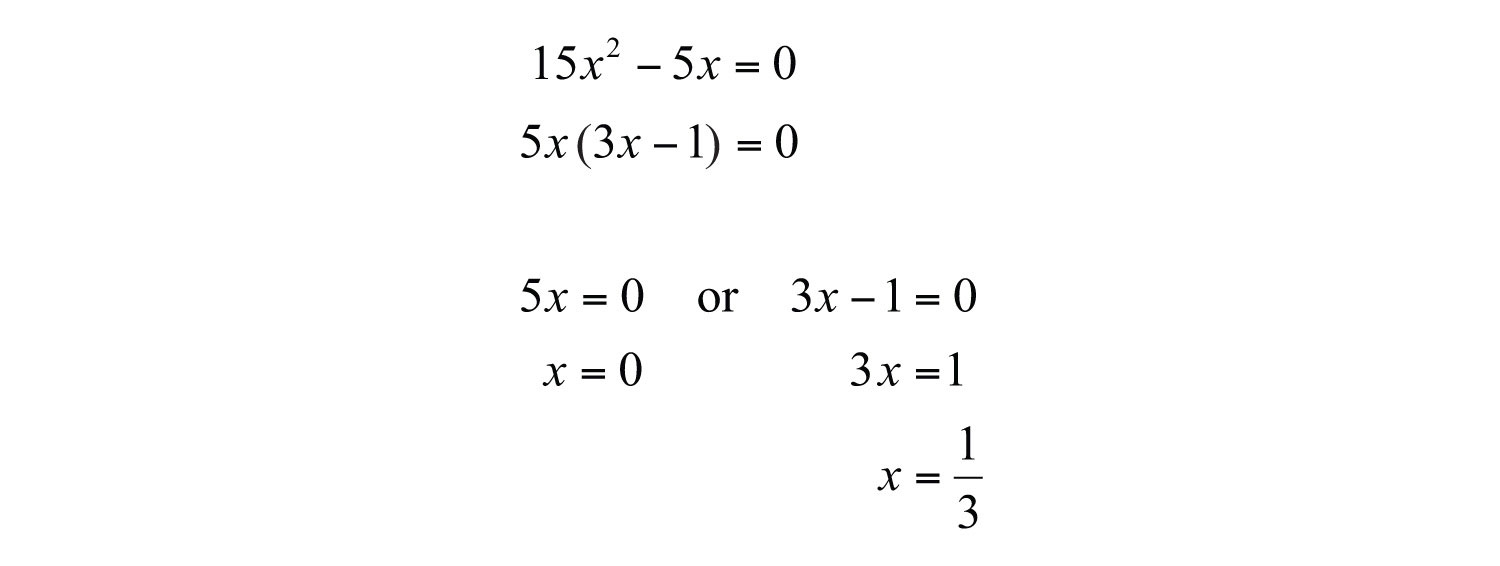
Answer: The solutions are 0 and 1/3.
Example 6: Solve: .
Solution: In this case, b = 0 and we can solve by extracting the roots.
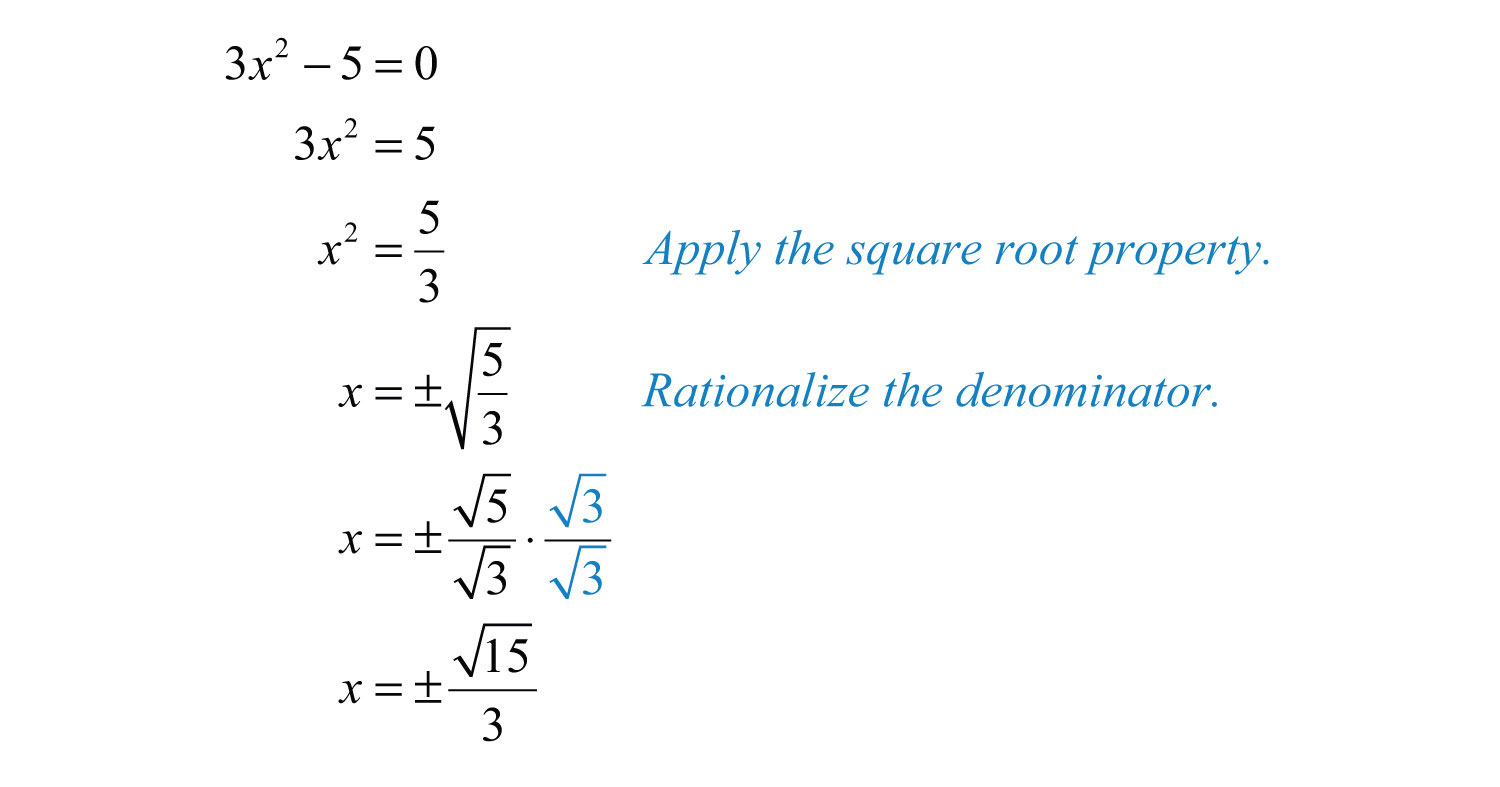
Answer: The solutions are .
Example 7: Solve: .
Solution: Begin by identifying a, b, and c as the coefficients of each term. Here

Substitute these values into the discriminant and then simplify.

Since the discriminant is positive and not a perfect square, use the quadratic formula and expect two real solutions.
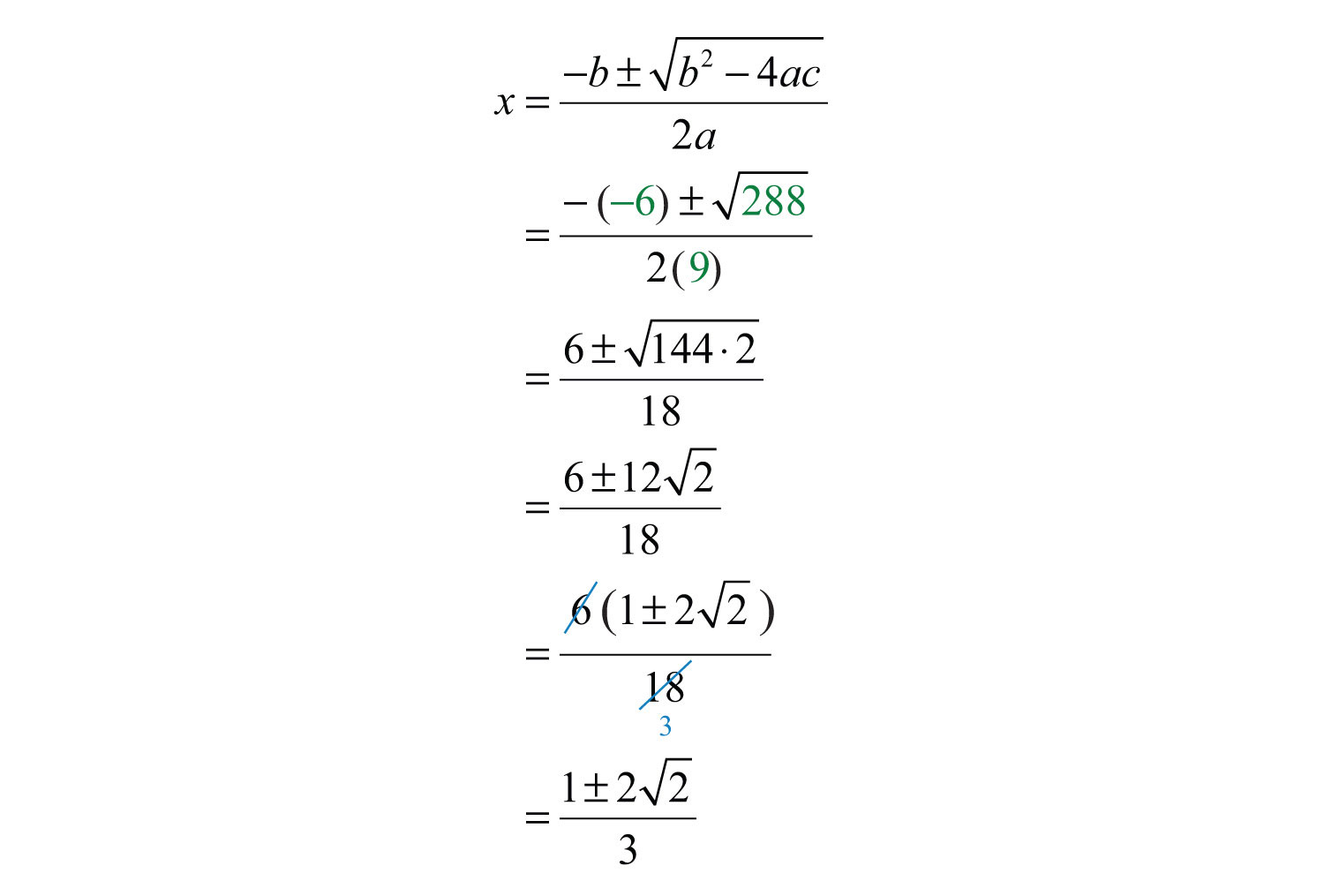
Answer: The solutions are .
Example 8: Solve: .
Solution: Begin by rewriting the quadratic equation in standard form.

Here

Substitute these values into the discriminant and then simplify.

Since the discriminant is negative, the solutions are not real numbers.
Answer: No real solution
Example 9: Solve: .
Solution: Begin by rewriting the quadratic equation in standard form.

Substitute a = 9, b = 30, and c = 25 into the discriminant.

Since the discriminant is 0, solve by factoring and expect one real solution, a double root.
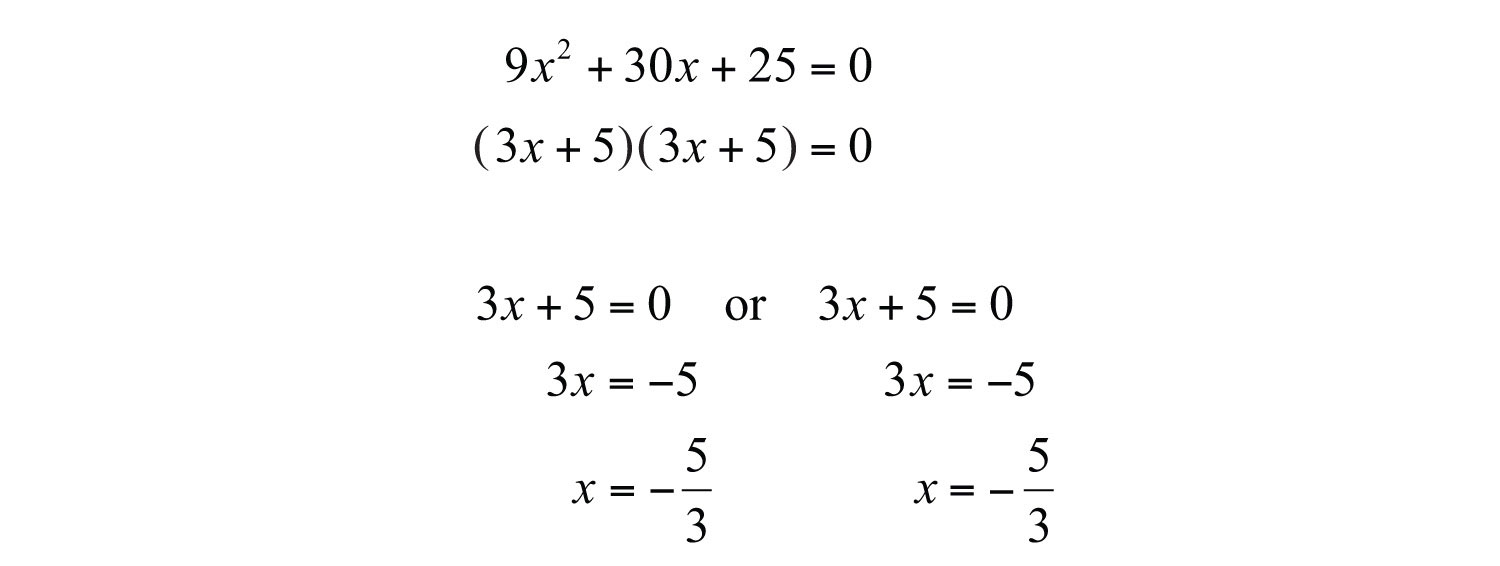
Answer: The solution is −5/3.
Try this! Solve: .
Answer:
Video Solution
(click to see video)Applications Involving Quadratic Equations
In this section, the algebraic setups usually consist of a quadratic equation where the solutions may not be integers.
Example 10: The height of a triangle is 2 inches less than twice the length of its base. If the total area of the triangle is 11 square inches, then find the lengths of the base and height. Round answers to the nearest hundredth.
Solution:


Use the formula and the fact that the area is 11 square inches to set up an algebraic equation.

To rewrite this quadratic equation in standard form, first distribute .

Use the coefficients, a = 1, b = −1, and c = −11, to determine the type of solutions.

Since the discriminant is positive, expect two real solutions.
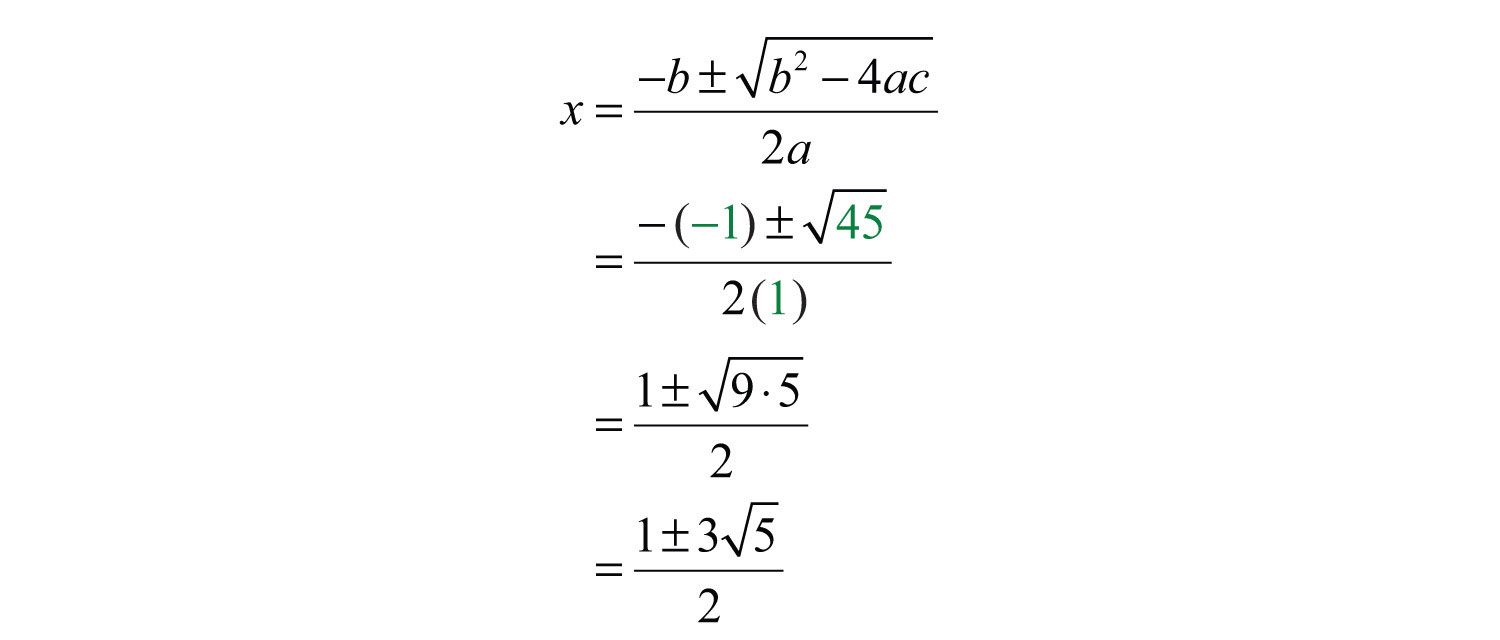
In this problem, disregard the negative solution and consider only the positive solution.

Back substitute to find the height.

Answer: The base measures inches and the height is inches.
Example 11: The sum of the squares of two consecutive positive integers is 481. Find the integers.
Solution:

The algebraic setup follows:

Rewrite the quadratic equation in standard form.
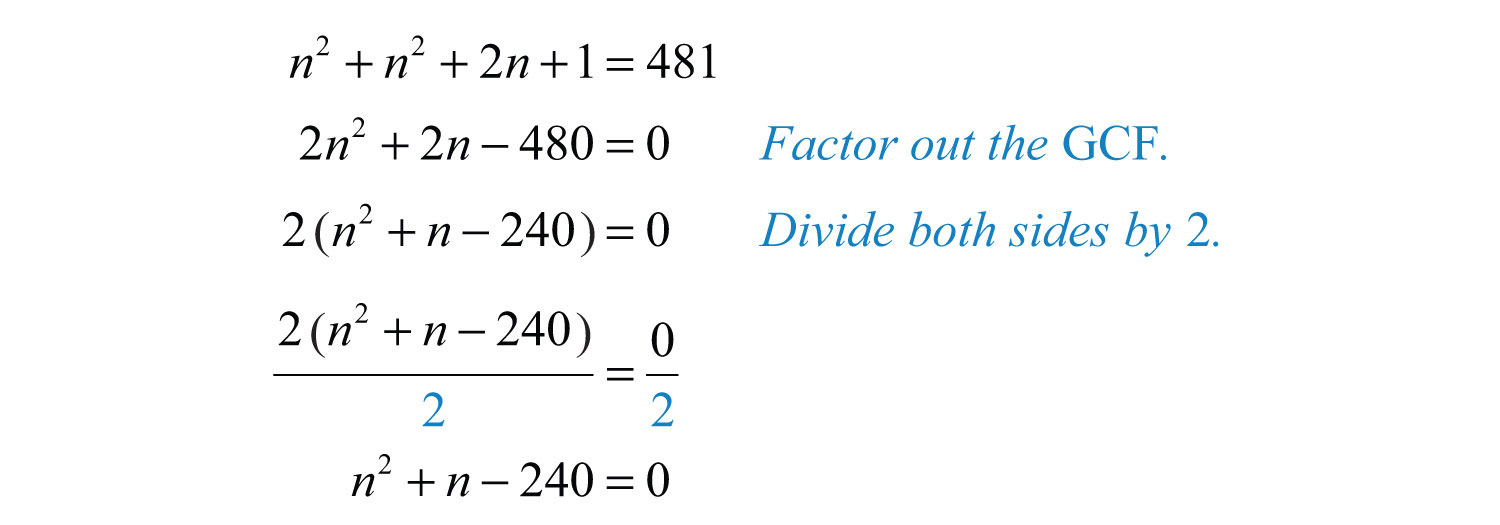
When the coefficients are large, sometimes it is less work to use the quadratic formula instead of trying to factor it. In this case, , , and . Substitute into the quadratic formula and then simplify.
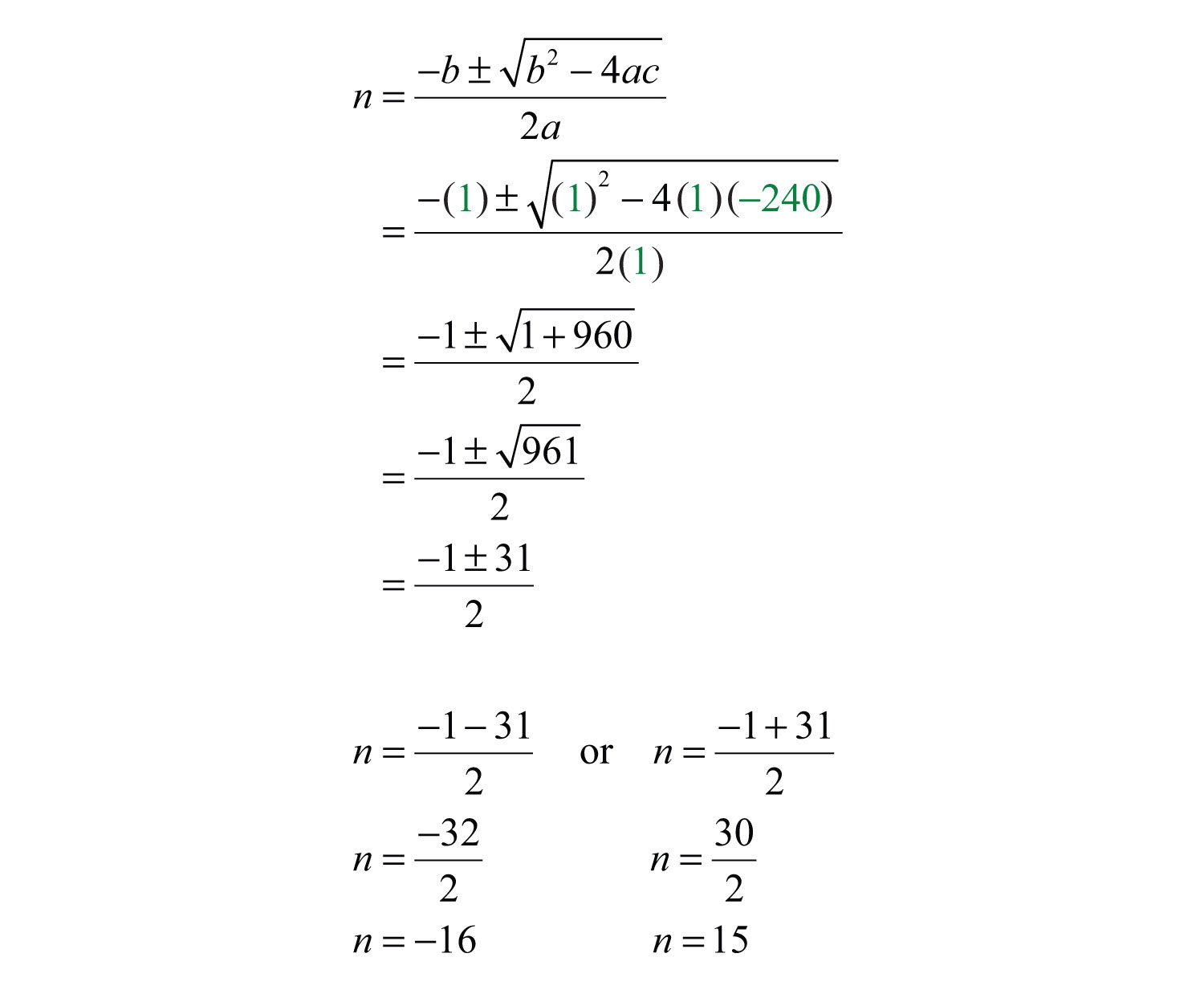
Since the problem calls for positive integers, disregard the negative solution and choose n = 15.

Answer: The positive integers are 15 and 16.
Key Takeaways
- Determine the number and type of solutions to any quadratic equation in standard form using the discriminant, . If the discriminant is negative, then the solutions are not real. If the discriminant is positive, then the solutions are real. If the discriminant is 0, then there is only one solution, a double root.
- Choose the appropriate method for solving a quadratic equation based on the value of its discriminant. While the quadratic formula will solve any quadratic equation, it may not be the most efficient method.
- When solving applications, use the key words and phrases to set up an algebraic equation that models the problem. In this section, the setup typically involves a quadratic equation.
Topic Exercises
Part A: Using the Discriminant
Calculate the discriminant and use it to determine the number and type of solutions. Do not solve.
1.
2.
3.
4.
5.
6.
7.
8.
9.
10.
11.
12.
13.
14.
Part B: Solving
Choose the appropriate method to solve the following.
15.
16.
17.
18.
19.
20.
21.
22.
23.
24.
25.
26.
27.
28.
29.
30.
31.
32.
33.
34.
35.
36.
37.
38.
39.
40.
41.
42.
43.
44.
45.
46.
47.
48.
49.
50.
Part C: Applications
Set up an algebraic equation and use it to solve the following.
Number Problems
51. A positive real number is 2 less than another. When 4 times the larger is added to the square of the smaller, the result is 49. Find the numbers.
52. A positive real number is 1 more than another. When twice the smaller is subtracted from the square of the larger, the result is 4. Find the numbers.
53. A positive real number is 6 less than another. If the sum of the squares of the two numbers is 38, then find the numbers.
54. A positive real number is 1 more than twice another. If 4 times the smaller number is subtracted from the square of the larger, then the result is 21. Find the numbers.
Geometry Problems
Round off your answers to the nearest hundredth.
55. The area of a rectangle is 60 square inches. If the length is 3 times the width, then find the dimensions of the rectangle.
56. The area of a rectangle is 6 square feet. If the length is 2 feet more than the width, then find the dimensions of the rectangle.
57. The area of a rectangle is 27 square meters. If the length is 6 meters less than 3 times the width, then find the dimensions of the rectangle.
58. The area of a triangle is 48 square inches. If the base is 2 times the height, then find the length of the base.
59. The area of a triangle is 14 square feet. If the base is 4 feet more than 2 times the height, then find the length of the base and the height.
60. The area of a triangle is 8 square meters. If the base is 4 meters less than the height, then find the length of the base and the height.
61. The perimeter of a rectangle is 54 centimeters and the area is 180 square centimeters. Find the dimensions of the rectangle.
62. The perimeter of a rectangle is 50 inches and the area is 126 square inches. Find the dimensions of the rectangle.
63. George maintains a successful 6-meter-by-8-meter garden. Next season he plans on doubling the planting area by increasing the width and height by an equal amount. By how much must he increase the length and width?
64. A uniform brick border is to be constructed around a 6-foot-by-8-foot garden. If the total area of the garden, including the border, is to be 100 square feet, then find the width of the brick border.
Pythagorean Theorem
65. If the sides of a square measure units, then find the length of the diagonal.
66. If the diagonal of a square measures units, then find the length of each side.
67. The diagonal of a rectangle measures inches. If the width is 4 inches less than the length, then find the dimensions of the rectangle.
68. The diagonal of a rectangle measures inches. If the width is 2 inches less than the length, then find the dimensions of the rectangle.
69. The top of a 20-foot ladder, leaning against a building, reaches a height of 18 feet. How far is the base of the ladder from the wall? Round off to the nearest hundredth.
70. To safely use a ladder, the base should be placed about 1/4 of the ladder’s length away from the wall. If a 20-foot ladder is to be safely used, then how high against a building will the top of the ladder reach? Round off to the nearest hundredth.
71. The diagonal of a television monitor measures 32 inches. If the monitor has a 3:2 aspect ratio, then determine its length and width. Round off to the nearest hundredth.
72. The diagonal of a television monitor measures 52 inches. If the monitor has a 16:9 aspect ratio, then determine its length and width. Round off to the nearest hundredth.
Business Problems
73. The profit in dollars of running an assembly line that produces custom uniforms each day is given by the function , where t represents the number of hours the line is in operation.
a. Calculate the profit on running the assembly line for 10 hours a day.
b. Calculate the number of hours the assembly line should run in order to break even. Round off to the nearest tenth of an hour.
74. The profit in dollars generated by producing and selling x custom lamps is given by the function .
a. Calculate the profit on the production and sale of 35 lamps.
b. Calculate the number of lamps that must be sold to profit $3,000.
75. If $1,200 is invested in an account earning an annual interest rate r, then the amount A that is in the account at the end of 2 years is given by the formula . If at the end of 2 years the amount in the account is $1,335.63, then what was the interest rate?
76. A manufacturing company has determined that the daily revenue, R, in thousands of dollars depends on the number, n, of palettes of product sold according to the formula . Determine the number of palettes that must be sold in order to maintain revenues at $60,000 per day.
Projectile Problems
77. The height of a projectile launched upward at a speed of 32 feet/second from a height of 128 feet is given by the function .
a. What is the height of the projectile at 1/2 second?
b. At what time after launch will the projectile reach a height of 128 feet?
78. The height of a projectile launched upward at a speed of 16 feet/second from a height of 192 feet is given by the function .
a. What is the height of the projectile at 3/2 seconds?
b. At what time will the projectile reach 128 feet?
79. The height of an object dropped from the top of a 144-foot building is given by . How long will it take to reach a point halfway to the ground?
80. The height of a projectile shot straight up into the air at 80 feet/second from the ground is given by . At what time will the projectile reach 95 feet?
Part D: Discussion Board
81. Discuss the strategy of always using the quadratic formula to solve quadratic equations.
82. List all of the methods that we have learned so far to solve quadratic equations. Discuss the pros and cons of each.
Answers
1: −8, no real solution
3: 25, two real solutions
5: −72, no real solution
7: 1, two real solutions
9: −1, no real solution
11: 20, two real solutions
13: 0, one real solution
15: −1, 3
17: −2/3, 1
19: No real solution
21: −1/5, 0
23: No real solution
25:
27: 5/2
29:
31: No real solution
33:
35: 1/2, 4
37: 0, 1/18
39: No real solution
41:
43: No real solution
45: −1/2, 1/3
47: 2/3
49:
51: and
53: and
55: Length: 13.42 inches; width: 4.47 inches
57: Length: 6.48 meters; width: 4.16 meters
59: Height: 2.87 feet; base: 9.74 feet
61: Length: 15 centimeters; width: 12 centimeters
63: 2.85 meters
65: units
67: Length: inches; width: inches
69: feet
71: Length: 26.63 inches; width: 17.75 inches
73: a. $1,600; b. 5.4 hours and 18.6 hours
75: 5.5%
77: a. 140 feet; b. 0 seconds and 2 seconds
79: 2.12 seconds
9.5 Graphing Parabolas
Learning Objectives
- Graph a parabola.
- Find the intercepts and vertex of a parabola.
- Find the vertex of a parabola by completing the square.
The Graph of a Quadratic Equation
We know that any linear equation with two variables can be written in the form and that its graph is a line. In this section, we will see that any quadratic equation of the form has a curved graph called a parabolaThe graph of any quadratic equation , where a, b, and c are real numbers and ..

Two points determine any line. However, since a parabola is curved, we should find more than two points. In this text, we will determine at least five points as a means to produce an acceptable sketch. To begin, we graph our first parabola by plotting points. Given a quadratic equation of the form , x is the independent variable and y is the dependent variable. Choose some values for x and then determine the corresponding y-values. Then plot the points and sketch the graph.
Example 1: Graph by plotting points: .
Solution: In this example, choose the x-values {−2, −1, 0, 1, 2, 3, 4} and calculate the corresponding y-values.
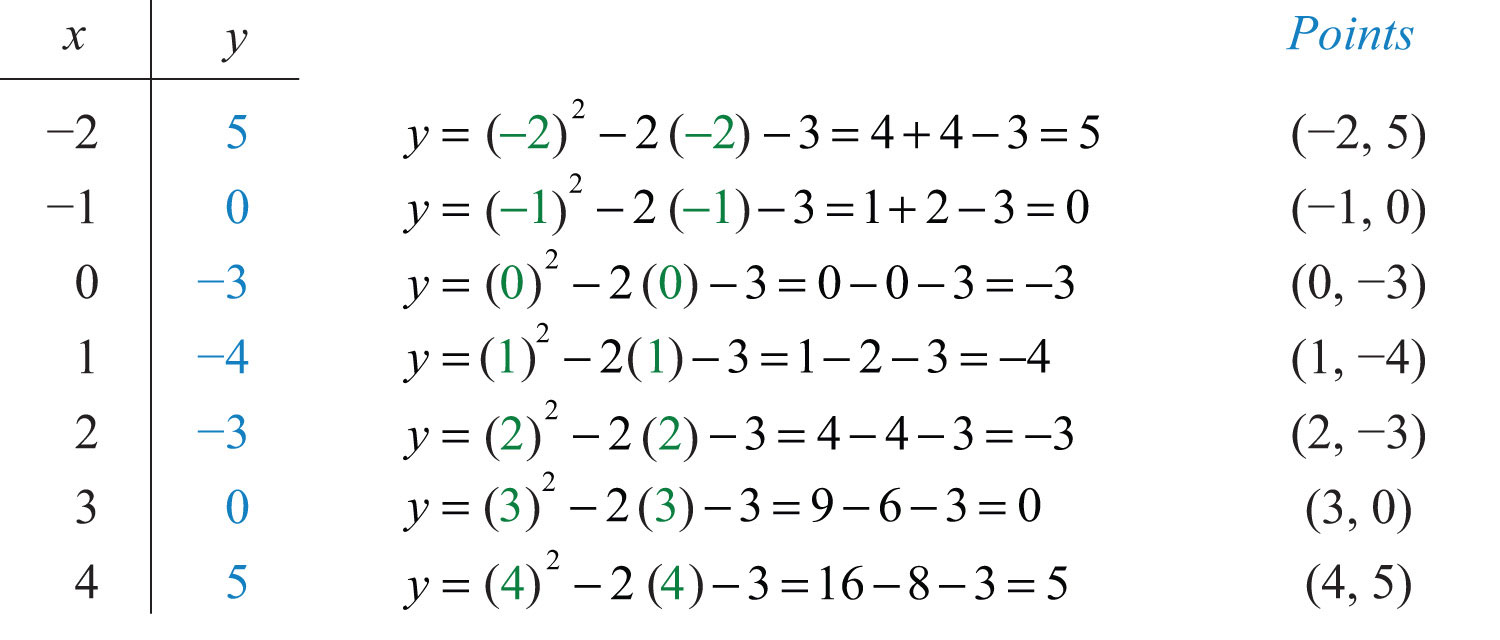
Plot these points and determine the shape of the graph.
Answer:
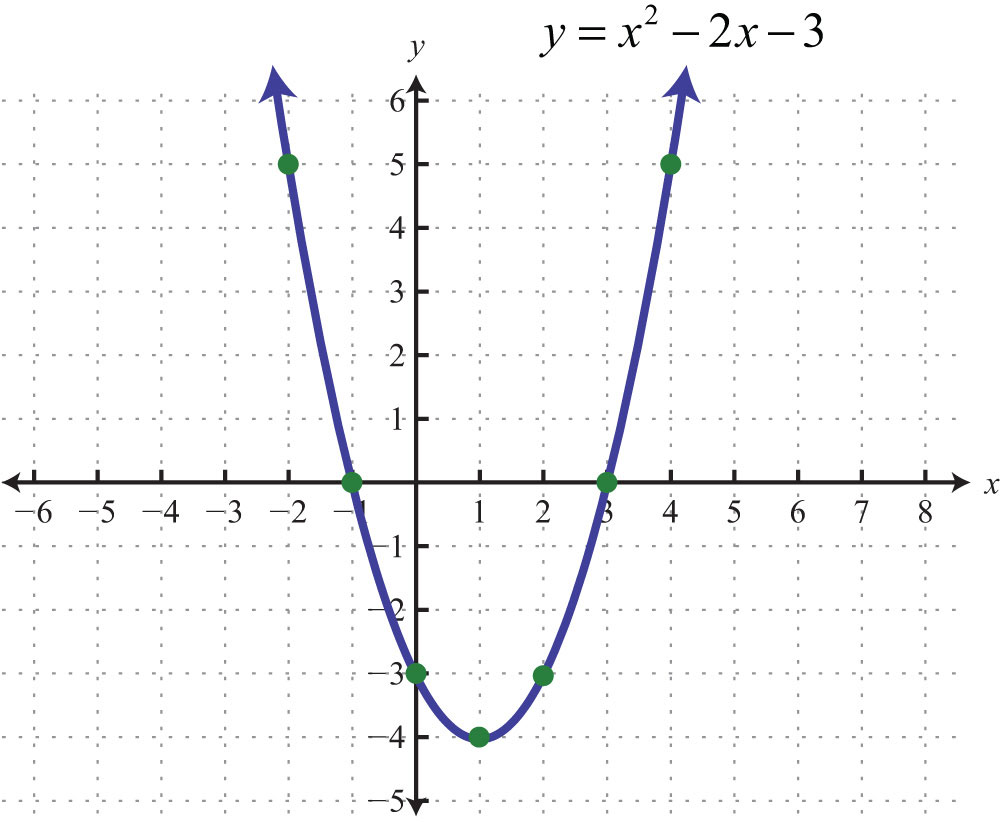
When graphing, we want to include certain special points in the graph. The y-intercept is the point where the graph intersects the y-axis. The x-intercepts are the points where the graph intersects the x-axis. The vertexThe point that defines the minimum or maximum of a parabola. is the point that defines the minimum or maximum of the graph. Lastly, the line of symmetryThe vertical line through the vertex, , about which the parabola is symmetric. (also called the axis of symmetryA term used when referencing the line of symmetry.) is the vertical line through the vertex, about which the parabola is symmetric.
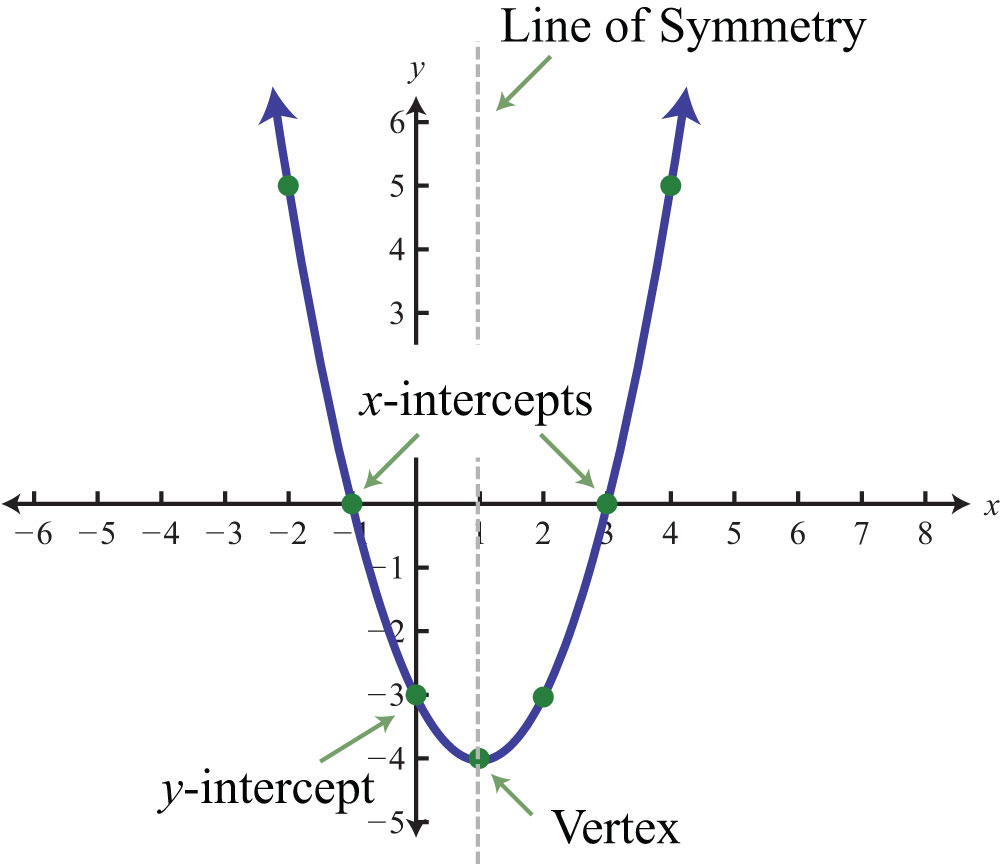
For any parabola, we will find the vertex and y-intercept. In addition, if the x-intercepts exist, then we will want to determine those as well. Guessing at the x-values of these special points is not practical; therefore, we will develop techniques that will facilitate finding them. Many of these techniques will be used extensively as we progress in our study of algebra.
Given a quadratic equation of the form , find the y-intercept by setting and solving. In general, , and we have

Next, recall that the x-intercepts, if they exist, can be found by setting . Doing this, we have , which has general solutions given by the quadratic formula, . Therefore, the x-intercepts have this general form:

Using the fact that a parabola is symmetric, we can determine the vertical line of symmetry using the x-intercepts. To do this, we find the x-value midway between the x-intercepts by taking an average as follows:
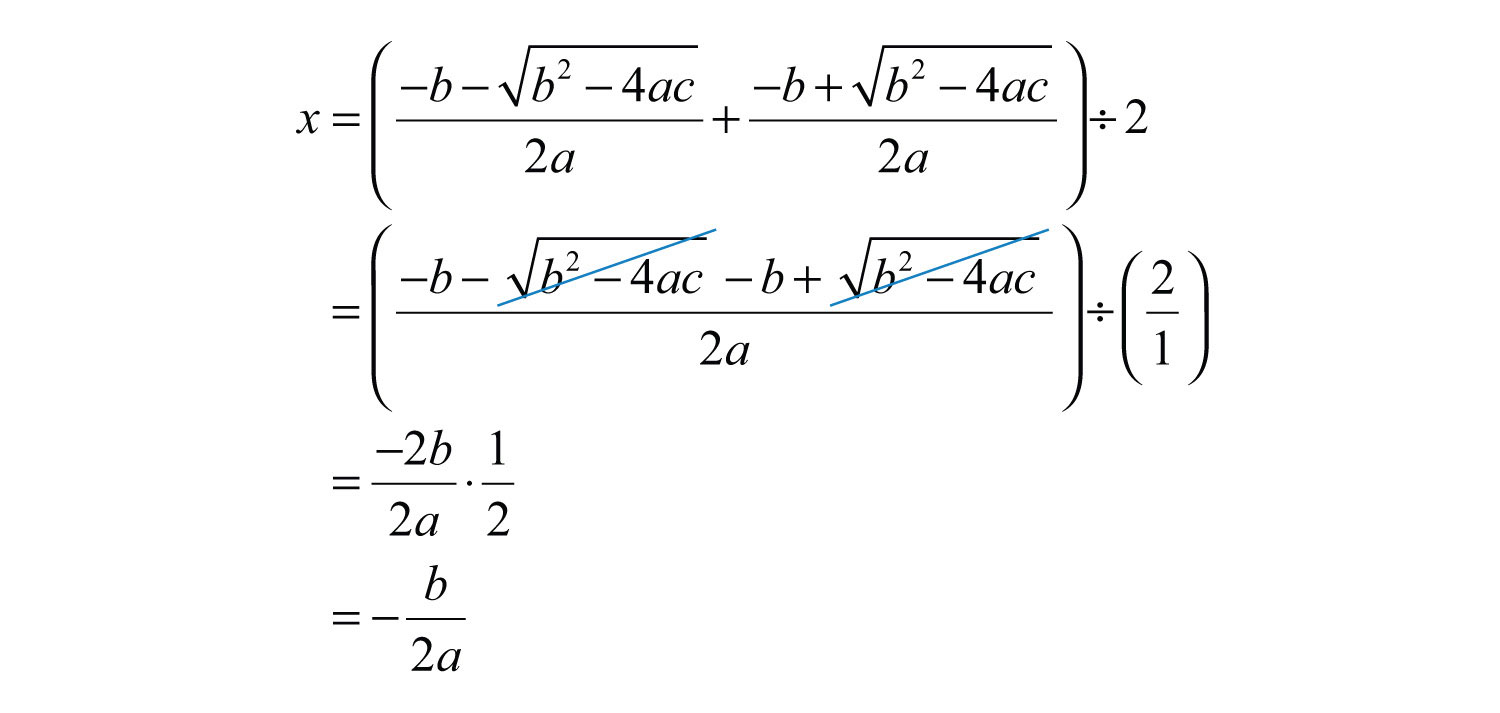
Therefore, the line of symmetry is the vertical line:

We can use the line of symmetry to find the x-value of the vertex. The steps for graphing a parabola are outlined in the following example.
Example 2: Graph: .
Solution:
Step 1: Determine the y-intercept. To do this, set x = 0 and solve for y.

The y-intercept is (0, 3).
Step 2: Determine the x-intercepts. To do this, set y = 0 and solve for x.
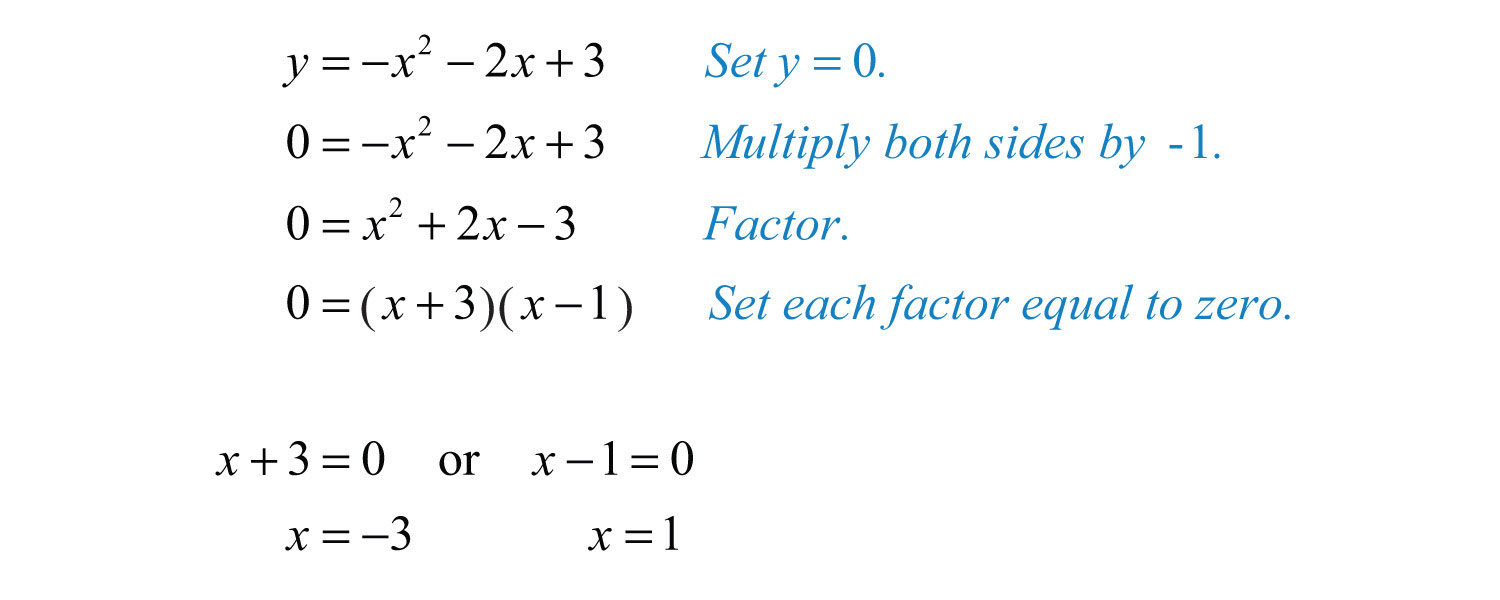
Here when y = 0, we obtain two solutions. There are two x-intercepts, (−3, 0) and (1, 0).
Step 3: Determine the vertex. One way to do this is to use the equation for the line of symmetry, , to find the x-value of the vertex. In this example, a = −1 and b = −2:

Substitute −1 into the original equation to find the corresponding y-value.

The vertex is (−1, 4).
Step 4: Determine extra points so that we have at least five points to plot. In this example, one other point will suffice. Choose x = −2 and find the corresponding y-value.

Our fifth point is (−2, 3).
Step 5: Plot the points and sketch the graph. To recap, the points that we have found are
| y-intercept: | (0, 3) |
| x-intercept: | (−3, 0) and (1, 0) |
| Vertex: | (−1, 4) |
| Extra point: | (−2, 3) |
Answer:
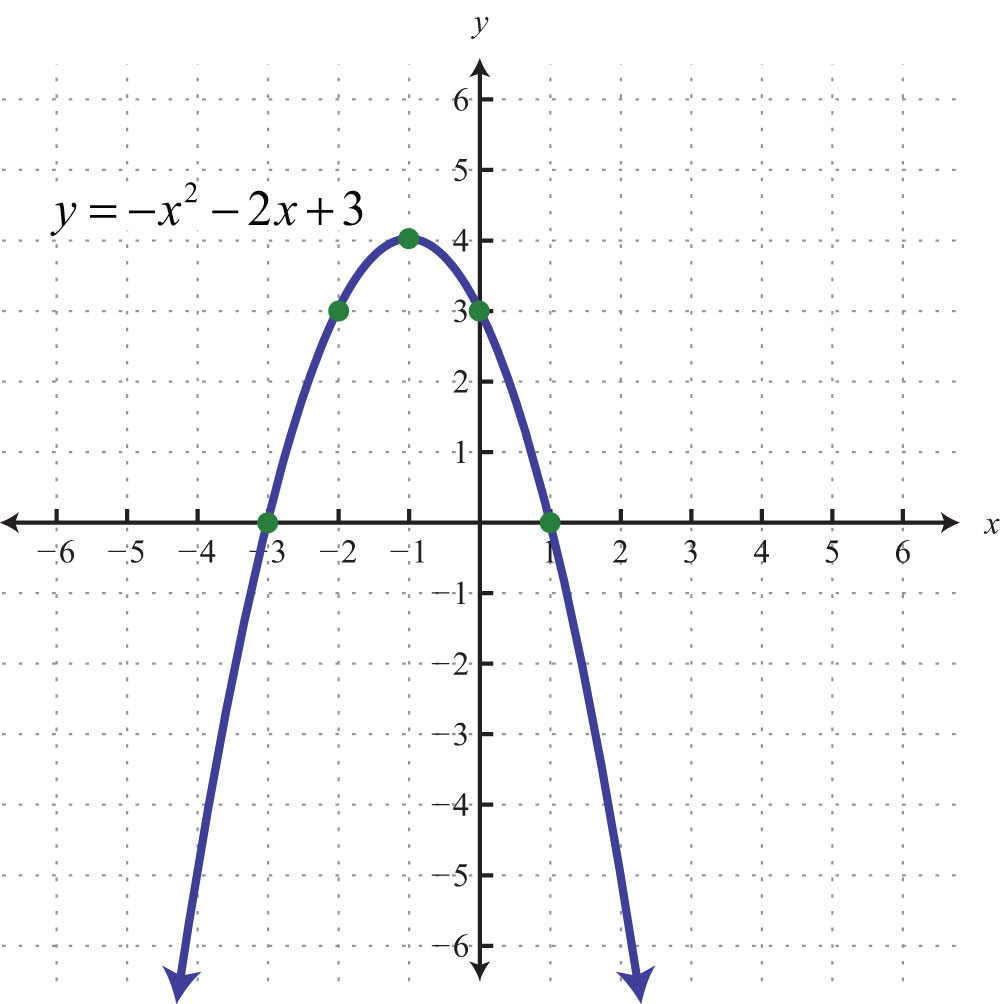
The parabola opens downward. In general, use the leading coefficient to determine whether the parabola opens upward or downward. If the leading coefficient is negative, as in the previous example, then the parabola opens downward. If the leading coefficient is positive, then the parabola opens upward.
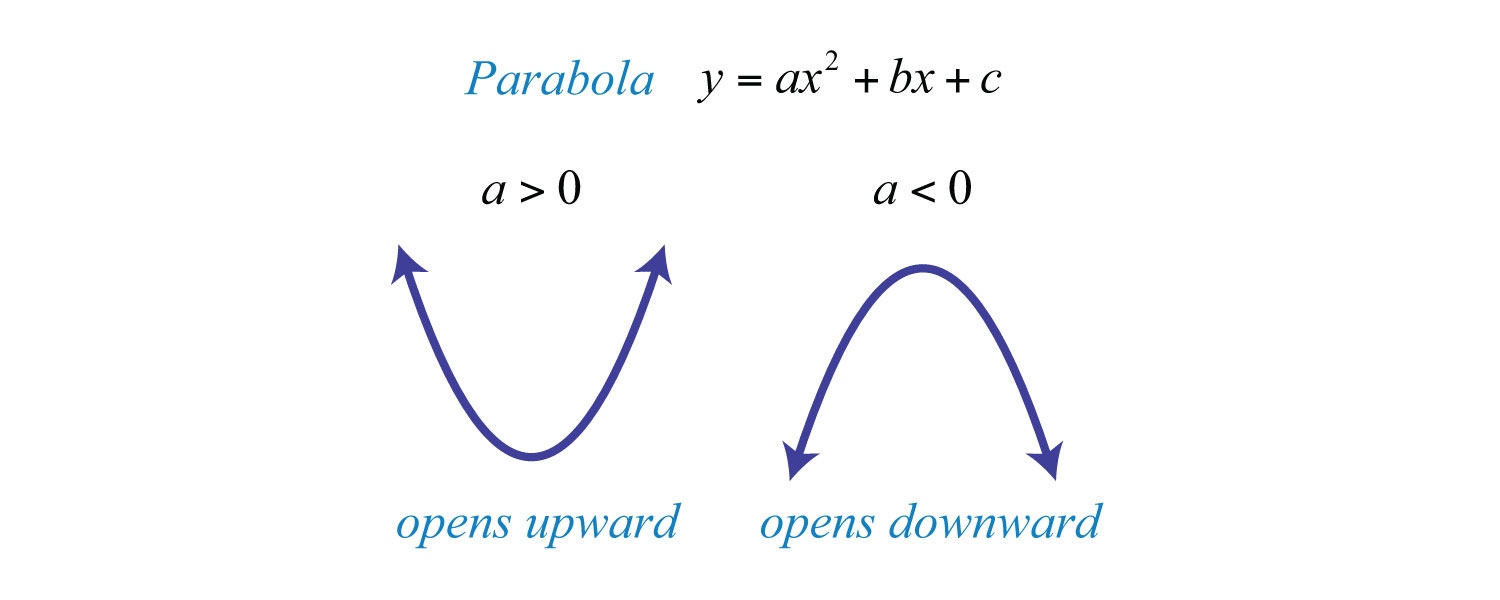
All quadratic equations of the form have parabolic graphs with y-intercept (0, c). However, not all parabolas have x intercepts.
Example 3: Graph: .
Solution: Because the leading coefficient 2 is positive, note that the parabola opens upward. Here c = 5 and the y-intercept is (0, 5). To find the x-intercepts, set y = 0.

In this case, a = 2, b = 4, and c = 5. Use the discriminant to determine the number and type of solutions.

Since the discriminant is negative, we conclude that there are no real solutions. Because there are no real solutions, there are no x-intercepts. Next, we determine the x-value of the vertex.

Given that the x-value of the vertex is −1, substitute into the original equation to find the corresponding y-value.

The vertex is (−1, 3). So far, we have only two points. To determine three more, choose some x-values on either side of the line of symmetry, x = −1. Here we choose x-values −3, −2, and 1.

To summarize, we have
| y-intercept: | (0, 5) |
| x-intercepts: | None |
| Vertex: | (−1, 3) |
| Extra points: | (−3, 11), (−2, 5), (1, 11) |
Plot the points and sketch the graph.
Answer:
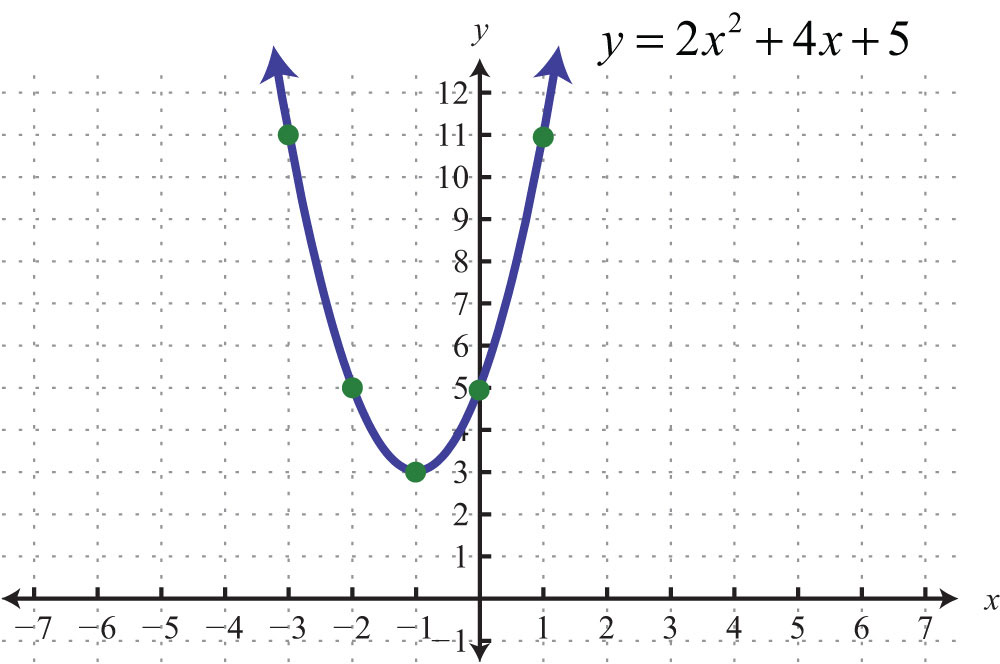
Example 4: Graph: .
Solution: Note that a = −2: the parabola opens downward. Since c = −18, the y-intercept is (0, −18). To find the x-intercepts, set y = 0.

Solve by factoring.
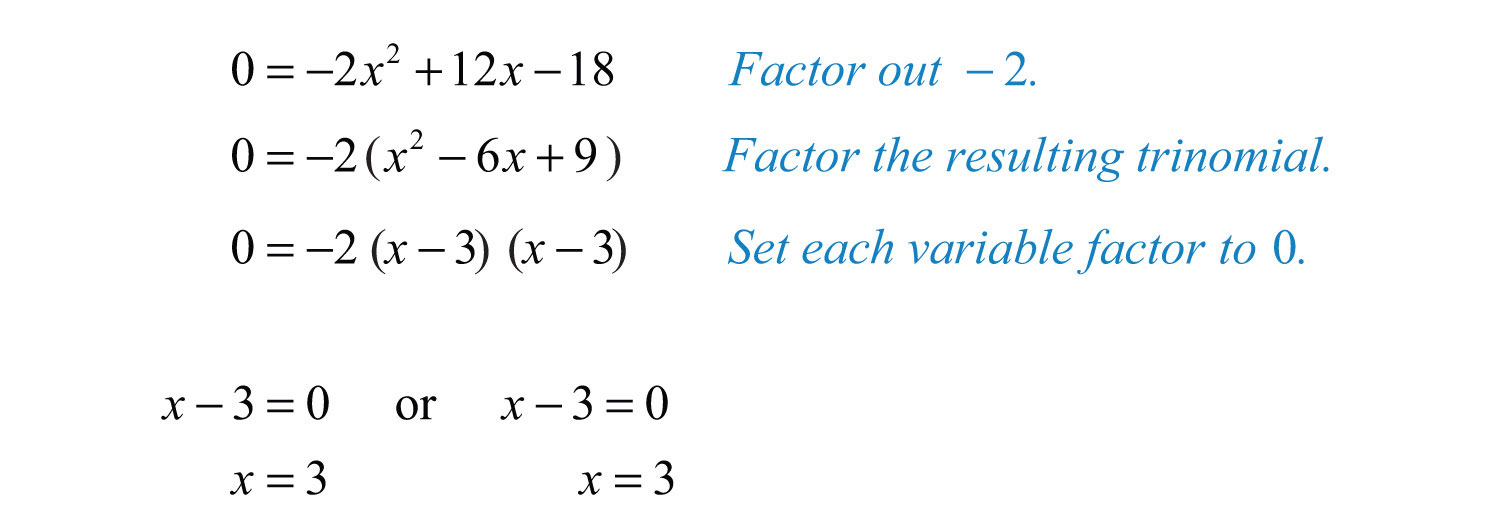
Here x = 3 is a double root, so there is only one x-intercept, (3, 0). From the original equation, a = −2, b = 12, and c = −18. The x-value of the vertex can be calculated as follows:

Given that the x-value of the vertex is 3, substitute into the original equation to find the corresponding y-value.

Therefore, the vertex is (3, 0), which happens to be the same point as the x-intercept. So far, we have only two points. To determine three more, choose some x-values on either side of the line of symmetry, x = 3 in this case. Choose x-values 1, 5, and 6.

To summarize, we have
| y-intercept: | (0, −18) |
| x-intercept: | (3, 0) |
| Vertex: | (3, 0) |
| Extra points: | (1, −8), (5, −8), (6, −18) |
Plot the points and sketch the graph.
Answer:

Example 5: Graph: .
Solution: Since a = 1, the parabola opens upward. Furthermore, c = −1, so the y-intercept is (0, −1). To find the x-intercepts, set y = 0.

In this case, solve using the quadratic formula with a = 1, b = −2, and c = −1.

Here we obtain two real solutions for x, and thus there are two x-intercepts:

Approximate values using a calculator:

Use the approximate answers to place the ordered pair on the graph. However, we will present the exact x-intercepts on the graph. Next, find the vertex.

Given that the x-value of the vertex is 1, substitute into the original equation to find the corresponding y-value.

The vertex is (1, −2). We need one more point.

To summarize, we have
| y-intercept: | (0, −1) |
| x-intercepts: | (, 0) and (, 0) |
| Vertex: | (1, −2) |
| Extra point: | (2, −1) |
Plot the points and sketch the graph.
Answer:
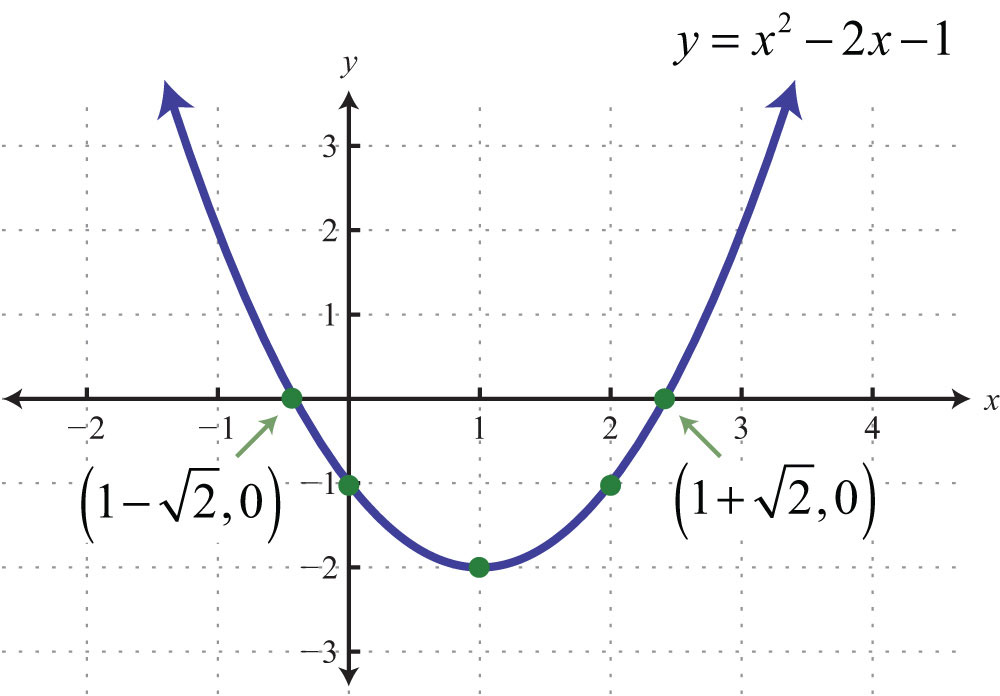
Try this! Graph: .
Answer:
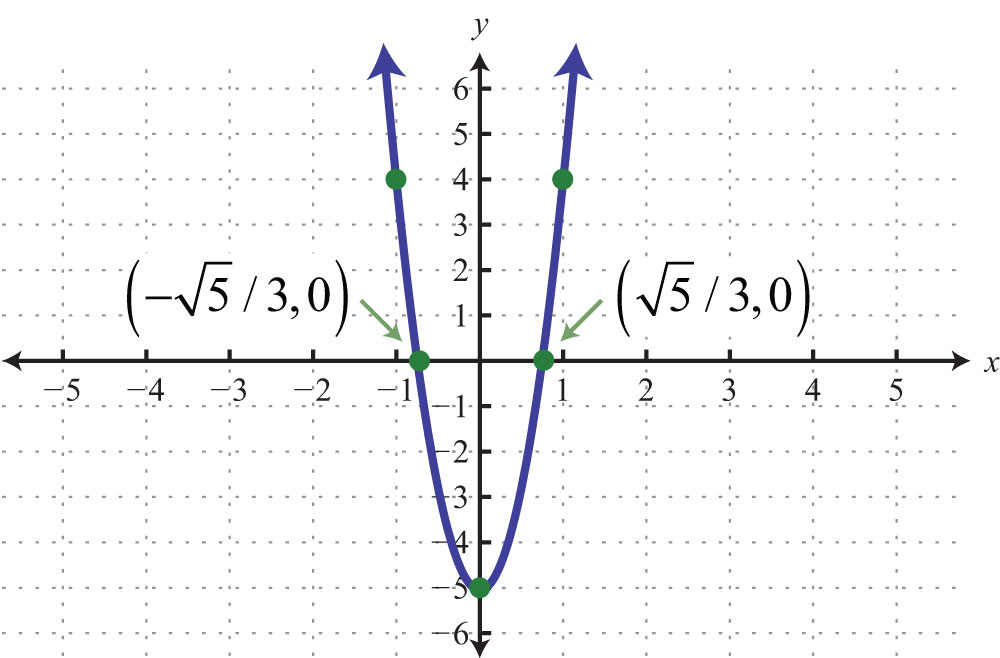
Video Solution
(click to see video)Finding the Maximum and Minimum
It is often useful to find the maximum and/or minimum values of functions that model real-life applications. To find these important values given a quadratic function, we use the vertex. If the leading coefficient a is positive, then the parabola opens upward and there will be a minimum y-value. If the leading coefficient a is negative, then the parabola opens downward and there will be a maximum y-value.
Example 6: Determine the maximum or minimum: .
Solution: Since a = −4, we know that the parabola opens downward and there will be a maximum y-value. To find it, we first find the x-value of the vertex.
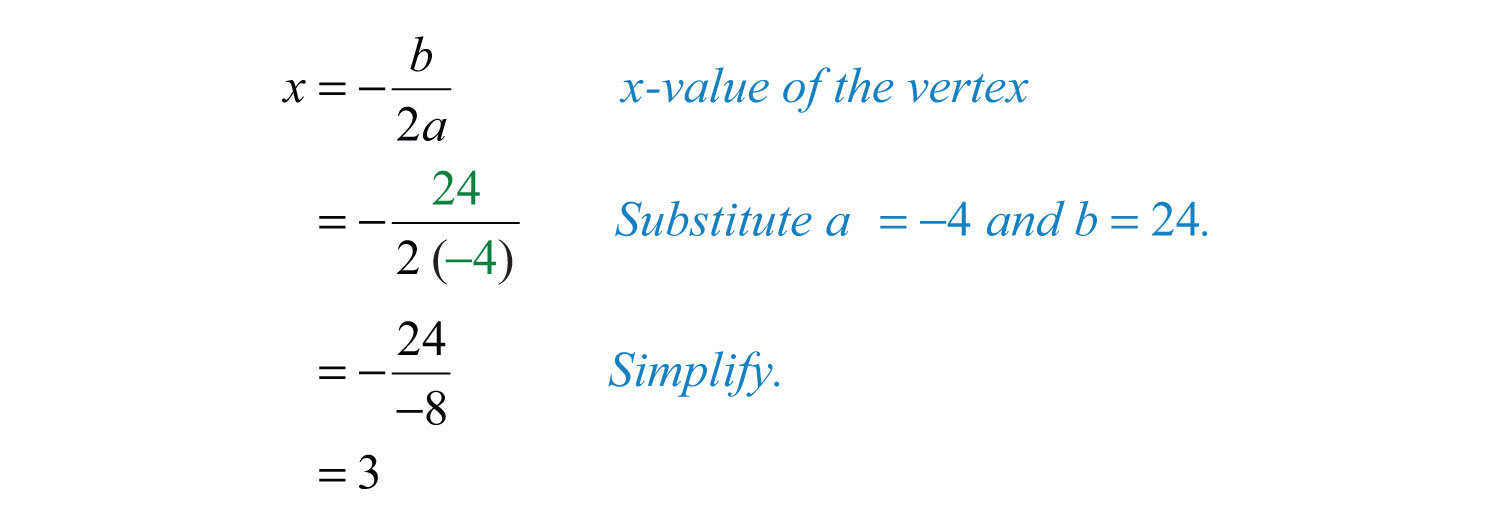
The x-value of the vertex is 3. Substitute this value into the original equation to find the corresponding y-value.

The vertex is (3, 1). Therefore, the maximum y-value is 1, which occurs when x = 3, as illustrated below:

Note
The graph is not required to answer this question.
Answer: The maximum is 1.
Example 7: Determine the maximum or minimum: .
Solution: Since a = +4, the parabola opens upward and there is a minimum y-value. Begin by finding the x-value of the vertex.
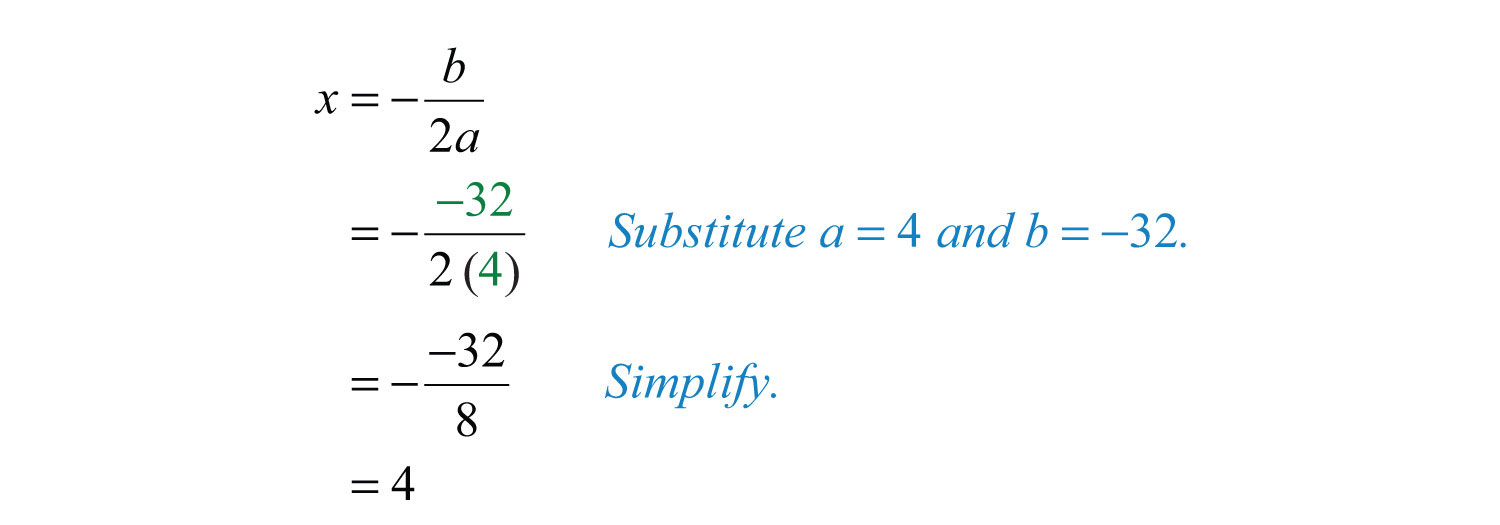
Substitute x = 4 into the original equation to find the corresponding y-value.

The vertex is (4, −2). Therefore, the minimum y-value of −2 occurs when x = 4, as illustrated below:
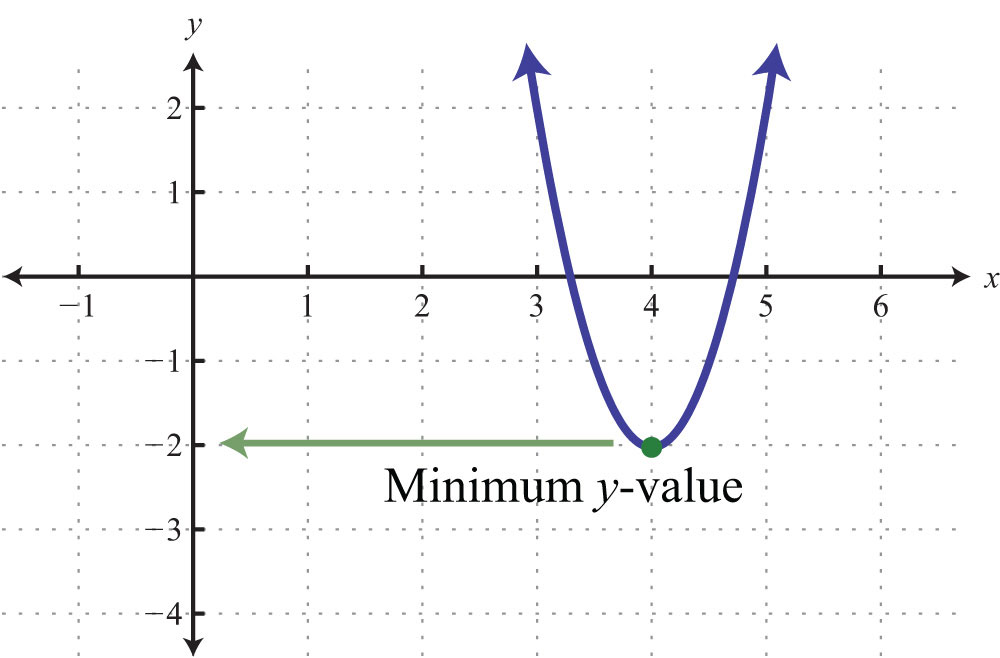
Answer: The minimum is −2.
Try this! Determine the maximum or minimum: .
Answer: The minimum is −9.
Video Solution
(click to see video)A parabola, opening upward or downward (as opposed to sideways), defines a function and extends indefinitely to the right and left as indicated by the arrows. Therefore, the domain (the set of x-values) consists of all real numbers. However, the range (the set of y-values) is bounded by the y-value of the vertex.
Example 8: Determine the domain and range: .
Solution: First, note that since is positive, the parabola opens upward. Hence there will be a minimum y-value. To find that value, find the x-value of the vertex:

Then substitute into the equation to find the corresponding y-value.

The vertex is (2, −1). The range consists of the set of y-values greater than or equal to the minimum y-value −1.
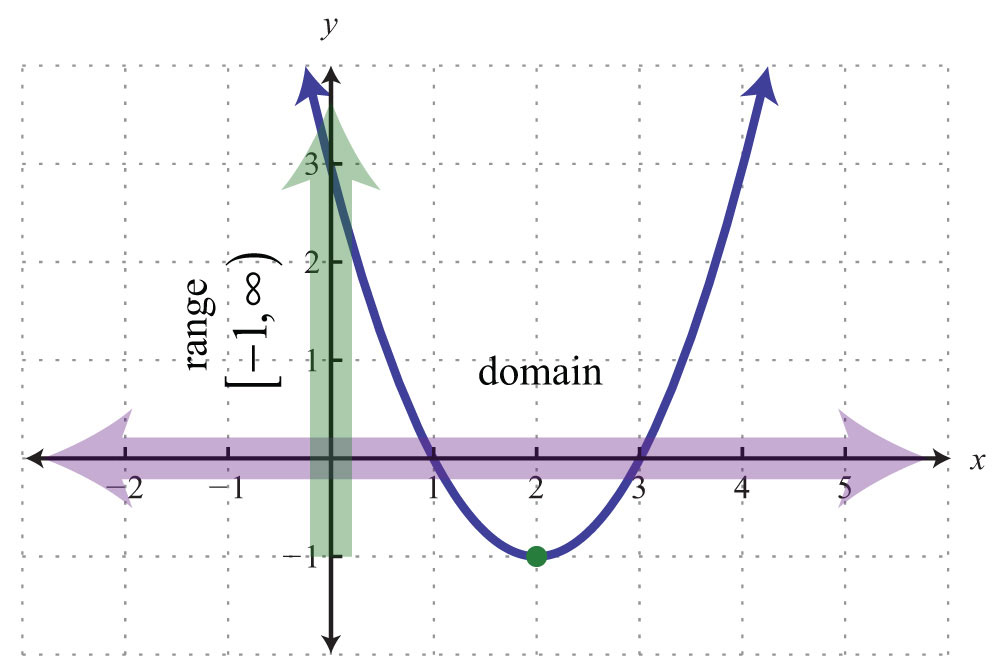
Answer: Domain: R = (−∞, ∞); range: [−1, ∞)
Example 9: The height in feet of a projectile is given by the function , where t represents the time in seconds after launch. What is the maximum height reached by the projectile?
Solution: Here , and the parabola opens downward. Therefore, the y-value of the vertex determines the maximum height. Begin by finding the x-value of the vertex:

The maximum height will occur in 9/4 = 2¼ seconds. Substitute this time into the function to determine the height attained.

Answer: The maximum height of the projectile is 81 feet.
Finding the Vertex by Completing the Square
In this section, we demonstrate an alternate approach for finding the vertex. Any quadratic equation can be rewritten in the form

In this form, the vertex is (h, k).
Example 10: Determine the vertex: .
Solution: When the equation is in this form, we can read the vertex directly from the equation.

Here h = 3 and k = 1.
Answer: The vertex is (3, 1).
Example 11: Determine the vertex: .
Solution: Rewrite the equation as follows before determining h and k.

Here h = −3 and k = −2.
Answer: The vertex is (−3, −2).
Often the equation is not given in this form. To obtain this form, complete the square.
Example 12: Rewrite in form and determine the vertex: .
Solution: Begin by making room for the constant term that completes the square.

The idea is to add and subtract the value that completes the square, , and then factor. In this case, add and subtract .

Adding and subtracting the same value within an expression does not change it. Doing so is equivalent to adding 0. Once the equation is in this form, we can easily determine the vertex.

Here h = −2 and k = 5.
Answer: The vertex is (−2, 5).
If there is a leading coefficient other than 1, then we must first factor out the leading coefficient from the first two terms of the trinomial.
Example 13: Rewrite in form and determine the vertex: .
Solution: Since a = 2, factor this out of the first two terms in order to complete the square. Leave room inside the parentheses to add a constant term.

Now use −2 to determine the value that completes the square. In this case, . Add and subtract 1 and factor as follows:
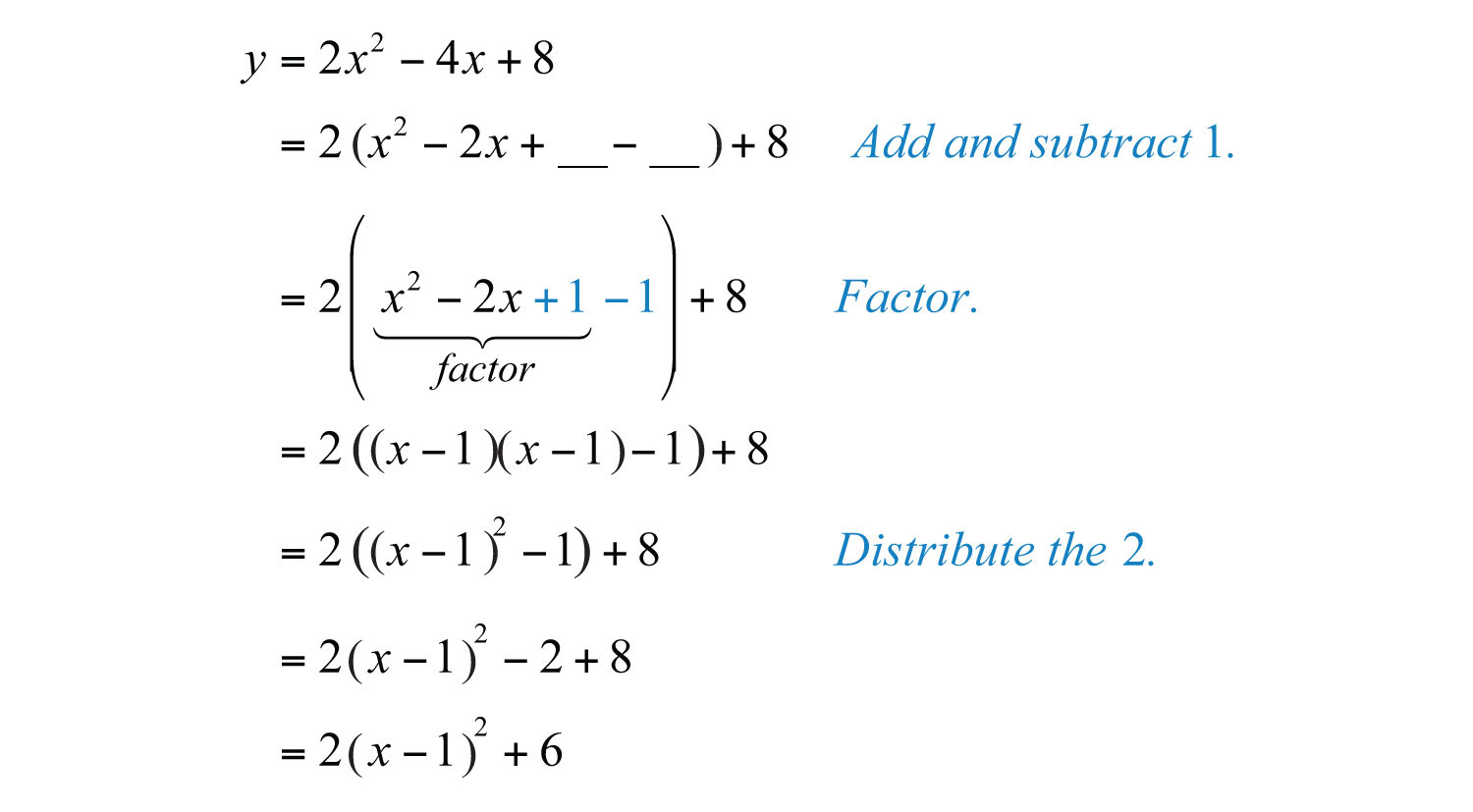
In this form, we can easily determine the vertex.

Here h = 1 and k = 6.
Answer: The vertex is (1, 6).
Try this! Rewrite in form and determine the vertex: .
Answer: ; vertex: (−3, 21)
Video Solution
(click to see video)Key Takeaways
- The graph of any quadratic equation , where a, b, and c are real numbers and , is called a parabola.
- When graphing parabolas, find the vertex and y-intercept. If the x-intercepts exist, find those as well. Also, be sure to find ordered pair solutions on either side of the line of symmetry, .
- Use the leading coefficient, a, to determine if a parabola opens upward or downward. If a is positive, then it opens upward. If a is negative, then it opens downward.
- The vertex of any parabola has an x-value equal to . After finding the x-value of the vertex, substitute it into the original equation to find the corresponding y-value. This y-value is a maximum if the parabola opens downward, and it is a minimum if the parabola opens upward.
- The domain of a parabola opening upward or downward consists of all real numbers. The range is bounded by the y-value of the vertex.
- An alternate approach to finding the vertex is to rewrite the quadratic equation in the form . When in this form, the vertex is (h, k) and can be read directly from the equation. To obtain this form, take and complete the square.
Topic Exercises
Part A: The Graph of Quadratic Equations
Does the parabola open upward or downward? Explain.
1.
2.
3.
4.
5.
6.
Determine the x- and y-intercepts.
7.
8.
9.
10.
11.
12.
13.
14.
15.
16.
Find the vertex and the line of symmetry.
17.
18.
19.
20.
21.
22.
Graph. Find the vertex and the y-intercept. In addition, find the x-intercepts if they exist.
23.
24.
25.
26.
27.
28.
29.
30.
31.
32.
33.
34.
35.
36.
37.
38.
39.
40.
41.
42.
43.
44.
45.
46.
47.
48.
49.
50.
Part B: Maximum or Minimum
Determine the maximum or minimum y-value.
51.
52.
53.
54.
55.
56.
57.
58.
59.
60.
Given the following quadratic functions, determine the domain and range.
61.
62.
63.
64.
65. The height in feet reached by a baseball tossed upward at a speed of 48 feet/second from the ground is given by the function , where t represents time in seconds. What is the baseball’s maximum height and how long will it take to attain that height?
66. The height of a projectile launched straight up from a mound is given by the function , where t represents seconds after launch. What is the maximum height?
67. The profit in dollars generated by producing and selling x custom lamps is given by the function . What is the maximum profit?
68. The revenue in dollars generated from selling a particular item is modeled by the formula , where x represents the number of units sold. What number of units must be sold to maximize revenue?
69. The average number of hits to a radio station website is modeled by the formula , where t represents the number of hours since 8:00 a.m. At what hour of the day is the number of hits to the website at a minimum?
70. The value in dollars of a new car is modeled by the formula , where t represents the number of years since it was purchased. Determine the minimum value of the car.
71. The daily production costs in dollars of a textile manufacturing company producing custom uniforms is modeled by the formula , where x represents the number of uniforms produced.
a. How many uniforms should be produced to minimize the daily production costs?
b. What is the minimum daily production cost?
72. The area of a certain rectangular pen is given by the formula , where w represents the width in feet. Determine the width that produces the maximum area.
Part C: Vertex by Completing the Square
Determine the vertex.
73.
74.
75.
76.
77.
78.
Rewrite in form and determine the vertex.
79.
80.
81.
82.
83.
84.
85.
86.
Graph.
87.
88.
89.
90.
91.
92.
93.
94.
95.
96.
97.
98.
99.
100.
101.
102.
Part D: Discussion Board
103. Write down your plan for graphing a parabola on an exam. What will you be looking for and how will you present your answer? Share your plan on the discussion board.
104. Why is any parabola that opens upward or downward a function? Explain to a classmate how to determine the domain and range.
Answers
1: Upward
3: Downward
5: Downward
7: x-intercepts: (−6, 0), (2, 0); y-intercept: (0, −12)
9: x-intercepts: (−3, 0), (1/2, 0); y-intercept: (0, −3)
11: x-intercepts: (−1, 0), (2/5, 0); y-intercept: (0, 2)
13: x-intercepts: (−5/2, 0), (5/2, 0); y-intercept: (0, −25)
15: x-intercepts: none; y-intercept: (0, 1)
17: Vertex: (5, −9); line of symmetry:
19: Vertex: (3/2, 2); line of symmetry:
21: Vertex: (0, −1); line of symmetry:
23:
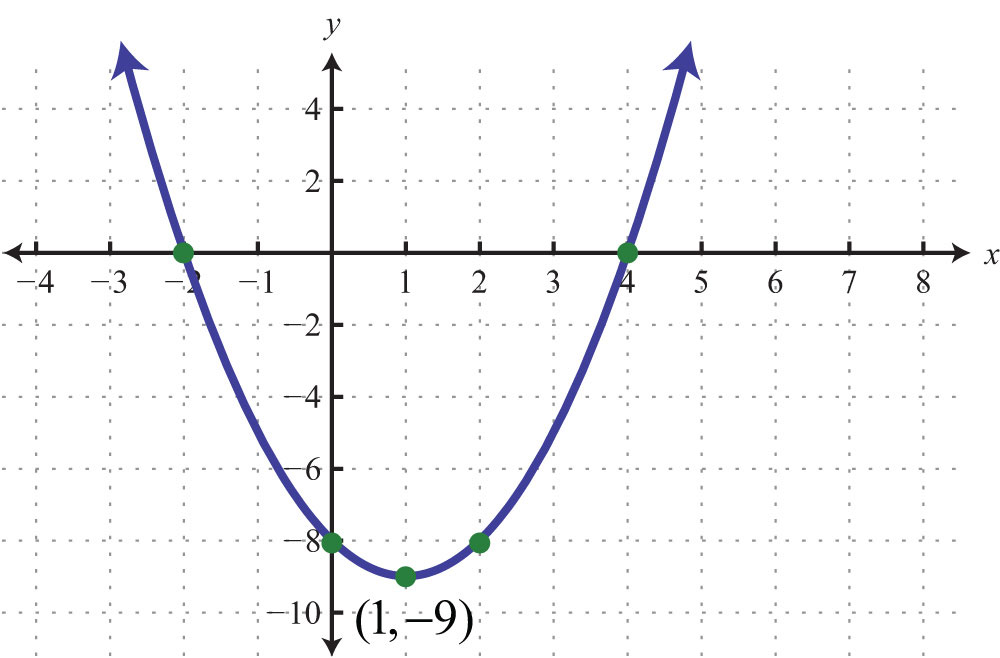
25:
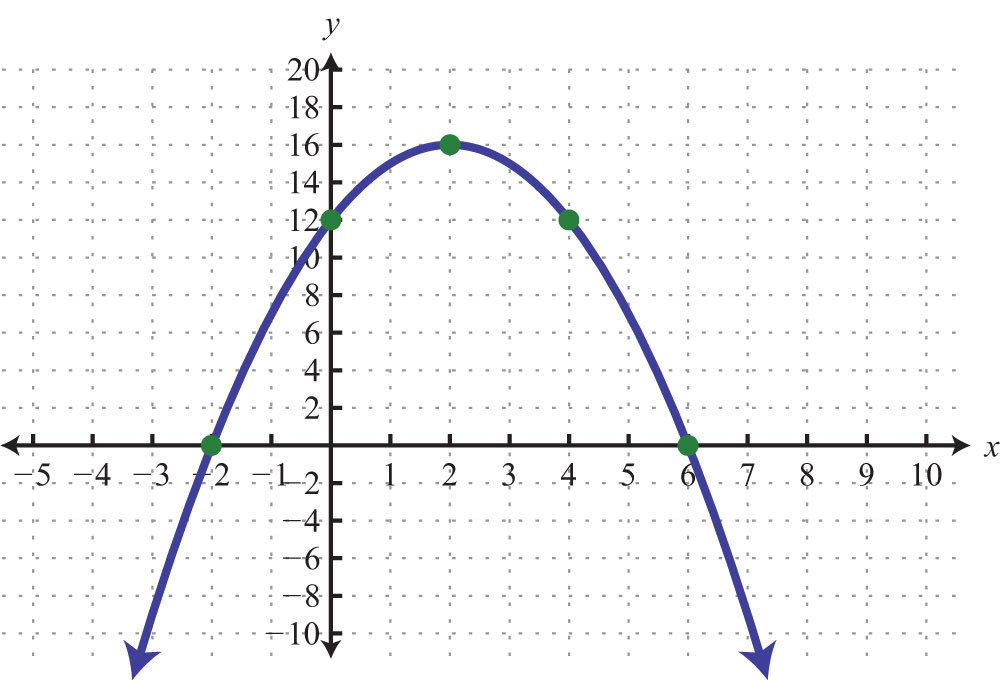
27:
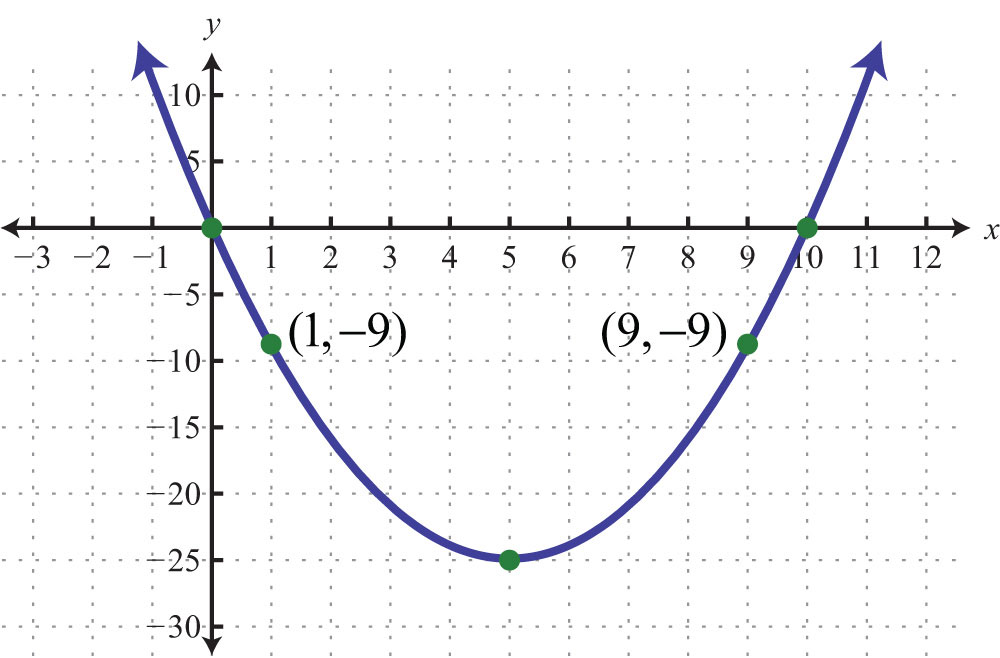
29:
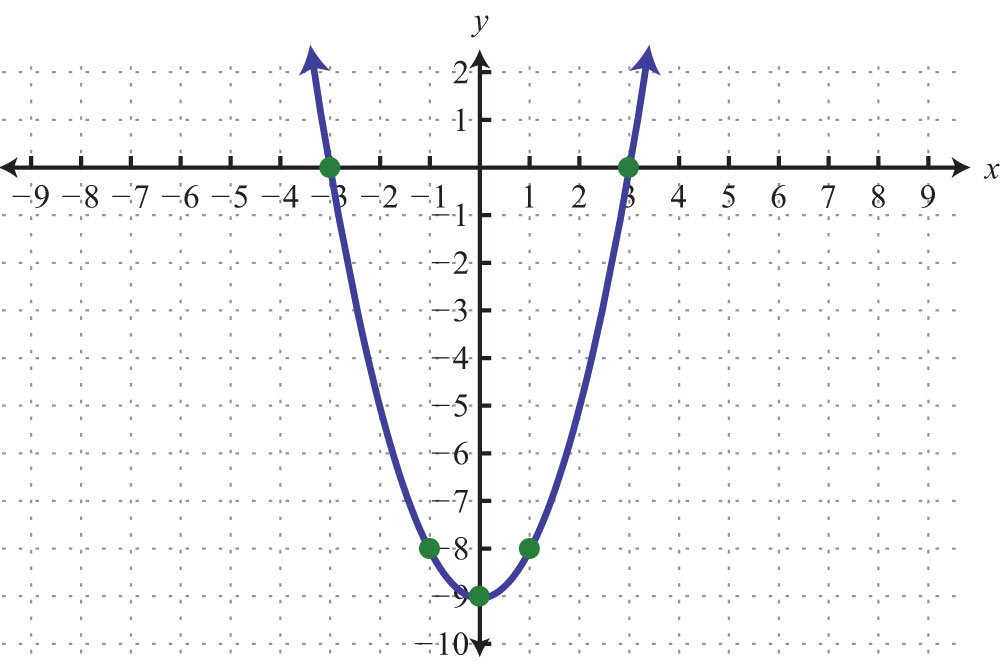
31:
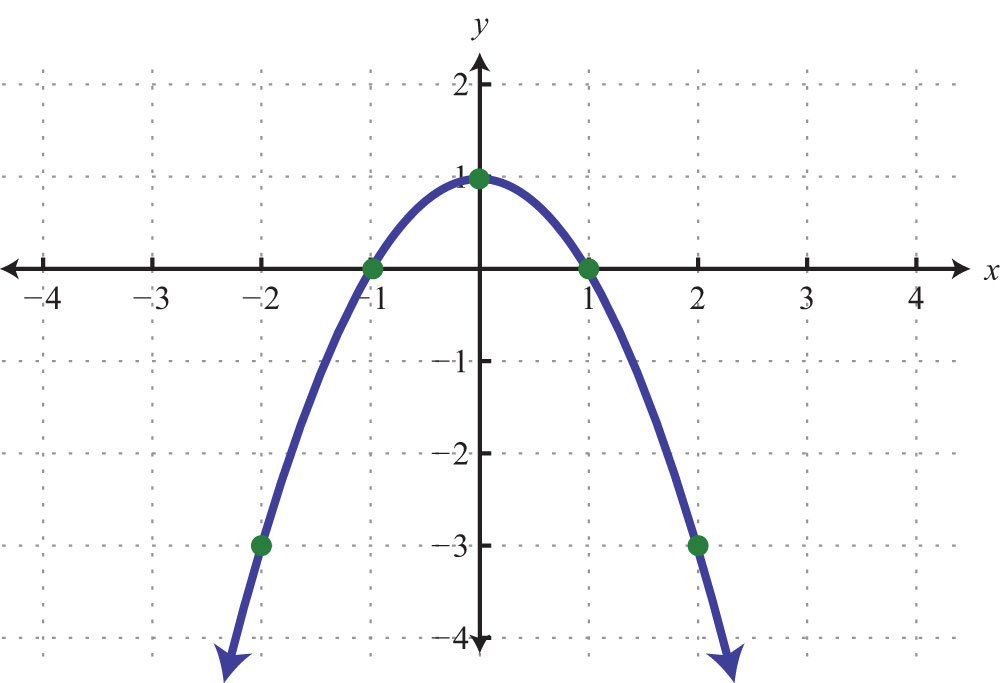
33:
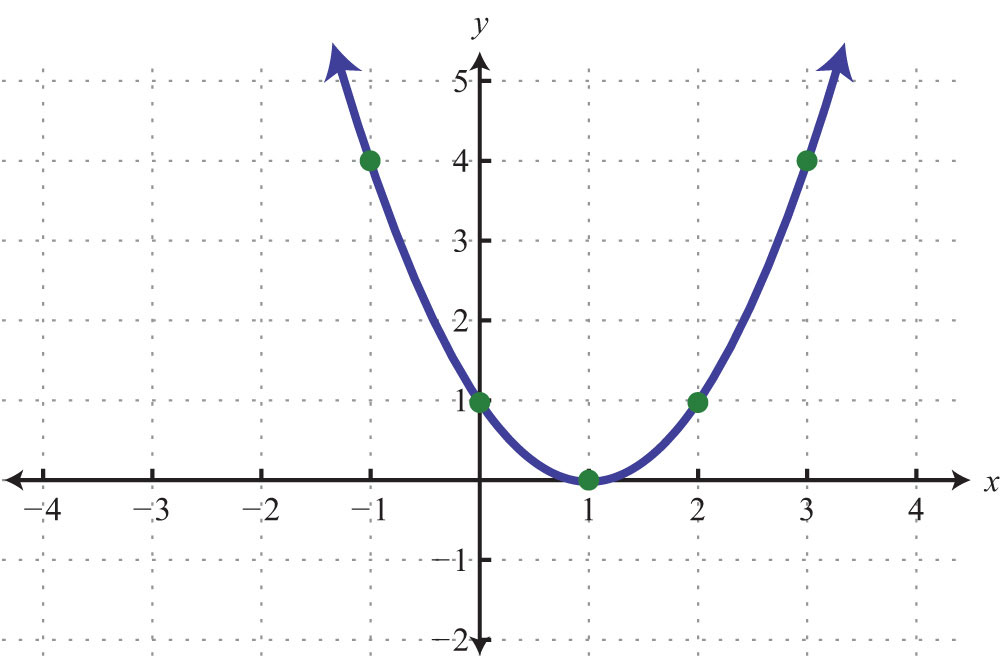
35:
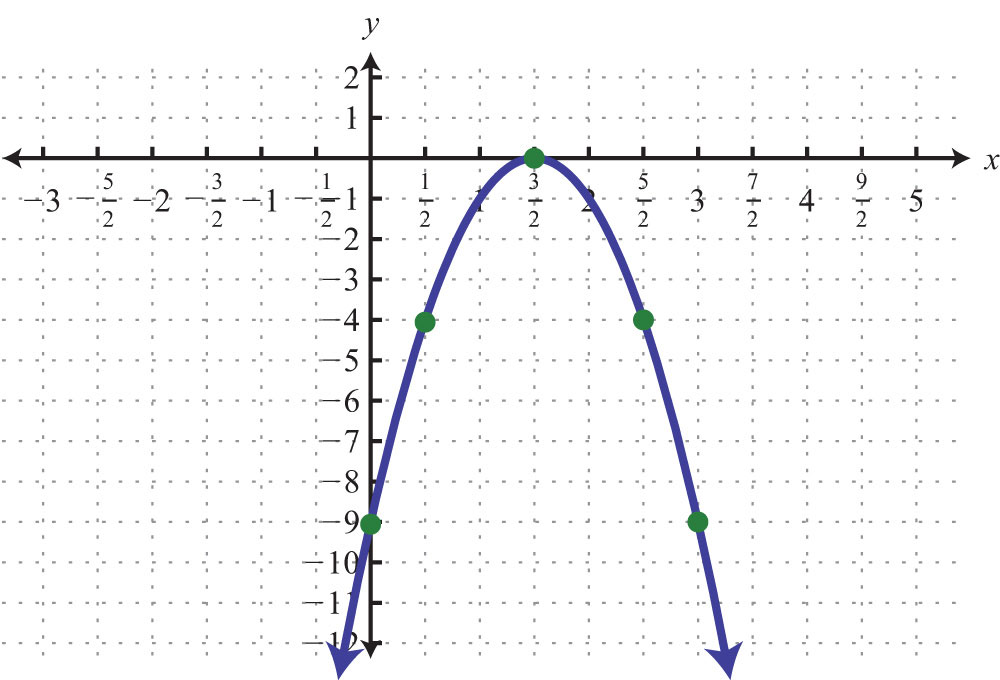
37:
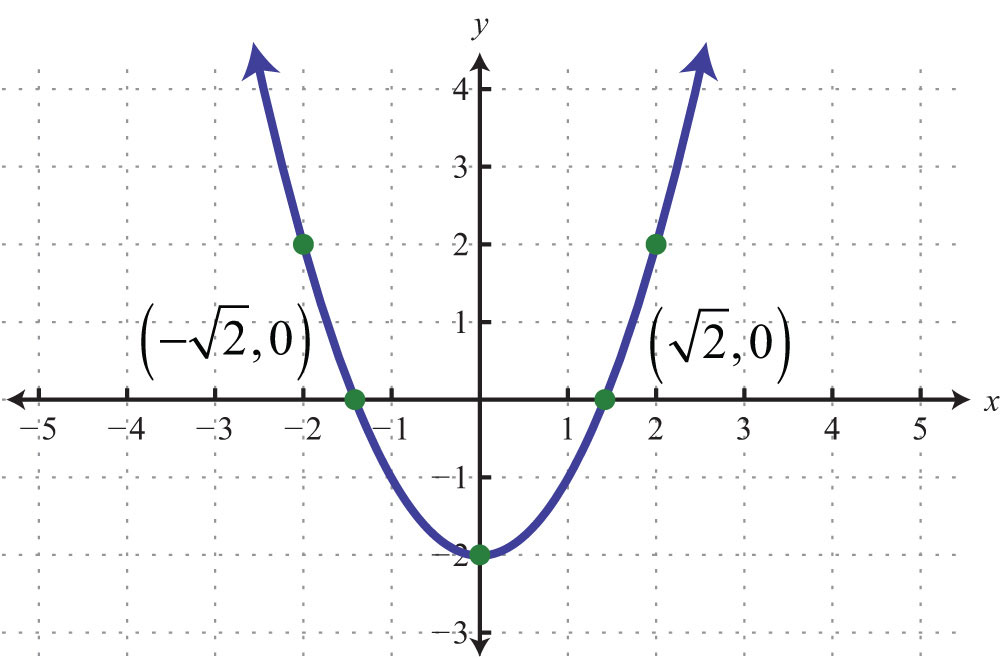
39:
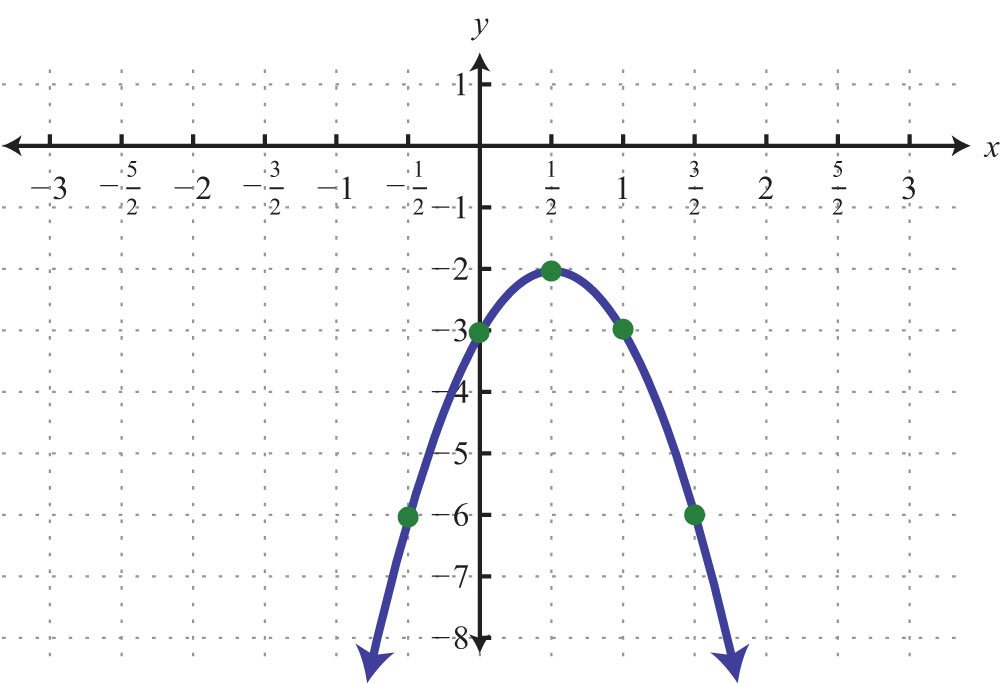
41:
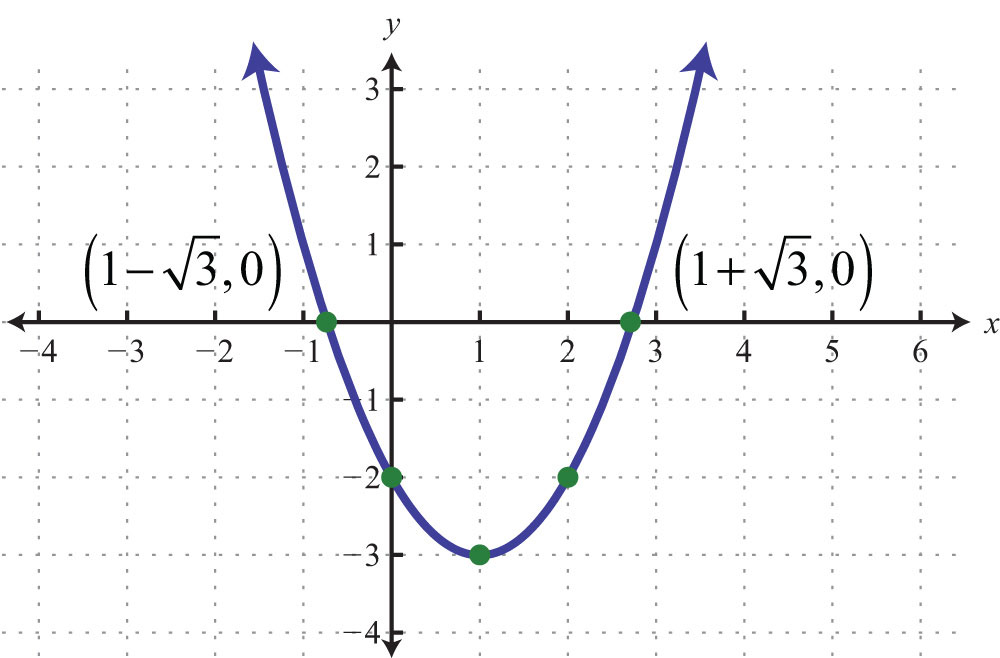
43:

45:
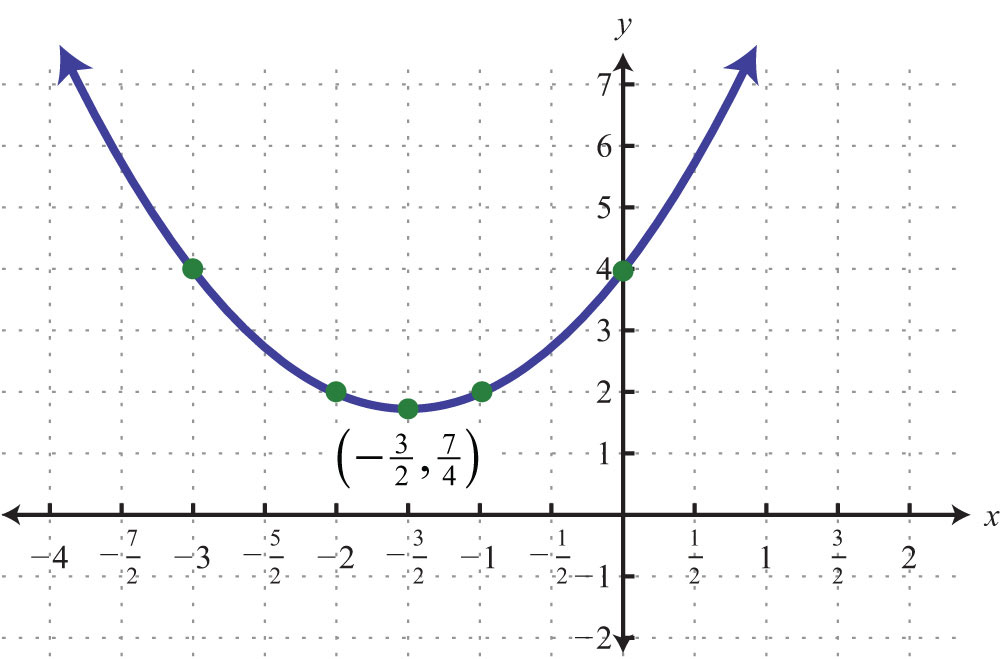
47:
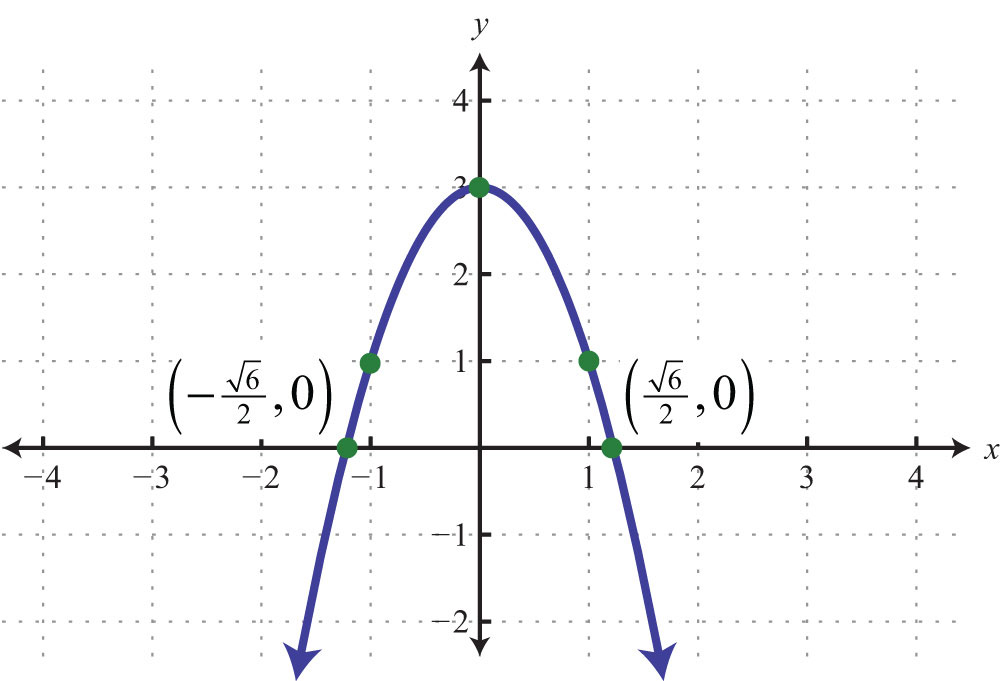
49:
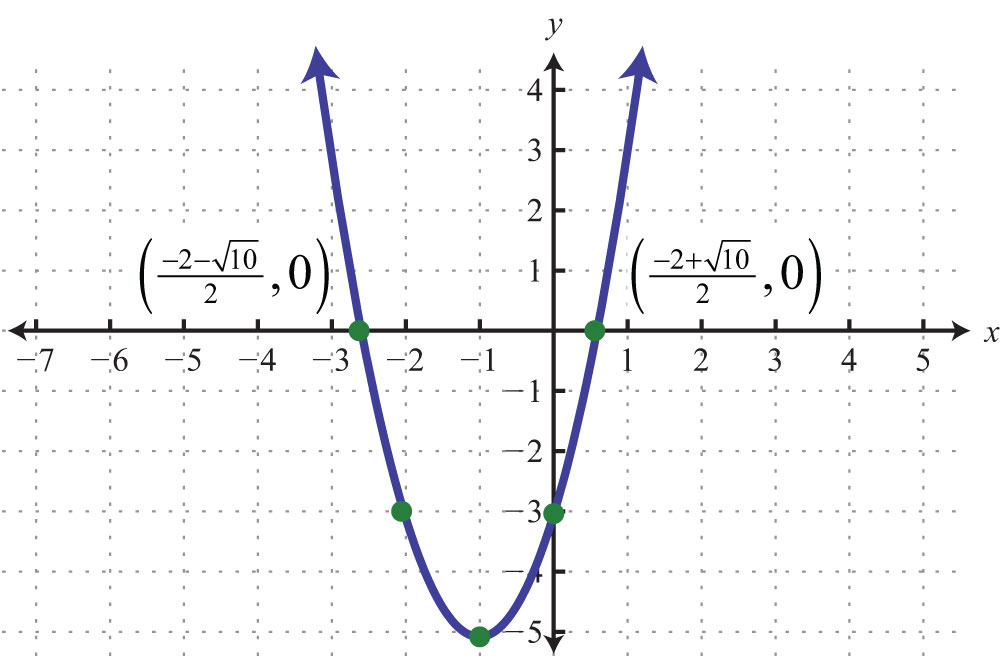
51: Maximum: y = 10
53: Minimum: y = 4
55: Maximum: y = 0
57: Maximum: y = 10
59: Minimum: y = −10/3
61: Domain: R; range:
63: Domain: R; range:
65: The maximum height of 36 feet occurs after 1.5 seconds.
67: $4,000
69: 12:00 p.m.
71: a. 500 uniforms; b. $5,000
73: (5, 3)
75: (−1, 6)
77: (−8, −1)
79: ; vertex: (7, −25)
81: ; vertex: (−2, −16)
83: ; vertex: (3, −21)
85: ; vertex: (8, 81)
87:
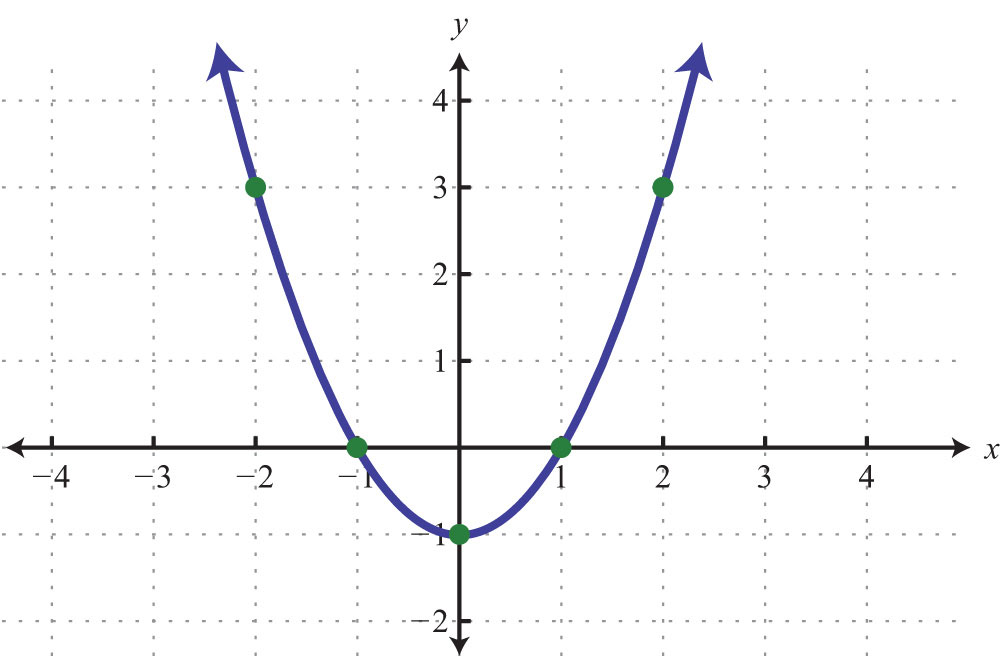
89:
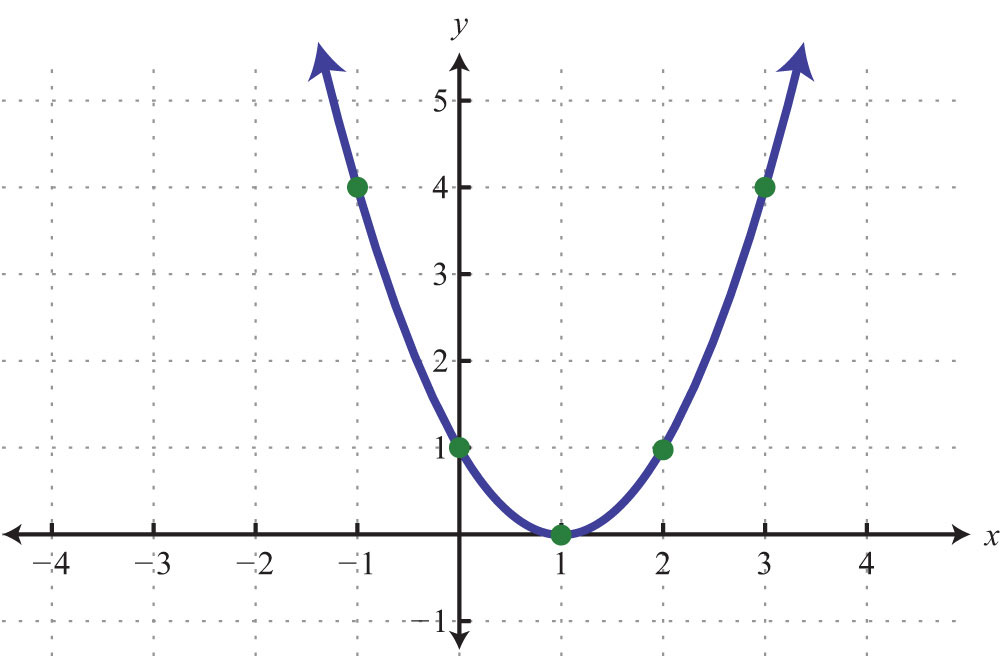
91:
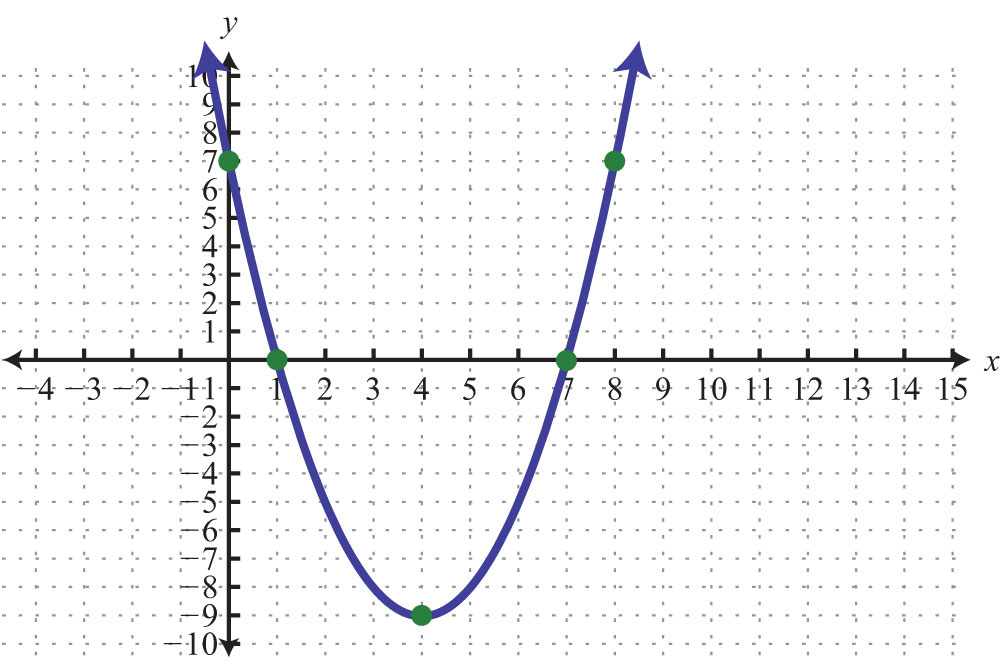
93:
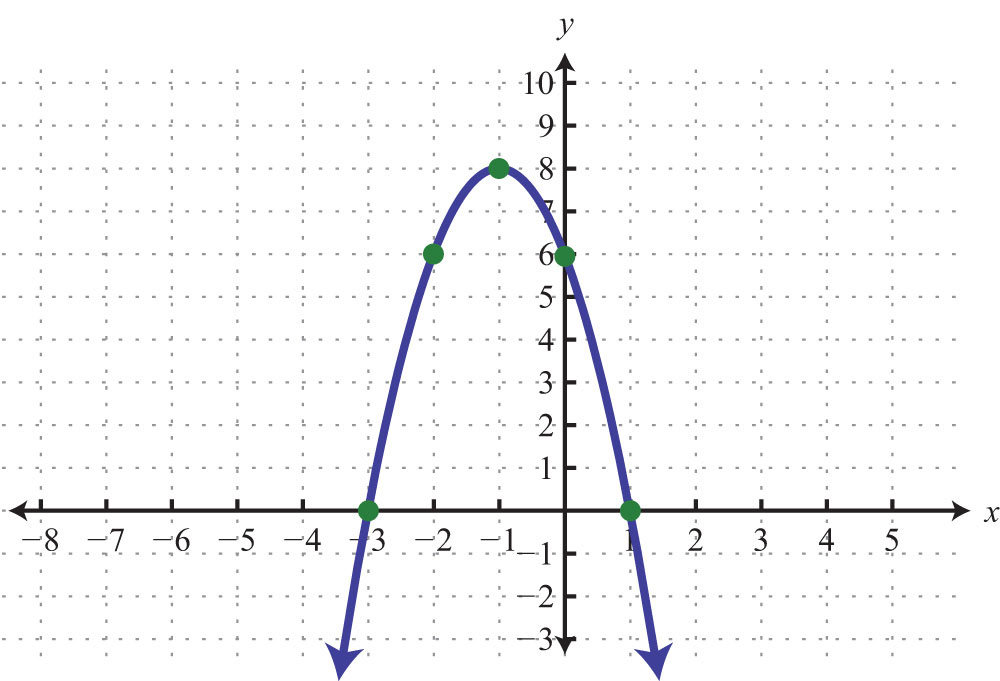
95:
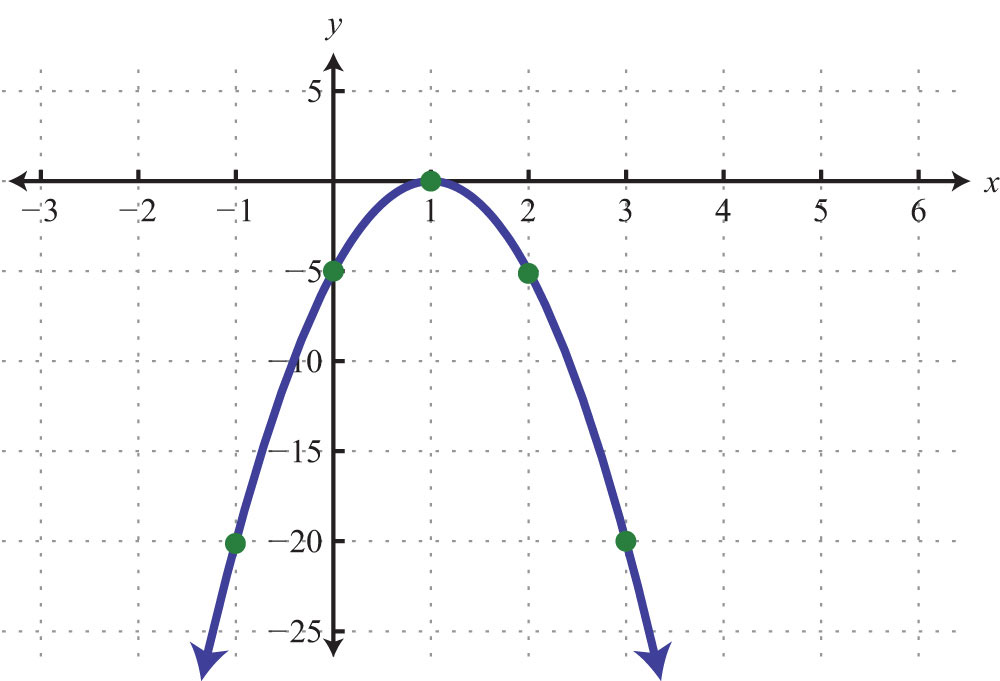
97:
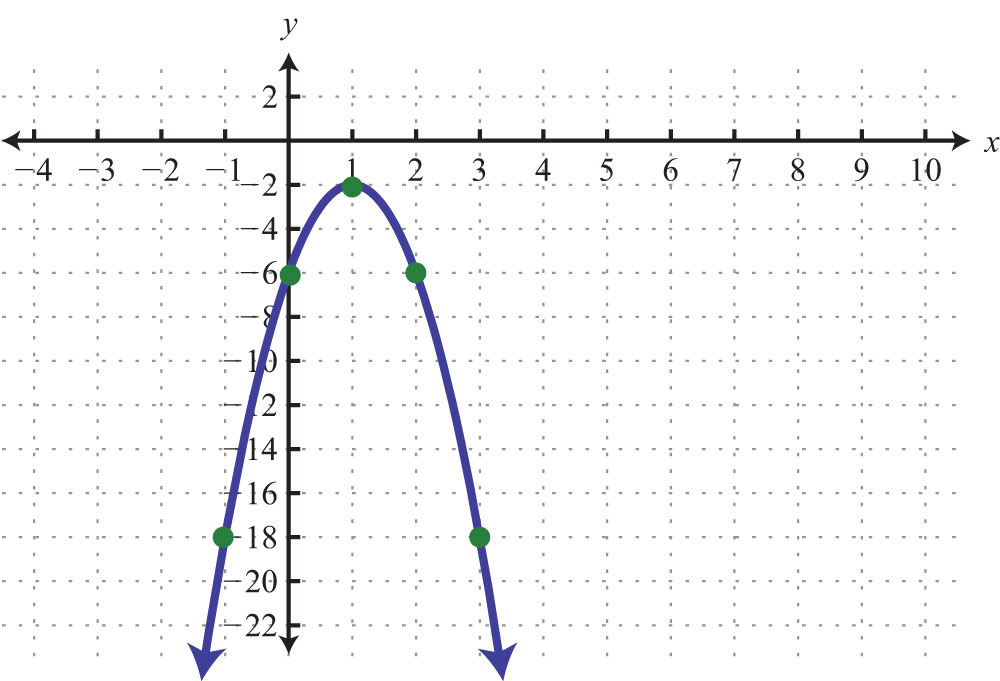
99:
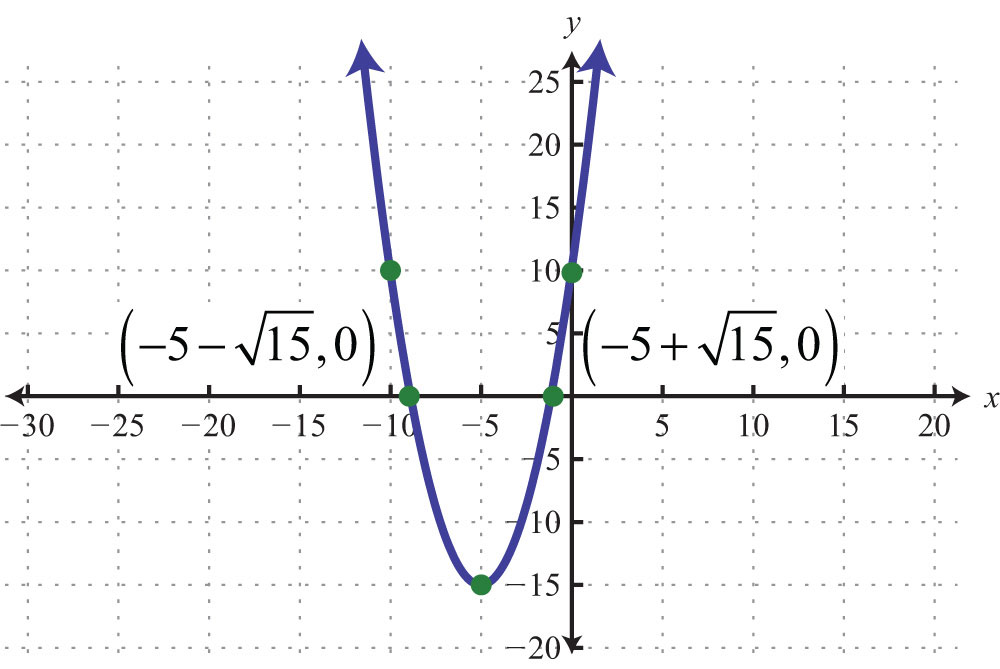
101:
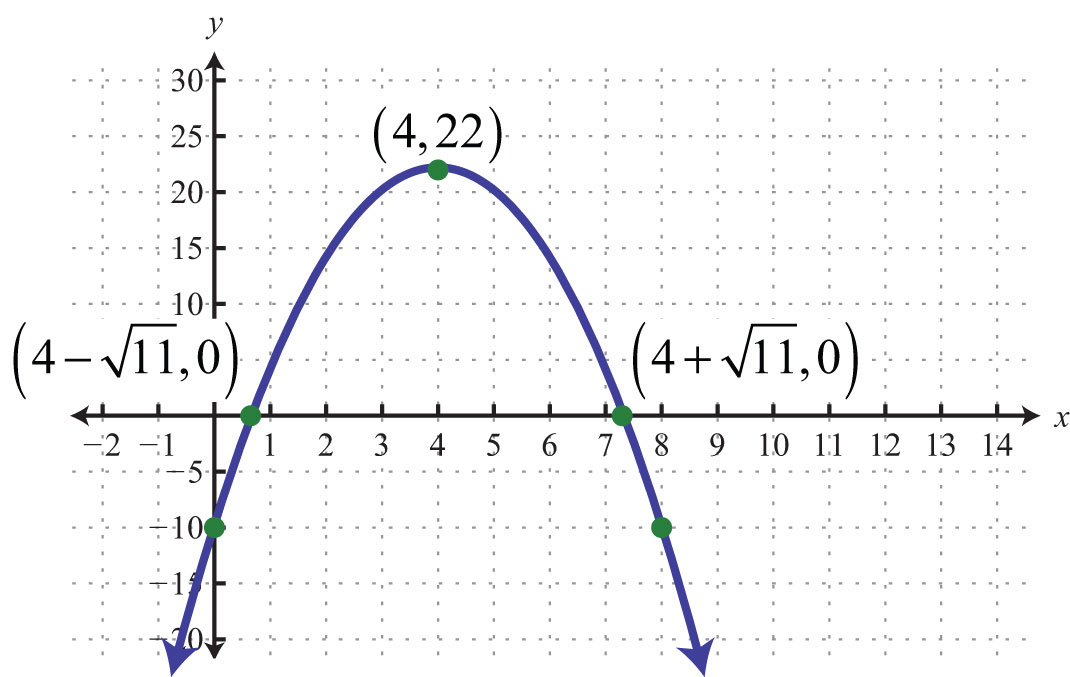
9.6 Introduction to Complex Numbers and Complex Solutions
Learning Objectives
- Perform operations with complex numbers.
- Solve quadratic equations with complex solutions.
Introduction to Complex Numbers
Up to this point, the square root of a negative number has been left undefined. For example, we know that is not a real a number.

There is no real number that when squared results in a negative number. We begin the resolution of this issue by defining the imaginary unitDefined as and ., i, as the square root of −1.

To express a square root of a negative number in terms of the imaginary unit i, we use the following property, where a represents any nonnegative real number:

With this we can write

If , then we would expect that 3i squared equals −9:

Therefore, the square root of any negative real number can be written in terms of the imaginary unit. Such numbers are often called imaginary numbersThe square roots of any negative real numbers..
Example 1: Rewrite in terms of the imaginary unit i.
a.
b.
c.
Solution:
a.
b.
c.
Notation Note
When an imaginary number involves a radical, place i in front of the radical. Consider the following:
Since multiplication is commutative, these numbers are equivalent. However, in the form , the imaginary unit i is often misinterpreted to be part of the radicand. To avoid this confusion, it is a best practice to place the i in front of the radical and use
A complex numberNumbers of the form , where a and b are real numbers. is any number of the form

where a and b are real numbers. Here a is called the real partThe real number a of a complex number . and b is called the imaginary partThe real number b of a complex number .. For example, is a complex number with a real part, 3, and an imaginary part, −4. It is important to note that any real number is also a complex number. For example, the real number 5 is also a complex number because it can be written as with a real part of 5 and an imaginary part of 0. Hence the set of real numbers, denoted R, is a subset of the set of complex numbers, denoted C.
Adding and subtracting complex numbers is similar to adding and subtracting like terms. Add or subtract the real parts and then the imaginary parts.
Example 2: Add: .
Solution: Add the real parts and then add the imaginary parts.

Answer:
To subtract complex numbers, subtract the real parts and subtract the imaginary parts. This is consistent with the use of the distributive property.
Example 3: Subtract: .
Solution: Distribute the negative one and then combine like terms.

Answer:
The distributive property also applies when multiplying complex numbers. Make use of the fact that to resolve the result into standard form: .
Example 4: Multiply: .
Solution: Begin by applying the distributive property.

Answer:
Example 5: Multiply: .
Solution:

Answer:
Given a complex number , its complex conjugateTwo complex numbers whose real parts are the same and imaginary parts are opposite. If given , then its complex conjugate is . is . We next explore the product of complex conjugates.
Example 6: Multiply: .
Solution:

Answer: 25
In general, the product of complex conjugatesThe real number that results from multiplying complex conjugates: follows:

Note that the result does not involve the imaginary unit; hence the result is real. This leads us to the very useful property:

To divide complex numbers, we apply the technique used to rationalize the denominator. Multiply the numerator and denominator (dividend and divisor) by the conjugate of the denominator. The result can then be resolved into standard form, .
Example 7: Divide: .
Solution: In this example, the conjugate of the denominator is . Multiply by 1 in the form .
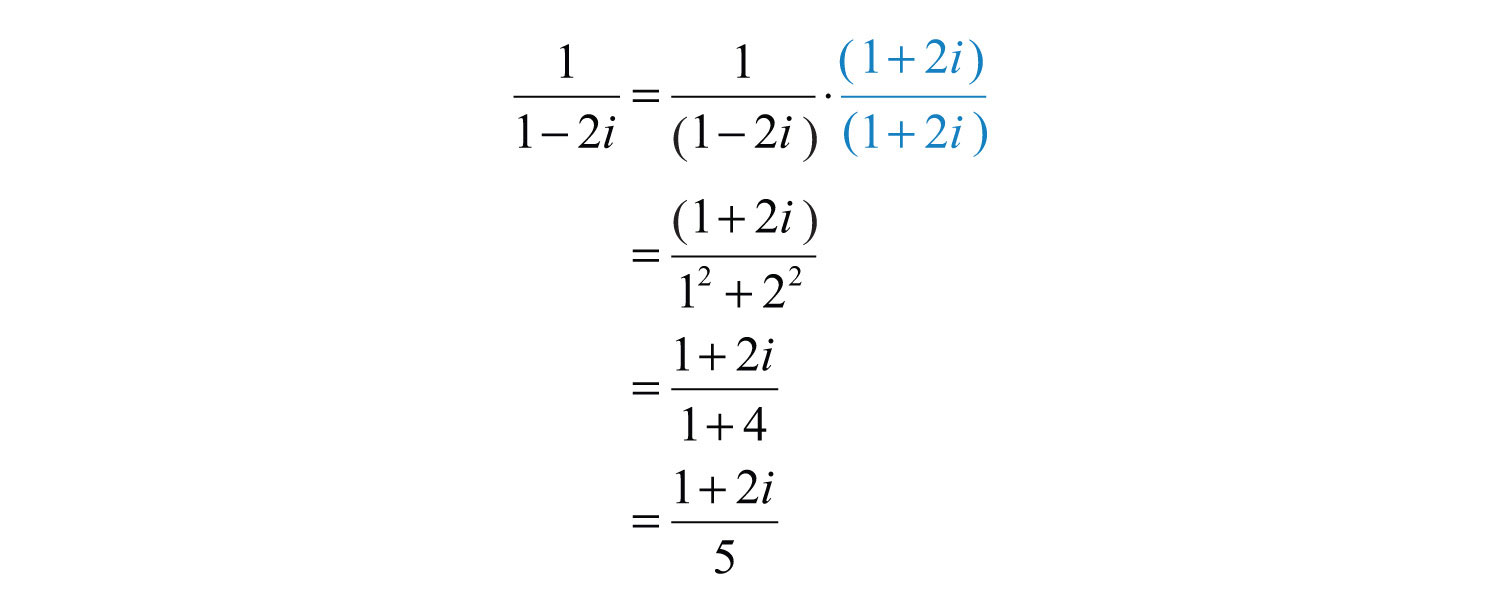
To express this complex number in standard form, write each term over the common denominator 5.

Answer:
Example 8: Divide: .
Solution:
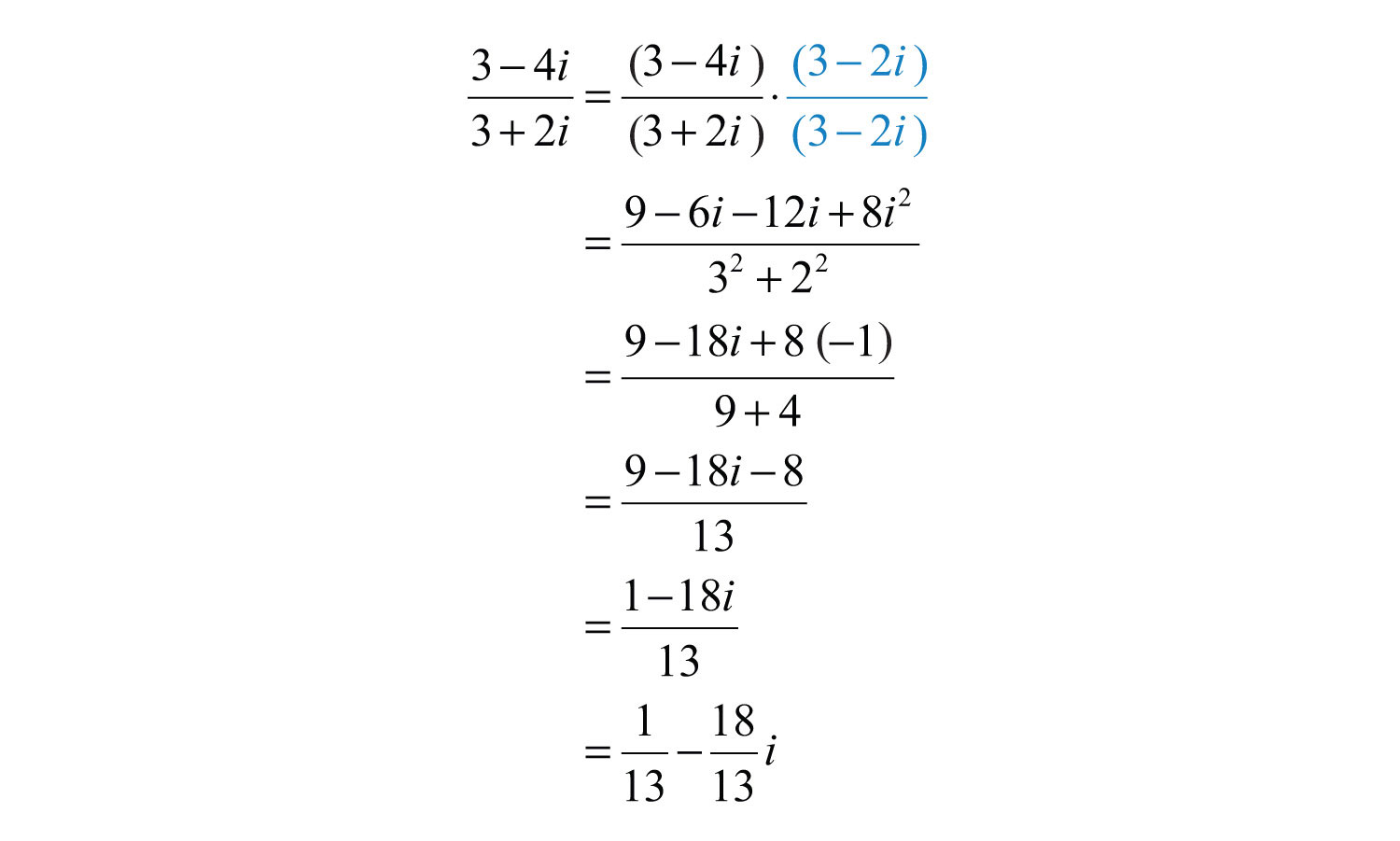
Answer:
Try this! Divide: .
Answer:
Video Solution
(click to see video)Quadratic Equations with Complex Solutions
Now that complex numbers are defined, we can complete our study of solutions to quadratic equations. Often solutions to quadratic equations are not real.
Example 9: Solve using the quadratic formula:
Solution: Begin by identifying a, b, and c. Here

Substitute these values into the quadratic formula and then simplify.
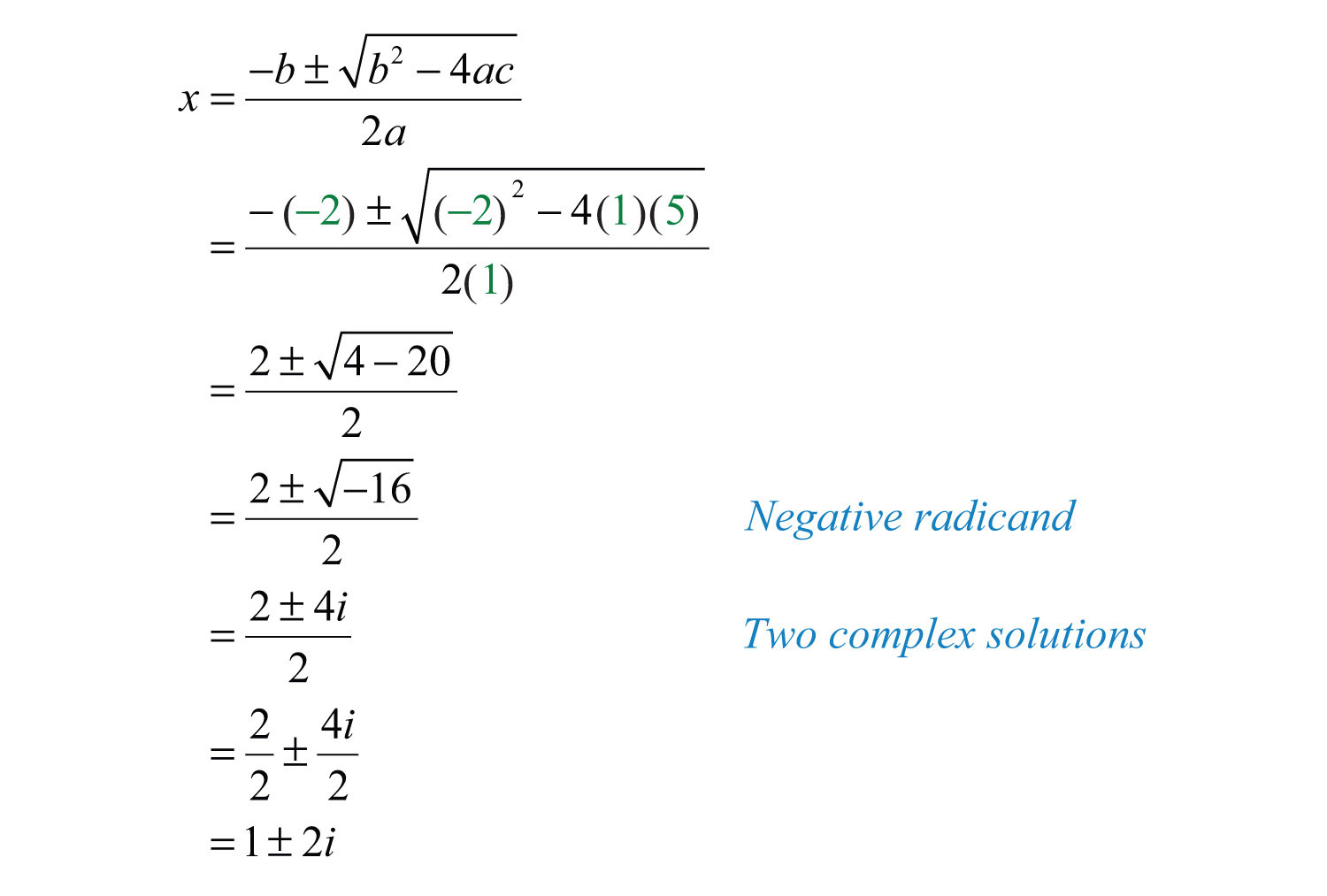
Check these solutions by substituting them into the original equation.
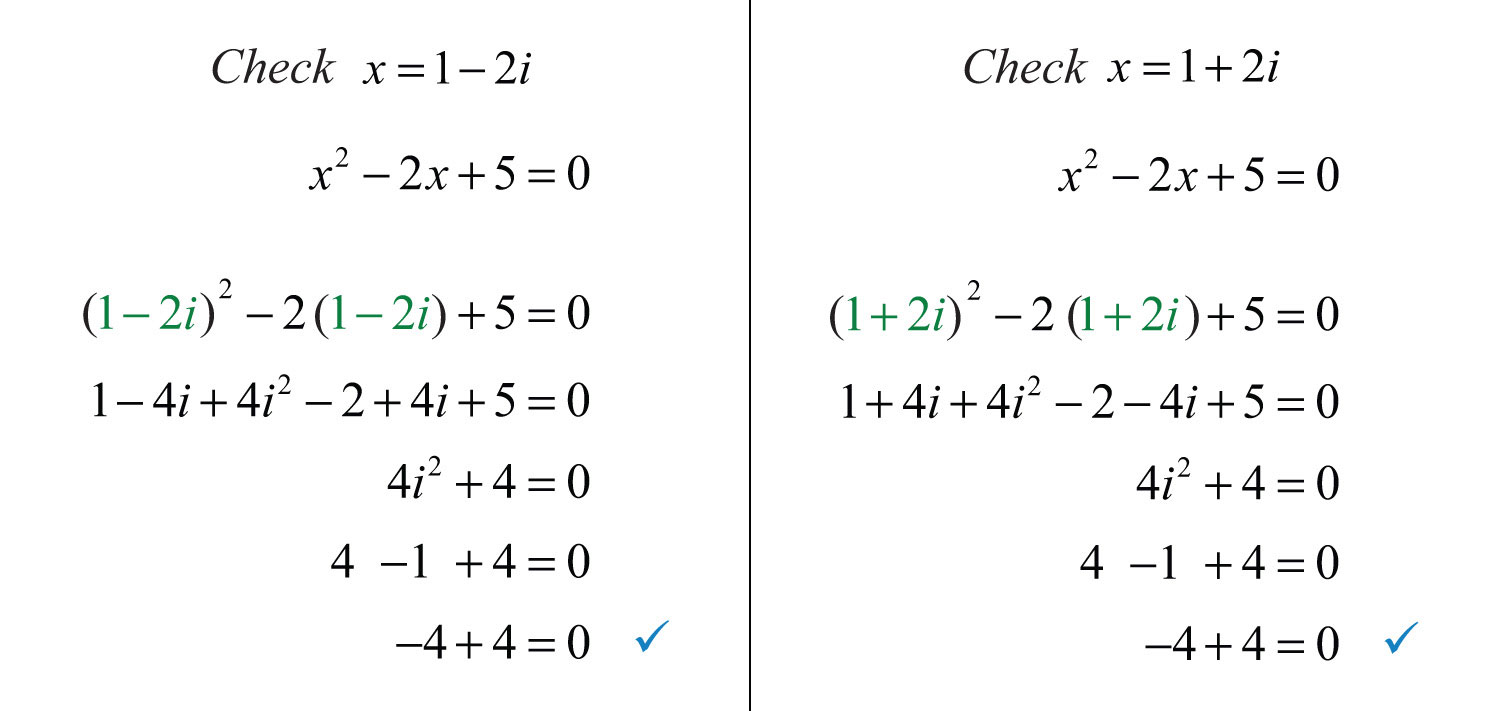
Answer: The solutions are and .
The equation may not be given in standard form. The general steps for solving using the quadratic formula are outlined in the following example.
Example 10: Solve: .
Solution:
Step 1: Write the quadratic equation in standard form.

Step 2: Identify a, b, and c for use in the quadratic formula. Here

Step 3: Substitute the appropriate values into the quadratic formula and then simplify.
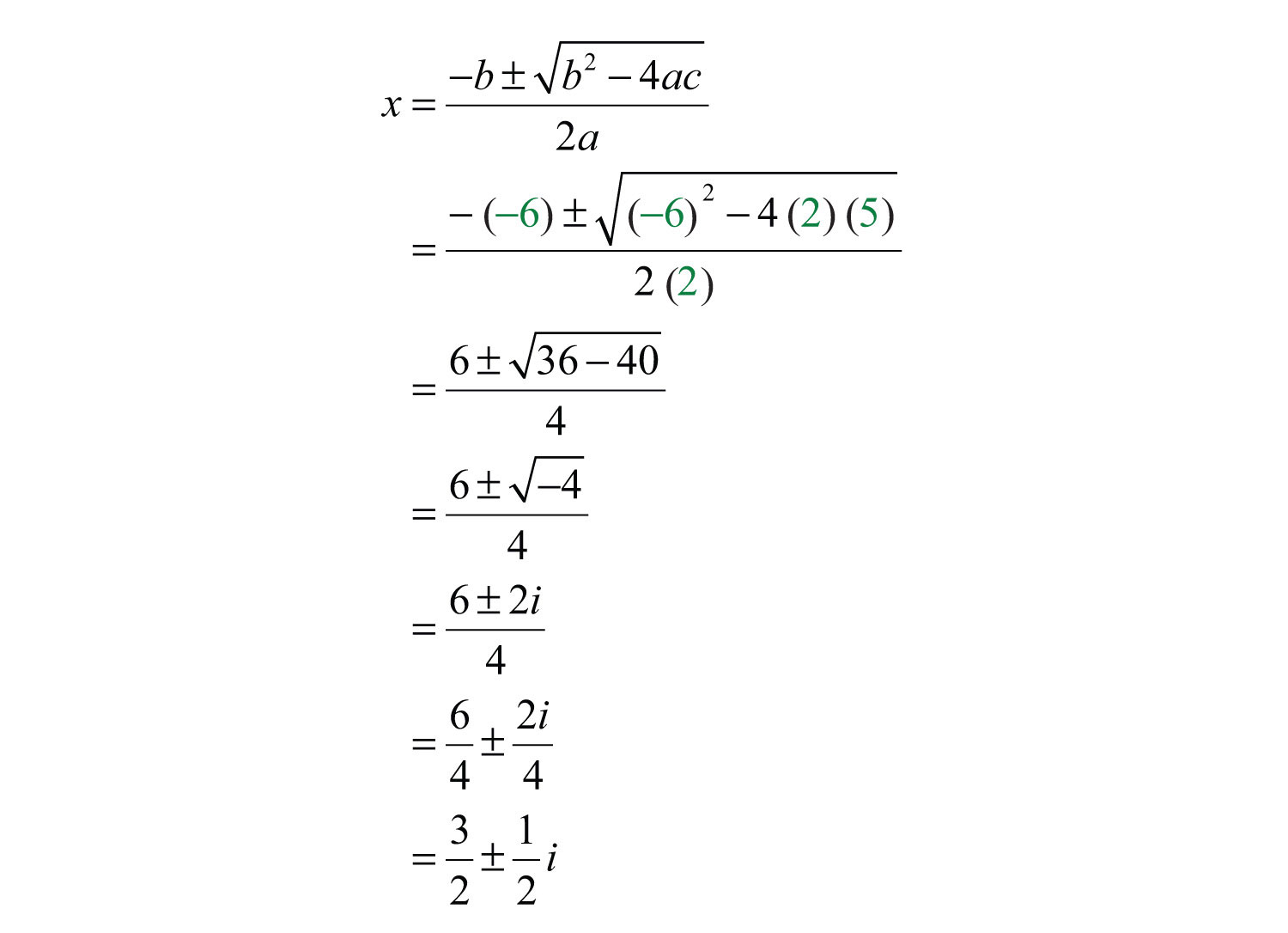
Answer: The solution is . The check is optional.
Example 11: Solve: .
Solution: Begin by rewriting the equation in standard form.

Here , , and . Substitute these values into the quadratic formula.
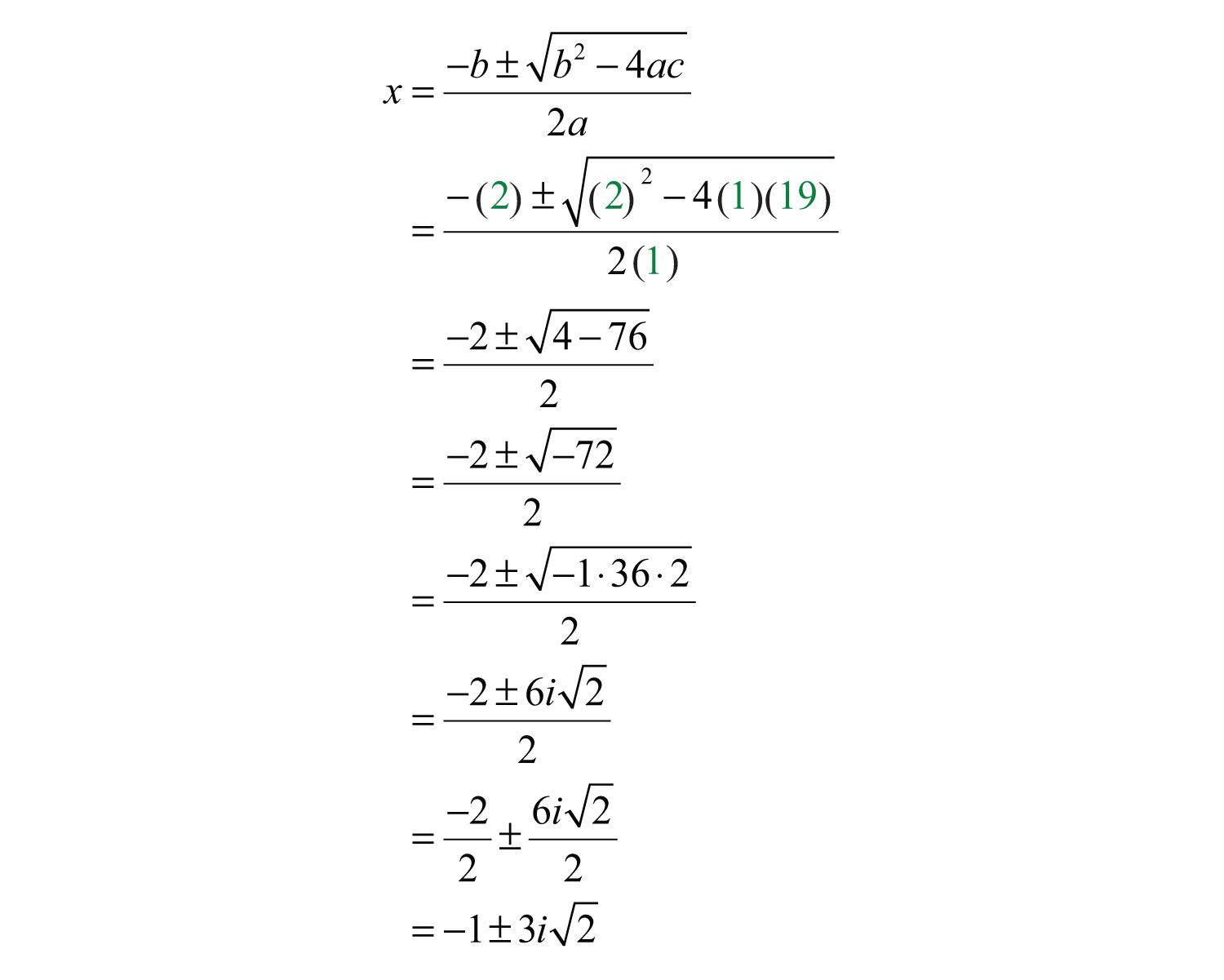
Answer: The solutions are and .
Notation Note
Consider the following:
Both numbers are equivalent and is in standard form, where the real part is −1 and the imaginary part is . However, this number is often expressed as , even though this expression is not in standard form. Again, this is done to avoid the possibility of misinterpreting the imaginary unit as part of the radicand.
Try this! Solve: .
Answer:
Video Solution
(click to see video)Key Takeaways
- The result of adding, subtracting, multiplying, and dividing complex numbers is a complex number.
- Use complex numbers to describe solutions to quadratic equations that are not real.
Topic Exercises
Part A: Introduction to Complex Numbers
Rewrite in terms of i.
1.
2.
3.
4.
5.
6.
7.
8.
9.
10.
Perform the operations.
11.
12.
13.
14.
15.
16.
17.
18.
19.
20.
21.
22.
23.
24.
25.
26.
27.
28.
29.
30.
31.
32.
33.
34.
35.
36.
37.
38.
39.
40.
41.
42.
43.
44.
45.
46.
Part B: Complex Roots
Solve by extracting the roots and then solve by using the quadratic formula. Check answers.
47.
48.
49.
50.
51.
52.
53.
54.
55.
56.
Solve using the quadratic formula.
57.
58.
59.
60.
61.
62.
63.
64.
65.
66.
67.
68.
69.
70.
71.
72.
73.
74.
75.
76.
77.
78.
79.
80.
81.
82.
83.
84.
85.
86.
87.
88.
89.
90.
Part C: Discussion Board
91. Explore the powers of i. Share your discoveries on the discussion board.
92. Research and discuss the rich history of imaginary numbers.
93. Research and discuss real-world applications involving complex numbers.
Answers
1:
3:
5:
7:
9:
11:
13:
15:
17:
19:
21:
23:
25:
27:
29:
31:
33: 20
35:
37:
39:
41:
43:
45:
47:
49:
51:
53:
55:
57:
59:
61:
63:
65:
67:
69:
71:
73:
75:
77:
79:
81:
83:
85:
87:
89:
9.7 Review Exercises and Sample Exam
Review Exercises
Extracting Square Roots
Solve by extracting the roots.
1.
2.
3.
4.
5.
6.
7.
8.
9.
10.
11.
12.
Find a quadratic equation in standard form with the given solutions.
13.
14.
Completing the Square
Complete the square.
15.
16.
Solve by completing the square.
17.
18.
19.
20.
21.
22.
23.
24.
25.
26.
27.
28.
29.
30.
Quadratic Formula
Identify the coefficients a, b, and c used in the quadratic formula. Do not solve.
31.
32.
33.
34.
Use the quadratic formula to solve the following.
35.
36.
37.
38.
39.
40.
41.
42.
43.
44.
45.
46.
Guidelines for Solving Quadratic Equations and Applications
Use the discriminant to determine the number and type of solutions.
47.
48.
49.
50.
Solve using any method.
51.
52.
53.
54.
55.
56.
57.
58.
59.
60.
61.
62.
Set up an algebraic equation and use it to solve the following.
63. The length of a rectangle is 2 inches less than twice the width. If the area measures 25 square inches, then find the dimensions of the rectangle. Round off to the nearest hundredth.
64. An 18-foot ladder leaning against a building reaches a height of 17 feet. How far is the base of the ladder from the wall? Round to the nearest tenth of a foot.
65. The value in dollars of a new car is modeled by the function , where t represents the number of years since it was purchased. Determine the age of the car when its value is $22,000.
66. The height in feet reached by a baseball tossed upward at a speed of 48 feet/second from the ground is given by the function , where t represents time in seconds. At what time will the baseball reach a height of 16 feet?
Graphing Parabolas
Determine the x- and y-intercepts.
67.
68.
69.
70.
Find the vertex and the line of symmetry.
71.
72.
73.
74.
Graph. Find the vertex and the y-intercept. In addition, find the x-intercepts if they exist.
75.
76.
77.
78.
79.
80.
81.
82.
Determine the maximum or minimum y-value.
83.
84.
85.
86.
87. The value in dollars of a new car is modeled by the function , where t represents the number of years since it was purchased. Determine the age of the car when its value is at a minimum.
88. The height in feet reached by a baseball tossed upward at a speed of 48 feet/second from the ground is given by the function , where t represents time in seconds. What is the maximum height of the baseball?
Introduction to Complex Numbers and Complex Solutions
Rewrite in terms of i.
89.
90.
91.
92.
Perform the operations.
93.
94.
95.
96.
Solve.
97.
98.
99.
100.
101.
102.
Sample Exam
Solve by extracting the roots.
1.
2.
Solve by completing the square.
3.
4.
Solve using the quadratic formula.
5.
6.
Solve using any method.
7.
8.
9.
10.
Set up an algebraic equation and solve.
11. The length of a rectangle is twice its width. If the diagonal measures centimeters, then find the dimensions of the rectangle.
12. The height in feet reached by a model rocket launched from a platform is given by the function , where t represents time in seconds after launch. At what time will the rocket reach 451 feet?
Graph. Find the vertex and the y-intercept. In addition, find the x-intercepts if they exist.
13.
14.
15.
16.
17. Determine the maximum or minimum y-value: .
18. Determine the x- and y-intercepts: .
19. Determine the domain and range: .
20. The height in feet reached by a model rocket launched from a platform is given by the function , where t represents time in seconds after launch. What is the maximum height attained by the rocket.
21. A bicycle manufacturing company has determined that the weekly revenue in dollars can be modeled by the formula , where n represents the number of bicycles produced and sold. How many bicycles does the company have to produce and sell in order to maximize revenue?
22. Rewrite in terms of i: .
23. Divide: .
Solve.
24.
25.
Review Exercises Answers
1: ±16
3:
5:
7: 2, 8
9:
11:
13:
15:
17:
19:
21:
23: −3/2, 1
25:
27:
29:
31: , , and
33: , , and
35:
37:
39:
41:
43: −12, 24
45:
47: Two real solutions
49: One real solution
51: −10, 6
53: ±1/5
55:
57:
59: −4, 3
61:
63: Length: 6.14 inches; width: 4.07 inches
65: It is worth $22,000 new and when it is 24 years old.
67: x-intercepts: (−3, 0), (1/2, 0); y-intercept: (0, −3)
69: x-intercepts: none; y-intercept: (0, 2)
71: Vertex: (3, −8); line of symmetry:
73: Vertex: (−3/2, −13/4); line of symmetry:
75:
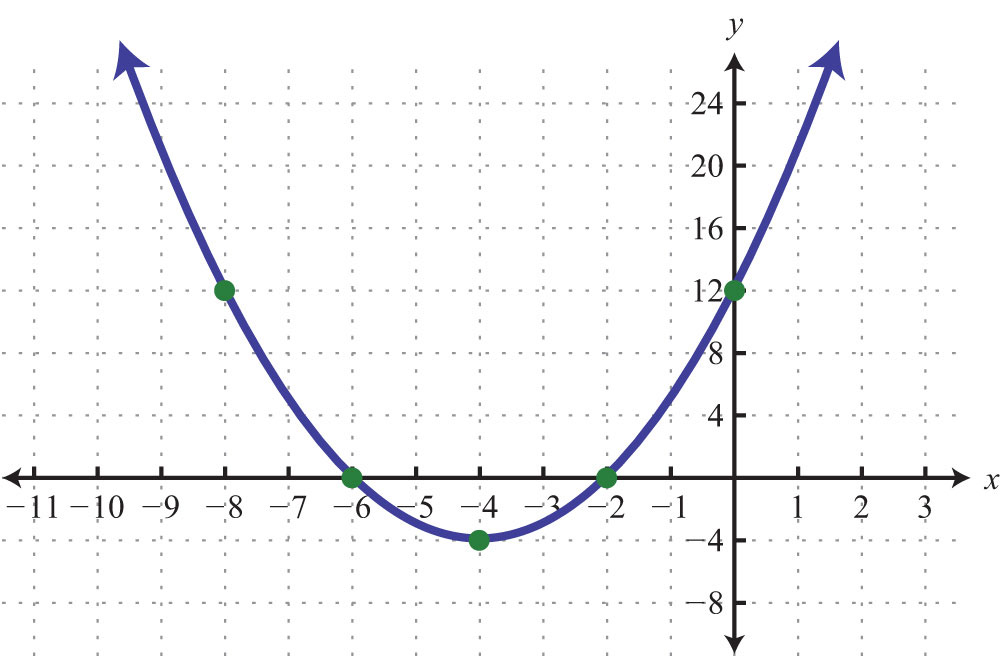
77:
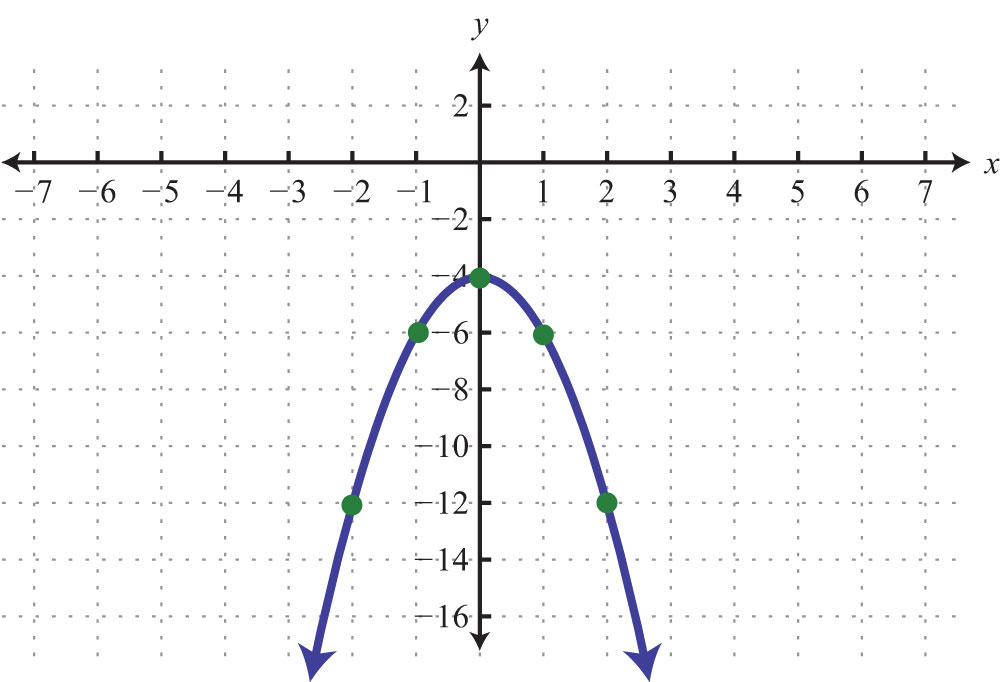
79:
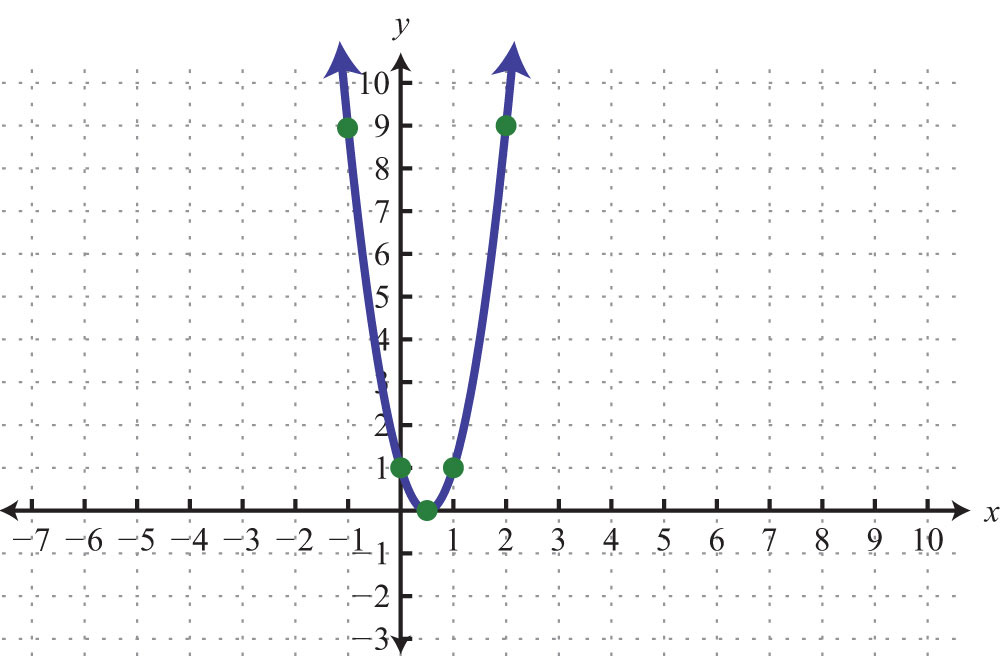
81:
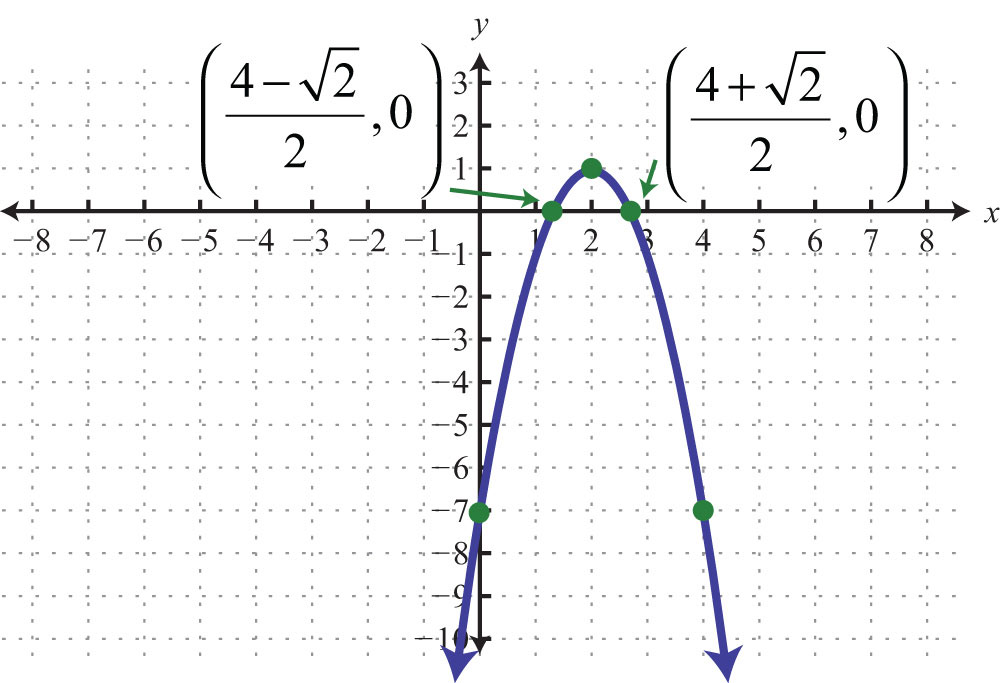
83: Minimum: y = −24
85: Maximum: y = 9/5
87: The car will have a minimum value 12 years after it is purchased.
89:
91:
93:
95:
97:
99:
101:
Sample Exam Answers
1:
3:
5: −1, 3/2
7: −6/5, 0
9: −2, −1
11: Length: 12 centimeters; width: 6 centimeters
13:
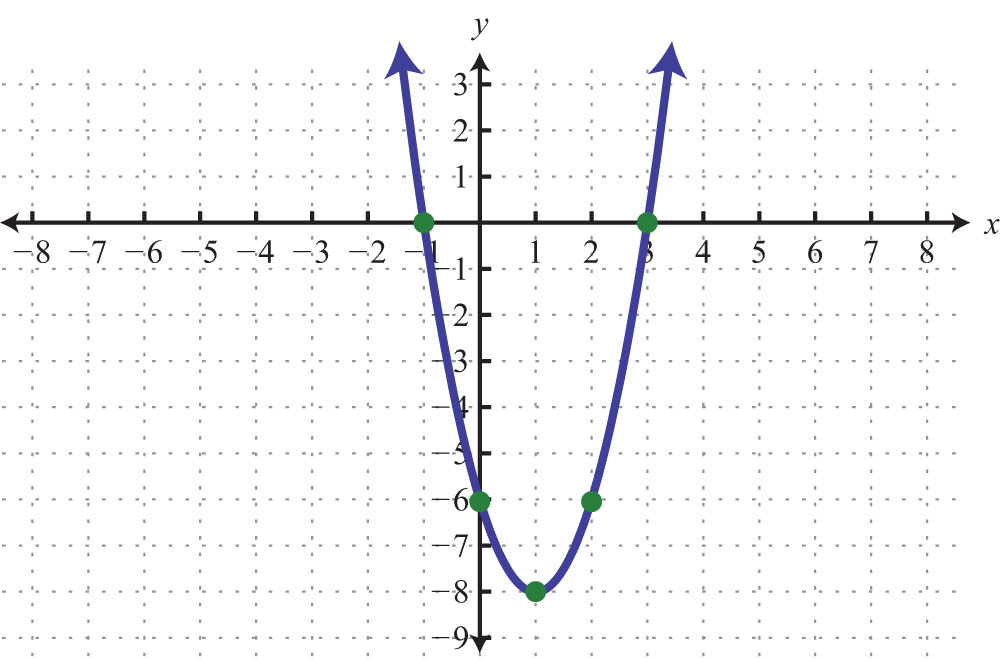
15:
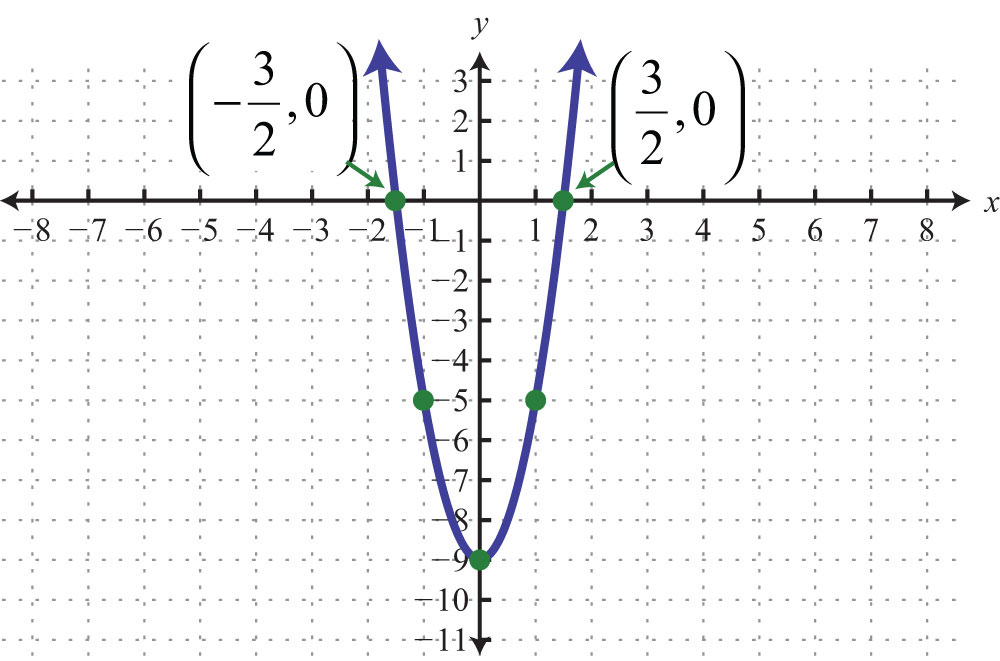
17: Maximum: y = −3
19: Domain: R; range:
21: To maximize revenue, the company needs to produce and sell 100 bicycles a week.
23:
25:




